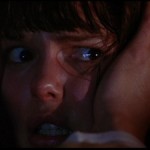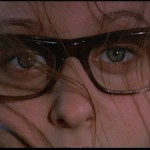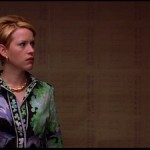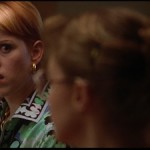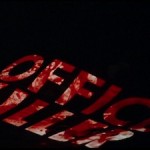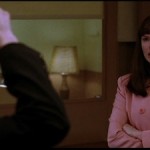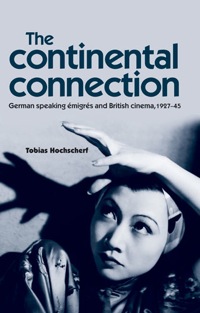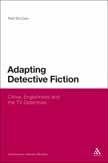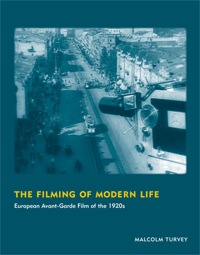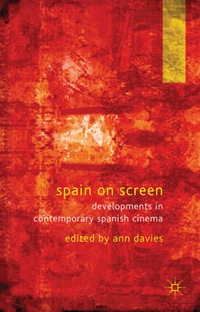Books
» ‘NEW: 2014 & 2013 & 2012 & 2011’
July 2014
Bangladesh’s Changing Mediascape: From State Control to Market Forces ed. Brian Shoesmith, Jude William Genilo, and MD Asiuzzaman (Intellect Books, distributed by University of Chicago Press)
n
June 2014
n
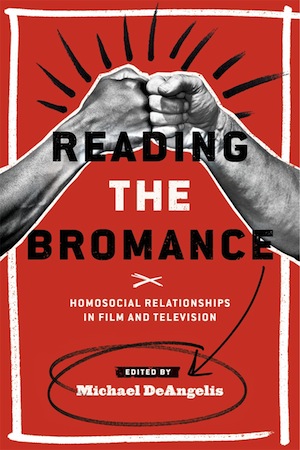 John Williams’s Film Music: Jaws, Star Wars, Raiders of the Lost Ark, and the Return of the Classical Hollywood Music Style by Emilio Audissino (University of Wisconsin Press). The neoclassicism of the composer, born 1932.
John Williams’s Film Music: Jaws, Star Wars, Raiders of the Lost Ark, and the Return of the Classical Hollywood Music Style by Emilio Audissino (University of Wisconsin Press). The neoclassicism of the composer, born 1932.
n
Reading the Bromance: Homosocial Relationships in Film and Television ed. Michael DeAngelis (Wayne State University Press). Essays on films (I Love You, Man, Superbad, Humpday, The Hangover…) and TV shows (Friends, Seinfeld, House…).
n
The Struggle for Form: Perspectives on Polish Avant-Garde Film, 1916-1989 ed. Kamila Kuc and Michael O’Pray (Wallflower Press, dist’d Columbia University Press). Essays on e.g. Franciszka and Stefan Themerson and the Polish Futurists.
n
Walter Ruttmann and the Cinema of Multiplicity: Avant-Garde, Advertising, Modernity by Michael Cowan (Amsterdam University Press, dist’d University of Chicago Press). An associate professor of German Studies and the Program in World Cinemas at McGill University, Canada, analyzes the work of the experimentalist and Nazi propagandist Walter Ruttmann whose Berlin: Symphony of a Great City appeared in 1927 and who later worked as an assistant to director Leni Riefenstahl during the production of Triumph of the Will. Cowan details the ideological and aesthetic shifts in Ruttman’s films, draws attention to neglected bodies of film material, and calls for study of the institutional and financial contexts of films commission, production, and distribution.
n
May 2014
n
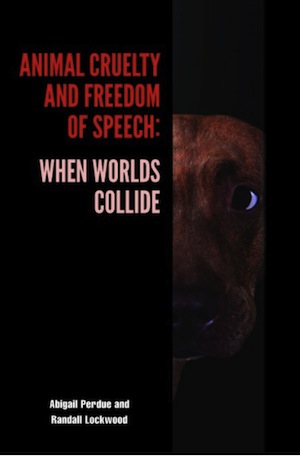 Animal Cruelty and Freedom of Speech: When Worlds Collide by Abigail Perdue and Randall Lockwood (Purdue University Press). A study of US v. Stevens, in which in April 2010 the U.S. Supreme Court determined the First Amendment status of videos of animal cruelty. That prompted Congress to pass, in December 2010, the Animal Crush Video Prohibition Act of 2010 which is also undergoing legal scrutiny. The Stevens case entailed several issues in government involvement in public morality, and reflected on judicial attitudes towards sexual deviance and dogfighting. The Stevens case arose from anti-cruelty investigators’ discovery in the 1990s of a lucrative market in “crush videos” in which people, seeking to gratify a sexual fetish, depicted small animals being slowly crushed to death. Stevens is one of only two animal-rights cases that the Supreme Court has heard, and the only one dealing with competing interests of free speech and animal cruelty. It arose from at the prosecution of Robert J. Stevens, who had compiled and sold videotapes showing dogfight and received a 37-month sentence under the 1999 law. Perdue, a lawyer and associate professor of law at Wake Forest University, and Lockwood, senior vice president for the American Society for the Prevention of Cruelty to Animals, consider issues arising from that case, and how they relate to broader issues of protections of animal welfare. The Stevens case involved the first conviction under a 1999 federal law that sought to end the making and sale of depictions of animals being harmed or killed for human’s entertainment.
Animal Cruelty and Freedom of Speech: When Worlds Collide by Abigail Perdue and Randall Lockwood (Purdue University Press). A study of US v. Stevens, in which in April 2010 the U.S. Supreme Court determined the First Amendment status of videos of animal cruelty. That prompted Congress to pass, in December 2010, the Animal Crush Video Prohibition Act of 2010 which is also undergoing legal scrutiny. The Stevens case entailed several issues in government involvement in public morality, and reflected on judicial attitudes towards sexual deviance and dogfighting. The Stevens case arose from anti-cruelty investigators’ discovery in the 1990s of a lucrative market in “crush videos” in which people, seeking to gratify a sexual fetish, depicted small animals being slowly crushed to death. Stevens is one of only two animal-rights cases that the Supreme Court has heard, and the only one dealing with competing interests of free speech and animal cruelty. It arose from at the prosecution of Robert J. Stevens, who had compiled and sold videotapes showing dogfight and received a 37-month sentence under the 1999 law. Perdue, a lawyer and associate professor of law at Wake Forest University, and Lockwood, senior vice president for the American Society for the Prevention of Cruelty to Animals, consider issues arising from that case, and how they relate to broader issues of protections of animal welfare. The Stevens case involved the first conviction under a 1999 federal law that sought to end the making and sale of depictions of animals being harmed or killed for human’s entertainment.
n
Animating Film Theory ed. Karen Beckman (Duke University Press). Essays on e.g. neglect of animation.
n
Avant-Garde Videogames: Playing With Technoculture by Brian Schrank (MIT Press). An assistant Professor at the College of Computing and Digital Media at DePaul University examines relationship among games, technology, culture, and art in avant-garde videogames that, for example, create new ways of making and playing games, opening circuits of play by, for example, revealing their own nature as games. To demonstrate novel strategies, he four varieties of avant-garde games: radical formal, which break up their flow of play so players can engage with their materiality, sensuality, and conventionality; radical political, which play with art and politics as well as fictions and everyday life; complicit formal, which treat videogames as resources for contemporary art as occurs in any other art medium; and complicit political, which use populist methods to blend life, art, play, and reality. The book “radically challenges the status quo of how we see games, their place in art and culture, and provides a conceptual map of the many potential futures of this vibrant aesthetic form,” according to Tracy Fullerton, an associate professor of Interactive Media & Games at the University of Southern California.
n
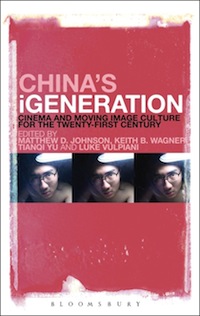 China’s iGeneration: Cinema and Moving Image Culture for the Twenty-First Century edd. Matthew D. Johnson, Keith B. Wagner, Tianqi Yu, Luke Vulpiani (Bloomsbury Academic). Scholars, critics, and practitioners on visual forms such as not only conventional movies, but also 3D and IMAX films, experimental documentaries, and pirated video pastiche argue that a new generation of motion-picture artists and activists is making its mark on global digital culture using recent technologies such as mobile phone cameras and exploring new forms of screening such as through social media. The result, the authors of these essays say, is a radical transformation of conventional notions of cinema and the emergence of a “cinema of dispersion” based in mobile, mutable digital forms. Included are essays on first-person documentaries by women, “quasi-documentary, cellflix, and web spoofs”; new Chinese animation; the use of film in Chinese contemporary art; the emerging “iGeneration” of Chinese filmmakers; the work of San Yuan Li, Zhang Yimou, and Wu Wenguang; new methods of moving-image distribution in China; Xue Jianqiang as “reckless documentarian” of post-WTO China; Docu-ani-mentary” and activist cinema; digital activism in Southern China; and grassroots independent film festivals.
China’s iGeneration: Cinema and Moving Image Culture for the Twenty-First Century edd. Matthew D. Johnson, Keith B. Wagner, Tianqi Yu, Luke Vulpiani (Bloomsbury Academic). Scholars, critics, and practitioners on visual forms such as not only conventional movies, but also 3D and IMAX films, experimental documentaries, and pirated video pastiche argue that a new generation of motion-picture artists and activists is making its mark on global digital culture using recent technologies such as mobile phone cameras and exploring new forms of screening such as through social media. The result, the authors of these essays say, is a radical transformation of conventional notions of cinema and the emergence of a “cinema of dispersion” based in mobile, mutable digital forms. Included are essays on first-person documentaries by women, “quasi-documentary, cellflix, and web spoofs”; new Chinese animation; the use of film in Chinese contemporary art; the emerging “iGeneration” of Chinese filmmakers; the work of San Yuan Li, Zhang Yimou, and Wu Wenguang; new methods of moving-image distribution in China; Xue Jianqiang as “reckless documentarian” of post-WTO China; Docu-ani-mentary” and activist cinema; digital activism in Southern China; and grassroots independent film festivals.
Michael D. Johnson, a 2013-2014 academic visitor at the University of Oxford China Centre and assistant professor of history at Grinnell College relates his experiences with Chinese archives:
The online moving image archive I had used for the chapter on Wu Wenguang and the NGO aesthetic is now offline. Those running the China Independent Documentary Film Archive (CIDFA) have cited changes in policy as accounting for the shut-down, while indicating that they’ll need further approval to get CIDFA back up and running. So there are regulatory issues involved in the archiving of independent Chinese films that pose potential limitations to researcher access when the archives are operating out of China. Another vast archive of independent Chinese films, perhaps the largest in the world, exists at the University of California, San Diego in UCSD’s Geisel Library. That archive was created by former UCSD librarian and Asian film expert Jim Cheng (now at Columbia University) and Paul G. Pickowicz, my graduate mentor at UCSD and another real visionary in terms of his scholarship on Chinese cinema and early engagement with filmmakers and film scholars in the PRC.
How to deal with the incredible proliferation of internet-only visual culture is another question. My main point here is that there are several important archives for Chinese cinema in general, and independent cinema in particular, that exist worldwide. And so national governments can play a role in promoting or restricting access. I’m not in favor of the decision to shut down CIDFA, but many of those films are now in collections elsewhere, so in that sense there is a kind of global network that keeps important work in circulation even when specific archives become inaccessible.
n
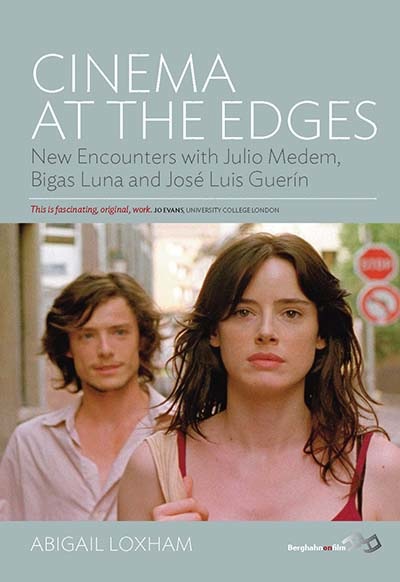 Cinema at the Edges: New Encounters With Julio Medem, Bigas Luna, and Jose Luis Guerin by Abigail Loxham (Berghahn Books). Applies psychoanalytic and other theory in a study of the three Spanish directors, with particular attention to Basque and Catalan identity, and issues relating to “the peripheries: actual, geographical, metaphorical, and corporeal” and the insight they provide into the filmmakers’ cultural and critical importance.
Cinema at the Edges: New Encounters With Julio Medem, Bigas Luna, and Jose Luis Guerin by Abigail Loxham (Berghahn Books). Applies psychoanalytic and other theory in a study of the three Spanish directors, with particular attention to Basque and Catalan identity, and issues relating to “the peripheries: actual, geographical, metaphorical, and corporeal” and the insight they provide into the filmmakers’ cultural and critical importance.
n
A Cinema of Poetry: Aesthetics of the Italian Art Film by Joseph Luzzi (Johns Hopkins University Press). Antonioni, Bertolucci, De Sica, Fellini, Pasolini, Rossellini… and film’s relations with literature.
n
Television and British Cinema: Convergence and Divergence Since 1990 by Hannah Andrews (Palgrave Macmillan)
n
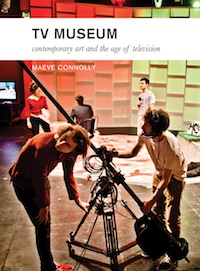 TV Museum: Contemporary Art and the Age of Television by Maeve Connolly (Intellect Books / University of Chicago Press). A lecturer in film, art and creative technologies at Dun Laoghaire Institute of Art, Design & Technology in Dublin takes a novel approach to analyzing television’s place within contemporary art and culture as she charts the changing status of television as cultural form, object of critique, and site of artistic invention. She looks in artworks, exhibitions, and institutional practices in diverse cultural and political contexts to demonstrate television’s continued importance for contemporary artists and curators seeking to question the formation and future of the public sphere. She discusses exhibiting television as object; soaps, sitcoms, and symbolic value in art and television; reality TV and the social turn in art; TV archives, memory, and media events; broadcasting and the public realm; TV talk shows and curatorial practice; and TV production cultures.
TV Museum: Contemporary Art and the Age of Television by Maeve Connolly (Intellect Books / University of Chicago Press). A lecturer in film, art and creative technologies at Dun Laoghaire Institute of Art, Design & Technology in Dublin takes a novel approach to analyzing television’s place within contemporary art and culture as she charts the changing status of television as cultural form, object of critique, and site of artistic invention. She looks in artworks, exhibitions, and institutional practices in diverse cultural and political contexts to demonstrate television’s continued importance for contemporary artists and curators seeking to question the formation and future of the public sphere. She discusses exhibiting television as object; soaps, sitcoms, and symbolic value in art and television; reality TV and the social turn in art; TV archives, memory, and media events; broadcasting and the public realm; TV talk shows and curatorial practice; and TV production cultures.
n
April 2014
n
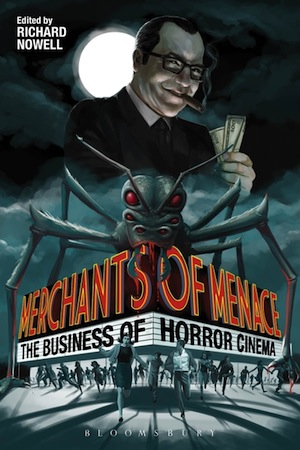 Merchants of Menace: The Business of Horror Cinema ed. Richard Nowell (Bloomsbury Academic). Essays on horror-film production, style, marketing, and distribution: American horror cinema and horror literature of the late 1960s and 1970; how studios shaped zombie films from 1932 to 1946; Hammer “heritage” horror in 21st-century Britain, Australian horror, psychiatry’s interventions into the postwar horror business…
Merchants of Menace: The Business of Horror Cinema ed. Richard Nowell (Bloomsbury Academic). Essays on horror-film production, style, marketing, and distribution: American horror cinema and horror literature of the late 1960s and 1970; how studios shaped zombie films from 1932 to 1946; Hammer “heritage” horror in 21st-century Britain, Australian horror, psychiatry’s interventions into the postwar horror business…
n
The Pedagogical Imagination: The Republican Legacy in Twenty-First Century French Literature and Film by Leon Sachs (University of Nebraska Press). The works of Agnes Varda, Erik Orsenna, Abdellatif Kechiche, Francois Begaudeau, and others provide insight into French conceptions of national identity and values. Sachs emphasizes less “what” literature and film say about education to “how” they say it, and argues that the most important literary and film treatments of French education explore questions of education through experiments with form.
n
Playing with Religion in Digital Games (Indiana University Press). In the first volume of the press’s Digital Game Studies series, Heidi Campbell and Gregory P. Grieve edit a collection of essays whose rationale is that religious elements pervade modern video games, as evidenced by such elements as shamans, paragons, and “God-mode.”
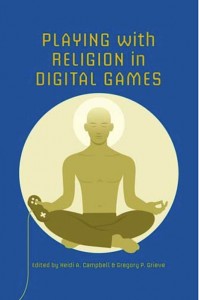 In the Shinto-inspired Japanese video game Okami, the popular The Legend of Zelda and Halo, and many other game, religious themes and symbols drive narratives and frame storylines. Writers ask such questions as: How does religion help organize the communities in “massively multiplayer online role-playing games” (MMORPGs) such as World of Warcraft? What role has censorship played in localizing games like Actraiser in the western world? How do evangelical Christians react to violence, gore, and sexuality in some of the most popular games such as Mass Effect or Grand Theft Auto? How do Arab and American video games portray Islam?
In the Shinto-inspired Japanese video game Okami, the popular The Legend of Zelda and Halo, and many other game, religious themes and symbols drive narratives and frame storylines. Writers ask such questions as: How does religion help organize the communities in “massively multiplayer online role-playing games” (MMORPGs) such as World of Warcraft? What role has censorship played in localizing games like Actraiser in the western world? How do evangelical Christians react to violence, gore, and sexuality in some of the most popular games such as Mass Effect or Grand Theft Auto? How do Arab and American video games portray Islam?
There are “hardcore Christian gamers”?
Campbell, an associate professor of communication at Texas A&M University, is director of the Network for New Media, Religion, and Digital Culture Studies and editor of Digital Religion. She has published three books in that area: Digital Religion: Understanding Religious Practice in New Media Worlds (Routledge, 2013), When Religion Meets New Media (Routledge, 2010), and Exploring Religious Community Online (Peter Lang-Digital Formation Series. 2005). Grieve is an associate professor of religious studies at the University of North Carolina at Greensboro and director at UNCG of MERGE: A Network for Collaborative Interdisciplinary Scholarship and co-chair of the American Academy of Religion’s section on Religion and Popular Culture. He is author of Retheorizing Religion in Nepal (Palgrave Macmillan, 2006) and editor (with Steven Engler) of Historicizing “Tradition” in the Study of Religion (Walter de Gruyter, Inc., 2005).
Grieve was an early observer of the questions increasingly asked about religion in digital games. His 1995 essay, “Imagining a Virtual Religious Community: Neo-pagans on The Internet,” noted: “Anyone who has spent time exploring the Internet cannot help but notice the prevalence of Neo-Paganism.” He investigates what he called “the seeming paradox of why neo-Paganism, a self-proclaimed nature religion, pervades cyberspace” — it seems paradoxical because “what defines the social space opened up by the Internet is lack of ‘presence,’ the face-to-face interaction of oral communication which is generally considered necessary for the formation of authentic communities, religious or otherwise,” he wrote.
He suggested that the answer to his questions begins with noting that “other media besides speech enable human beings to imagine communities which transgress the horizons of face-to-face interaction” because, as another researcher, Benedict Anderson, observed, “all communities larger than primordial villages of face-to-face contact (and perhaps even those) are imagined.”
Grieve suggested that “what is unique about neo-Pagan practitioners is that they are able to imagine a religious community which is not dependent on presence. Instead of presence their Internet communities are sustained by the notion of a religious ‘energy’ which is created and circulated by ‘personal rituals.’ It is their shared ‘feeling of energy’ which binds them together in cyberspace, and enables them to imagine a virtual religious community.”
That is a significant achievement, he suggested: “Neo-Pagans ‘re-enchant’ the disenchanted landscape of modernity through a religious strategy whose myths are patterned on an imagined pre-Christian European religion, but whose practices revolve around the production of an affective sentiment which neo-Pagan nomenclature labels ‘energy.’ The ‘feeling of energy’ created by personal rituals is a religious strategy which employs a ritualized imagination. The ritualized imagination is the sanctification not of the content of specific creative acts, but of the act of creation itself.”
Grieve arrived at that conclusion by observing four religious Usenet newsgroups — alt.pagan, soc.religion.bahai, soc.religion.christian, and soc.religion.eastern for six months, concentrating on ‘alt.pagan,’ whose stated role is to advance “discussion of paganism and Witchcraft in their various forms and traditions.” He also compared the ethnographic data from alt.pagan with his own interactions with neo-Pagans at the 1993 World Parliament of Religions, especially with members of Circle — a ‘Shamanic Wiccan Church’ headquartered near Madison, Wisconsin; and Covenant of The Goddess — a Wiccan Coven headquartered in Berkeley, California.
In keeping with that early work on such issues, the members of the Network for New Media, Religion, and Digital Cultural Studies – those include scholars in political science, area studies, and psychology – explore what is happening at the intersections of religion, the internet, and new, social and mobile media, a growing research area. In a post on the group’s website, Campbell writes that her and Grieve’s collection “spotlights the growing influence religion has in digital gaming. It also showcases the increased attention by scholars around the world to digital gaming and its impact on popular conceptions of religion.” She suggests that the use of religious images, narratives, and characters in popular video and digital games provides insights into the broader role of religion in popular culture. The essay collection “maps the ways religion is used in gaming to create myths and meanings, revealing the implications of these uses for gamers and framings of religion.”
Grieve agrees: “There is a notion that games and religion have nothing to do with each other. This book provides evidence that they do actually have a lot of similarities and these similarities offer insights into aspect of how religion is performed.” Campbell says that essays in the collection show, for example, how using Muslims and Hindu gods as gaming characters “reframes religion in both positive problematic ways.” Other chapters, she adds, “consider how some characterizations of religion expressed in popular games present non-traditional conceptions of the relationship that exists between virtual and spiritual worlds.”
Such observations, she suggests, shed light on existing questions about the role of religion in society and conceptions of religion outside religious communities. And that, she adds, demonstrates why the field of games studies needs to pay more attention to the role played by religion in digital games. Grieve says: “Many people have made very general claims about religion and games, but few close readings about the games themselves exist.”
n
Power and Paradise in Walt Disney’s World by Cher Krause Knight (University Press of Florida). Scholarly/personal perspectives on the design, appeal, and cultural impact of Disney World, Florida.
n
March 2014
n
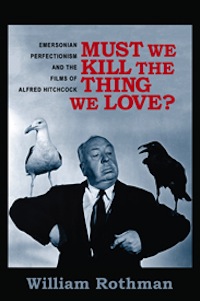 The Forms of the Affects by Eugenie Brinkema (Duke University Press) The effect on affect theory of filmmakers Greenaway, Haneke, Lynch, Hitchcock… and theorists like Freud, Barthes, and Kierkegaard.
The Forms of the Affects by Eugenie Brinkema (Duke University Press) The effect on affect theory of filmmakers Greenaway, Haneke, Lynch, Hitchcock… and theorists like Freud, Barthes, and Kierkegaard.
n
Must We Kill the Thing We Love? Emersonian Perfectionism and the Films of Alfred Hitchcock by William Rothman (Columbia University Press) Likens Hitchcock’s “written” style to Emerson.
n
Reading Joss Whedon ed. Rhonda V. Wilco, Tanya R. Cohen, others (Syracuse University Press) Essays about Buffy the Vampire Slayer‘s producer and writer.
n
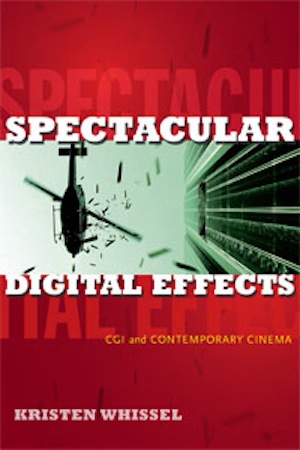 Sex Scene: Media and the Sexual Revolution ed. Eric Schaefer (Duke University Press) Essays on film, television, recorded sound, and publishing involvement in “the sexual revolution” of the 1960/70s — sexploitation, sex-ed film, erotic-film festivals, sexual innuendo on The Love Boat, gay porn, and other evidence that sex circulated in the public sphere, from the mainstream to the fringe. Scholars of cultural studies, history, and media studies highlight the increasingly fluid divide between public and private, the rise of consumer and therapeutic cultures, and the relationship between identity politics and individual rights.
Sex Scene: Media and the Sexual Revolution ed. Eric Schaefer (Duke University Press) Essays on film, television, recorded sound, and publishing involvement in “the sexual revolution” of the 1960/70s — sexploitation, sex-ed film, erotic-film festivals, sexual innuendo on The Love Boat, gay porn, and other evidence that sex circulated in the public sphere, from the mainstream to the fringe. Scholars of cultural studies, history, and media studies highlight the increasingly fluid divide between public and private, the rise of consumer and therapeutic cultures, and the relationship between identity politics and individual rights.
n
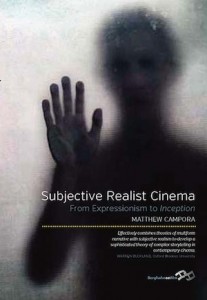 Spectacular Digital Effects: CGI and Contemporary Cinema by Kristen Whissel (Duke University Press). A professor of film & media studies at the University of California at Berkeley explores how spectacular visual effects have advanced narratives by study of live-action films made between 1989 and 2011.
Spectacular Digital Effects: CGI and Contemporary Cinema by Kristen Whissel (Duke University Press). A professor of film & media studies at the University of California at Berkeley explores how spectacular visual effects have advanced narratives by study of live-action films made between 1989 and 2011.
n
Subjective Realist Cinema: From Expressionism to Inception by Matthew Campora (Berghahn Books). On Mulholland Drive, Memento, and Eternal Sunshine of the Spotless Mind.
n
February 2014
n
Cindy Sherman’s Office Killer: Another Kind of Monster by Dahlia Schweitzer (Intellect Books, dist’d University of Chicago Press) A study of Office Killer, 1997, the American photographer’s only feature film.
{Click on thumbnail to view gallery}
nA
February 2013
n
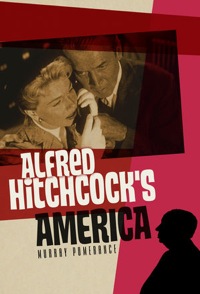 Alfred Hitchcock’s America by Murray Pomerance (Polity Press)
Alfred Hitchcock’s America by Murray Pomerance (Polity Press)
A professor of sociology at Ryerson University who edits the Polity press’s of the Moving Image series. He explores Hitchcock’s reflections on American life, values, and landscape, and his sharp eye for social detail and the pressures of class inequality. Pomerance analyzes Hitchcock’s attention to location sequences, characterological types, and the complex social expectations of American society. Pomerance previously published An Eye for Hitchcock (2004) and Shining in Shadows: Movie Stars of the 2000s (2011).
n
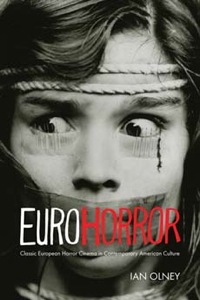
Euro Horror: Classic European Horror Cinema in Contemporary American Culture by Ian Olney (Indiana University Press)
A York College of Pennsylvania film-studies professor discusses the history and appeal of “Euro Horror” moves that made their way to American drive-in and urban grindhouse cinemas in the 1950s. Embraced by fans and denounced by critics as cinema trash, films of such genres as giallo films from Italy, S&M horror, lesbian-vampire, and cannibal-zombie films indulged in gory, sexualized terror. Olney also develops a theory of such films’ renewed appeal to audiences today. Harry M. Benshoff, author of Monsters in the Closet: Homosexuality and the Horror Film says the book is “guaranteed to send scholars and fans running back to their DVD outlets, either to discover or revisit some of the oddest and most provocative horror films of all time.” All while “arguing for the value of Eurohorror generally to a contemporary politics of identity,” says Peter Hutchings, author of The Historical Dictionary of Horror Cinema. The book “traces the emergence, disappearance, and return of Euro-Horror within US culture since the fifties, its revilers and devotees, its subversive potential, and its echoes in the work of filmmakers like Haneke, von Trier, or Almódovar,” says Macalester College film scholar Linda Schulte-Sasse. “In the process, Olney explodes the last of our treasured binaries: art vs. schlock, ‘real’ vs. fan scholar, hack vs. auteur, progressive vs. regressive movie.”
Ian Olney describes how poor archiving obstructed his research
In researching and writing Euro Horror, I had recourse to few archival materials. Unfortunately, the films I focus on in the book (Continental European horror movies made between the mid-1950s and the mid-1980s) have not generally been viewed as archive-worthy. This is partly the result of their genre (horror), partly a result of their place in popular culture (low), and partly a result of the fact that they don’t conform to the critically vaunted model of European cinema (art). Consequently, I was forced initially to access them on videotape and DVD via “gray market” mail order catalogs and websites – although they have since become more widely available on DVD and Blu-Ray, and even in theatrical re-release. It would have been wonderful to have been able to work with the films themselves (and related materials) in an archival setting; unfortunately, this just wasn’t possible. I even had difficulty tracking down publicity stills from these movies to use as illustrations in the book. This perhaps highlights the extent to which an “archival hierarchy” still exists with regards to film – one that largely excludes the sort of “lowbrow” cinema discussed in my book.
n
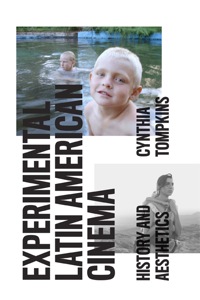 Experimental Latin American Cinema: History and Aesthetics by Cynthia Tompkins (University of Texas Press)
Experimental Latin American Cinema: History and Aesthetics by Cynthia Tompkins (University of Texas Press)
An Argentine-raised associate professor of Spanish and Latin American cultural production at Arizona State University discusses 17 recent experimental films made during the last 20 years by 11 filmmakers from Argentina, Brazil, Cuba, Mexico, Paraguay, and Peru. Tompkins, earlier the author of Latin American Postmodernisms: Women Writers and Experimentation, explores such topics as the theme of decolonization, montage, narrative structure, and the fusion of documentary conventions and neorealism with drama.
n
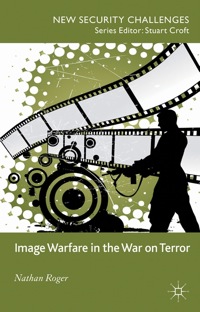 Image Warfare in the War on Terror: New Security Challenges by Nathan Roger (Palgrave Macmillan)
Image Warfare in the War on Terror: New Security Challenges by Nathan Roger (Palgrave Macmillan)
A research associate at the Research Institute for Arts and Humanities at Swansea University argues that since 9/11, image warfare has replace techno-war as the dominant form of combat, and that the West is playing catch-up in it with Al Qaeda. Roger surveys the styling and deployment of disturbing images of bin Laden videos, acts of suicide terrorism, hostage executions, and prisoner abuses to create a new vocabulary for understanding and discussing them – with such terms as image munitions, counter-image munitions, and remediation battles.
Nathan Roger describes his archival method
To research this book I employed a “snowball sampling” technique where I used a combination of Google searches and clicking on links between websites to give me a diverse sample of images: news images, bin Laden videos, hostage videos, suicide terrorism footage, Abu Ghraib images, films, YouTube videos, street art, gallery art, cartoon images, advertisements, and more.
Because of the sheer amount of information available on the internet and because image appropriation and remediation does not have an end point – rather it is a constantly evolving process – a similar search today would result in the discovery of a number of new images ripe for study.
A challenge with this kind of research, due to the rhizomatic nature of the internet, can sometimes be tracking down images again after they have been originally collected. For example, weblinks to websites where images were originally discovered can quickly become out-of-date. However, you can often rediscover the images – reposted on other websites. This process of rediscovery can also lead to the discovery of new image appropriations and remediations.
n
January 2013
n
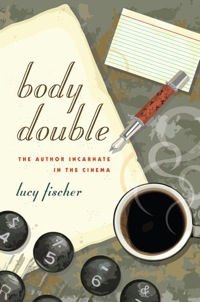 Body Double: The Author Incarnate in the Cinema by Lucy Fischer (Rutgers University Press)
Body Double: The Author Incarnate in the Cinema by Lucy Fischer (Rutgers University Press)
A literature and film scholar at the University of Pittsburgh examines filmmakers’ portrayal of writers and authorship in Adaptation, Naked Lunch, American Splendor, Irezumi, and other films from Hollywood, international art cinema, and the avant-garde. Fischer, the author or editor of American Cinema of the 1920s: Themes and Variations and Designing Women: Art Deco, Cinema, and the Female Form, draws on a neglected element of auteur studies to show that filmmakers frequently raise questions about the paradoxes of authorship by portraying the onscreen writer. She addresses such topics as the icon of the typewriter, the case of the writer/director, the authoress, and the omnipresent infirm author. She explores how films can tell a plausible story while contemplating the conditions and theories of their making. Fischer “reshapes our understanding of authorship in the cinema while exploring related issues regarding gender, style, writing, and embodiment,” says Patrice Petro, past president of the Society for Cinema and Media Studies.
n
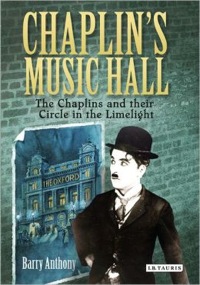 Chaplin’s Music Hall: The Chaplins and Their Circle in the Limelight by Barry Anthony (I.B. Tauris, distributed by Palgrave Macmillan)
Chaplin’s Music Hall: The Chaplins and Their Circle in the Limelight by Barry Anthony (I.B. Tauris, distributed by Palgrave Macmillan)
A historian of the Victorian and Edwardian period who has written extensively about popular culture and entertainment, presents a study of Chaplin’s early days as a music-hall performer among family members and their friends who were also performers. Anthony shows that Chaplin’s experiences of dance-hall culture significantly shaped his acting and films, at a time when the music hall was changing from entertainment reminiscent of its tavern-based origins to a highly-financed industry seeking broad legitimacy with mixed performance results. Among the characters in Chaplin’s life whose difficult and often tragic lives Anthony describes are “dashing” Eva Lester, the great Fred Karno, and Chaplin’s parents Hannah Hill and Charles Chaplin. Anthony has previously published The King’s Jester: The Life of Dan Leno, Victorian Comic Genius and, with Richard Brown, a groundbreaking study of the early British cinema, A Victorian Film Enterprise.
n
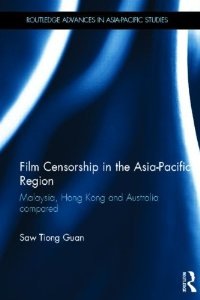 Film Censorship in the Asia-Pacific Region: Malaysia, Hong Kong and Australia Compared by Saw Tiong Guan (Routledge)
Film Censorship in the Asia-Pacific Region: Malaysia, Hong Kong and Australia Compared by Saw Tiong Guan (Routledge)
A Malaysian legal scholar and independent film director and producer compares the film-censorship practices of the three countries, from the perspective of both censors and filmmakers. He examines the censorship laws, policies, guidelines, and processes and evaluates film practitioners’ and censors’ opinions of censorship, and ways of dealing with them. He then proposes changes to the Malaysian system that would provide greater transparency and accountability to the system, to reconcile it with free speech, and to make it more responsive to the needs of filmmakers and the film industry.
n
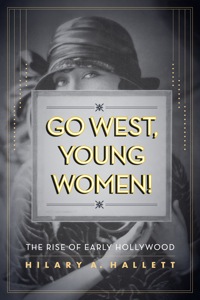
Go West, Young Women: The Rise of Early Hollywood, by Hilary Hallett (University of California Press)
A Columbia University historian explains how Los Angeles became, in 1920, the only western city where women outnumbered men. She explores the relatively unknown New Woman of the West and her role in the development of Los Angeles and the nascent film industry. She explains how women on both sides of the screen pioneered the transformation of the fledgling film industry from a marginal, decentralized business controlled by wealthy Anglo-Americans into the dominant, cosmopolitan industry of early Hollywood centered in Los Angeles. Publicity about female celebrities focused on their independence, resourcefulness, and traversal of Los Angeles’s increasingly bohemian terrain. Hollywood came to represent a different kind of frontier, one that spoke to a country torn between Victorian rectitude and individual emancipation, dreams of upward mobility and fears of moral dissolution. From Mary Pickford’s rise to become perhaps the most powerful woman of her age, to the racist moral panics of the anti-war years and the aftermath of Hollywood’s first sex scandal, Hallett describes how the path through early Hollywood presaged the struggles over modern gender roles that animated the century to come.
Hilary Hallett told Moving Image Archive News about her preparation of the book.
In general terms, what was your experience in searching for material in archives and the like?
 There is more accessible today on early Hollywood than ever before. That’s a combination of both the increased materials that are available at places like the Margaret Herrick Library in L.A. They’ve received more funding in recent decades, and they’ve taken their scholarly mission more seriously. Even over the time of my working there, you could see that changing. I did a lot of work there, and that was very satisfying.
There is more accessible today on early Hollywood than ever before. That’s a combination of both the increased materials that are available at places like the Margaret Herrick Library in L.A. They’ve received more funding in recent decades, and they’ve taken their scholarly mission more seriously. Even over the time of my working there, you could see that changing. I did a lot of work there, and that was very satisfying.
There are also the new electronic databases like FIAF [a group of databases from the International Federation of Film Archives] have made it much easier to find films even if they exist only in fragments, and even when films aren’t available, to do the archival work of just figuring out how many films an actress was in, and what kinds of films she was in. It has made that whole process far more complete. It’s not totally complete, of course, but it’s far more complete and it’s far easier to do than it was a generation ago.
So, we’re in a position now where we don’t have to make generalizations quite so much. Obviously most silent films are gone – that’s just the fact of the matter. But we are increasingly in a position where we don’t have to rely on just a very few pieces of evidence to speak for everything.
How many films were you able to watch, and did you have to do that at the libraries?
As I went along more and more stuff became available on DVD. My book is as interested in film culture as in silent film. This is why the Margaret Herrick Library and the New York Library’s Library of the Performing Arts were essential to me, because at places like that I was using a lot of scrapbooks. That was a practice that started on the Victorian stage. There was a variety of kinds of scrapbooks, but the kind I was mostly using were ones where a writer or an actor or a director would pay somebody at a professional service to cut out all of the press about you that was published nationally, and paste it into a scrapbook.
The scrapbooks provide a really amazing window onto what the press had to say about particular films, personalities, and subjects. Even though more newspapers are available now through archival means or microfilm, the scrapbooks provide everything from the big papers that everybody would look at, to little papers that you would never find any more. So you can really start to get a much more complete idea of how a subject was talked about.
Especially in the first half of my book, when I was trying to understand the way that these early performers in the industry were imagined, those sources were really great to get at that.
In terms of movies, I watched things at the Museum of Modern Art, at UCLA, and at the Library of Congress, and then increasingly I watched things on DVD, because especially with the bigger personalities, like Mary Pickford, obviously, almost everything she made is now available on DVD. And, again, places like the Margaret Herrick and the Academy [of Motion Picture Arts & Sciences] have funded that just in the last 10 to 15 years.
What’s on DVD is still very D.W. Griffith-heavy, but increasingly there is more material. For example, many of the Gloria Swanson films I write about, which in the beginning of my research for my dissertation I could see only if I went to the Library of Congress, are now available on DVD.
There’s clearly a growing interest. Public interest is driving the increase in availability of feminist material.
Were you surprised by what you found, in terms of the attention at that time to women actors, producers, directors, and so forth?
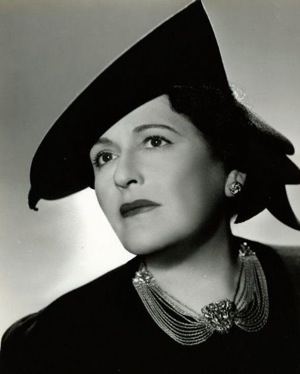
I really was, I was very surprised. The first half of my book is about pre-Hollywood, the tens and teens, before the industry has really consolidated in Los Angeles. What really surprised me was how much early fan culture, and so many of the early journalists who were reporting on the early industry, felt free to use these women working in the industry as a jumping off point to talk about things like feminism. I hadn’t expected to find that. It was a new word that had just entered the English language via the French. So I was very surprised at how much they were a site for discussing the emergence of the modern woman, and for debate about discussing her social and professional freedoms.
And then even more so, as the industry began moving West, the way a lot of these writers, people like Louella Parsons [the first American movie columnist], who went on to become a huge powerhouse in the industry, used their writing to promote the industry in these terms, as a new safety valve for ambitious young women, in a classic American way. She was saying ‘Go west, not just to be a help-meat for men, but to earn your own fortune in Hollywood.’
In those early years, there was also a sense that that wasn’t a hard thing to do, to break into the film industry. That changed over the period my book discusses. But initially, it was not an industry that everyone wanted to be a part of; so, you could write about it as a realistic goal in ways that you would not find today – the openness and accessibility of it.
Even now? How did that manifest itself in film participation of women? Was entrance into that world as ready for them as for men?
No, I wouldn’t say it was a completely level playing field, but they were working as directors, producers, and writers in percentages which in some cases are not even equaled today. So it was certainly much more open than what one expected for decades later, really up to today. The directors numbers have still not reached parity, last I checked. But producers, writers, yes, we’re now back to the 1910s and ‘20s – in 2012.
What explains why those numbers dropped?
That’s part of what my book tries to explain. It’s a complicated story. It was clear right after World War I that this was going to be a big business, as the new studio system, the new trust, started to develop. You start to see people taking the industry more seriously, and some of what that means is that men need to be in charge, right, because this is a serious big business, the fourth largest in the country. You see the growth of unions, and we know that unions often do all kinds of good things for workers, but what they often did for women was to exclude them. As you see cinematography, and the Directors Guild, and various unions being created, they had explicit policies about women not being allowed. That’s one piece of the story.
Another that my book focuses more on, is the way in which there was a general cultural reaction about how Hollywood was publicizing and seemingly in some instances supporting and promoting these kinds of freedoms among young women. Quite simply a lot of more conservative cultural custodians, religious conservatives, who’d become involved in their own censorship movement, were not happy about that. They’re not happy about the influence the industry is having on the aspirations and seemingly the morals of its daughters. So there really is a backlash that begins after World War I, again, as it’s becoming clear to everybody quite suddenly what a big industry this is going to be, with the decimation of the Italian and French film industries in World War I. It’s clear that this is the biggest player in town, now, and this is one of America’s biggest industries.
One of the things that was fun about the research was exploring that realization that as the war ended, there was all of a sudden a growing recognition that this run-amok, slightly déclassé business, that mostly was associated with working-class immigrants in the early 1910s, had become something very different. The suddenness of that transformation accounts for some of the concerns about the industry.
There was a more general backlash against the promotion of some of these ideas about women, and it became very pointedly directed when the Fatty Arbuckle scandal happened, at the time where I end my book. Part of what I argue is that the outcry over that scandal was about sending a message to Hollywood that it had gone too far.
A piece of anti-Semitism that comes into play, too, pretty powerfully after World War I, with the recognition that these mostly Jewish immigrant producers are in charge of the business, now. That adds a whole other layer of uncomfortability, with their relationship with setting the moral standards for young women.
Is there enough archival material out there to be able to complete a PhD dissertation like yours without too many problems?
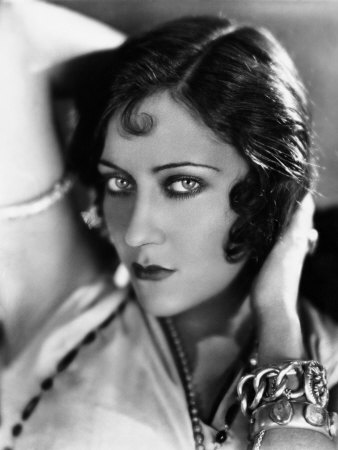
Definitely. There has definitely been an improvement in the availability of materials and the databases to help locate them, for sure. That helps a lot.
I don’t know what accounts for the increased interest in this subject in scholarly circles and among the public. Maybe there’s a nostalgia. I’m not entirely sure about that. Maybe it’s just that with the Web, it’s been made visible in a new way. It does seem that there is more interest and that that is driving people like me, because I’m not alone, to find what is there, what was there already.
Is it a matter of the cultural blinders having come off with the gains of, say, feminist scholarship – scholars are simply more likely to see now what has always been there, if only they were oriented towards it?
Exactly; that’s a good way of putting it. Because it’s not hard to find. I teach a class every other year or so called Gender in History and American Film. The students do research papers and it’s wonderful because every year they say ‘I can’t believe they’re talking this way.’ And they’re just using historical newspapers online. It’s not that hard to find, really, if you’re open to seeing it.
n
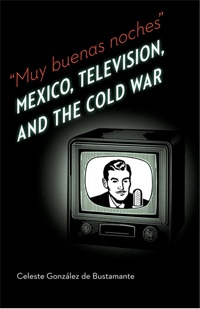 Muy Buenas Noches: Mexico, Television, and the Cold War by Celeste Gonzalez de Bustamante (University of Nebraska Press)
Muy Buenas Noches: Mexico, Television, and the Cold War by Celeste Gonzalez de Bustamante (University of Nebraska Press)
An assistant professor of journalism at the University of Arizona who formerly was a reporter and news anchor documents tensions between Mexican news reporting and the interests of the ruling PRI party. She shows how Mexican multimedia conglomerate Televisa rose to become one of the most powerful media companies in the world through sometimes fractious relationships with the Partido Revolucionario Institucional (PRI), which ruled for seventy-one years, and through assistance from government regulations that aided the television industry. She examines early television news programs to explore tensions between PRI and government wishes and what was actually reported, and understood from the news.
n
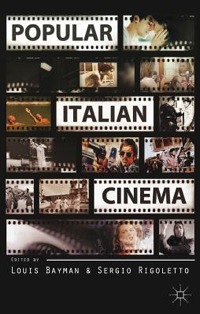 Popular Italian Cinema edited by Louis Bayman and Sergio Rigoletto (Palgrave Macmillan)
Popular Italian Cinema edited by Louis Bayman and Sergio Rigoletto (Palgrave Macmillan)
Essays by younger scholars on Italian cinema beyond the auteur and neorealist canons. Authors address take stock of sex comedies, melodramas, the poliziesco, the mondo film, missionary cinema, and the musical, and ask how they cst light on just what “popular cinema” means in the Italian context.
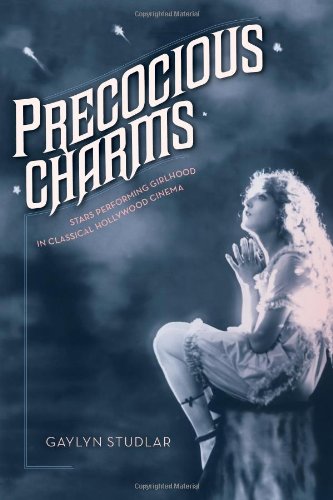
n
Precocious Charms: Stars Performing Girlhood in Classical Hollywood Cinema by Gaylyn Studlar (University of California Press)
A professor in the humanities at Washington University (St. Louis, Missouri) considers such adult actresses as Mary Pickford, Shirley Temple, Deanna Durbin, Elizabeth Taylor, Jennifer Jones, and Audrey Hepburn have portrayed girlhood. She contends that Hollywood provided audiences with complex pleasures for audiences by presenting female stars as young girls or girls on the verge of becoming women reflects a wide variety of cultural influences, ranging from Victorian sentimental art to New Look fashion, from nineteenth-century children’s literature to post-World War II sexology, and from grand opera to 1930s radio comedy.
Studlar earlier published This Mad Masquerade: Stardom and Masculinity in the Jazz Age (1996) and In the Realm of Pleasure: Von Sternberg, Dietrich, and the Masochistic Aesthetic (1993). She has co-edited anthologies about John Ford Westerns, John Huston, and other film subjects.
n
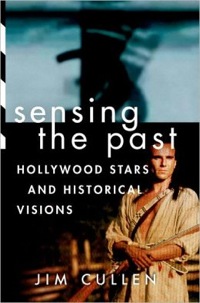 Sensing the Past: Hollywood Stars and Historical Visions by Jim Cullen (Oxford University Press)
Sensing the Past: Hollywood Stars and Historical Visions by Jim Cullen (Oxford University Press)
A historian at the Ethical Culture Fieldston School in New York writes about how Hollywood actors like Clint Eastwood, Daniel Day-Lewis, Denzel Washington, Tom Hanks, Meryl Streep, and Jodie Foster have embodied key historical narratives. He focuses on the career choices the iconic actors made and suggests surprising ways in which historical forces shape understanding of the world. Cullen has also published The American Dream: A Short History of an Idea that Shaped a Nation (Oxford UP, 2004), Born in the U.S.A.: Bruce Springsteen and the American Tradition (Wesleyan UP, 2004), and other books.
n
 Spanish Queer Cinema by Chris Perriam (Edinburgh University Press, distributed by Columbia University Press)
Spanish Queer Cinema by Chris Perriam (Edinburgh University Press, distributed by Columbia University Press)
A professor of Hispanic studies at the University of Manchester examines filmmaking, festivals, queer lives and cultures in Spain since 1998, and their contribution to a new Spanish queer imagination. He focuses on filmmaking and film watching since 1998, when Catalonia passed the first of Spain’s regional laws on same-sex partnership (same-sex marriage became recognized, nationally, in 2005), and goes beyond the well-known films of Pedro Almodóvar or the gay comedies of the 1990s. He analyzes short films, documentaries, and features – many by, for, or about lesbians – and the way they have constituted a stand against homophobia and exclusion, responded to health and welfare crises, questioned or affirmed the value of same-sex marriage, and constructed new forms of love and community.
n
Storytelling in World Cinemas, Volume 2: Contexts edited by Lina Khatib (Wallflower Press, distributed by Columbia University Press)
Essays ask why particular stories are told in films around the world, both in terms of the forms of storytelling used, and of the political, religious, historical, and social contexts informing cinematic storytelling. The essays, on such topics as women’s stories and public space in the Iranian new wave, approach storytelling from such perspectives as the influence of cultural politics, postcolonialism, women’s social, and religion.
n
December 2012
n
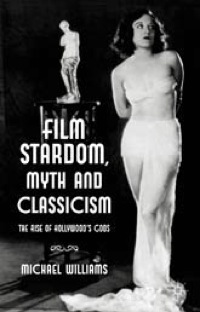 Film Stardom, Myth, and Classicism: The Rise of Hollywood’s Gods by Michael Williams (Palgrave Macmillan)
Film Stardom, Myth, and Classicism: The Rise of Hollywood’s Gods by Michael Williams (Palgrave Macmillan)
A film-studies researcher at the University of Southampton, UK, who previously published Ivor Novello: Screen Idol, and co-edited British Silent Cinema and the Great War, asks why Hollywood of the 1910s and 1920s, while an expression of modernity, looked back to antiquity as it built its stars. He draws from studio production files, fan magazines, and the popular reception of stars in America and Britain to explore how the sculptural gods of the past helped vivify the modern stars, and also encode various sexualities for their audience. Williams details, in particular, such leading players as Ramon Novarro, Greta Garbo, and Rudolph Valentino, and major films such as Ben-Hur and Flesh and the Devil to show how classicism enabled star discourse to transform actors into icons. Says Brian McFarlane, Monash University, author of the acclaimed Real and Reel: The Education of a film obsessive and critic, praises the book for its study of film after World War I, a time of an “emphasis on heroes and broken men, on loss and celebration, on the marble memorialising of real-life heroes as compared with the potency of the star images caught in a complex mode of evanescence and permanence.”
n
 Captive Audience: The Telecom Industry and Monopoly Power in the New Gilded Age by Susan Crawford (Yale University Press)
Captive Audience: The Telecom Industry and Monopoly Power in the New Gilded Age by Susan Crawford (Yale University Press)
Why are Americans paying more for less, when it comes to broadband access? Crawford, a Harvard University law professor and former special assistant for science, technology, and innovation policy to President Obama, discusses the merger of Comcast and NBC Universal and argues that, as a result of monopolies and government compliance, the US has ceded its leadership in Internet development to Japan, South Korea, and other nations.
n
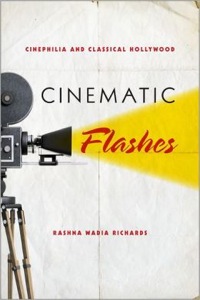 Cinematic Flashes: Cinephilia and Classical Hollywood by Rashna Wadia Richards (Indiana University Press)
Cinematic Flashes: Cinephilia and Classical Hollywood by Rashna Wadia Richards (Indiana University Press)
In a “spectacular, sensational achievement” (Adrian Martin, co-author of Movie Mutations: The Changing Face of World Cinephilia), the director of film studies at Rhodes College (Tennessee) disputes popular notions of a uniform Hollywood style. “She seizes upon seemingly minor moments in classical Hollywood movies and slowly teases out their ramifications until these ‘moments,’ through a cavalcade of novel linkages and associations, have grown momentous,” says George Toles, a University of Manitoba scholar and screenwriter who has worked with Guy Maddin. Richards extracts fragments – “unexpected moments” – from narratives of films to explore what they reveal about the studio era. Inspired by Walter Benjamin’s preference for studying cultural fragments rather than composing grand narratives, she reveals how classical Hollywood emerges as a disjointed network of accidents, excesses, and coincidences.
n
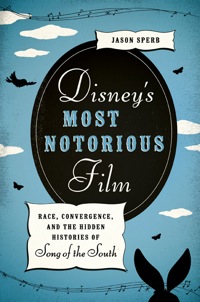 Disney’s Most Notorious Film: Race, Convergence, and the Hidden Histories of “Song of the South” by Jason Sperb (University of Texas Press)
Disney’s Most Notorious Film: Race, Convergence, and the Hidden Histories of “Song of the South” by Jason Sperb (University of Texas Press)
A film and media scholar at Indiana University and editorial-board member of Film Criticism examines the notorious 1946 cartoon film’s retelling of the stories of Uncle Remus. He analyzes the Walt Disney Company film’s reception and relation to race relations over seven decades. The film used cartoon characters and live actors to retell Joel Chandler Harris’s stories. In the movie, a kindly black Uncle Remus tells tales of Brer Rabbit, Brer Fox, and the “Tar Baby” to adoring white children, and it increased in popularity despite objections to its condescending and outdated depictions of black Americans. Disney has withheld the film from American audiences since the late 1980s. Sperb explains how audience perceptions of SotS have reflected debates over race in the larger society. He also explores why and how Disney has repurposed and repackaged elements of SotS such as the Oscar-winning “Zip-a-Dee-Doo-Dah” to an enthusiastic fan base.
n
n
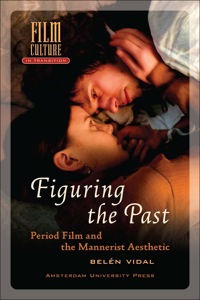 Figuring the Past: Period Film and the Mannerist Aesthetic by Belen Vidal (Amsterdam University Press, distributed by University of Chicago Press).
Figuring the Past: Period Film and the Mannerist Aesthetic by Belen Vidal (Amsterdam University Press, distributed by University of Chicago Press).
A lecturer in film studies at King’s College London analyzes period films’ recreation of the past as demonstrated in the use of three visual motifs and mannered elements – the house, the tableau, and the letter – in films of James Ivory, Martin Scorsese, Jane Campion, and others. Vidal’s stated purpose is to encourage academic study of the popular genre, in part by linking it to the growing interest in the intersections of cinema with painting, photography, and literature.
n
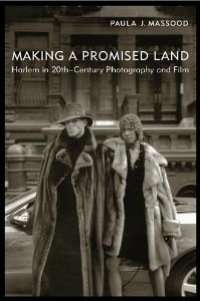 Making a Promised Land: Harlem in 20th-Century Photography and Film by Paula J. Massood (Rutgers University Press)
Making a Promised Land: Harlem in 20th-Century Photography and Film by Paula J. Massood (Rutgers University Press)
A film and theater scholar at Brooklyn College and the Graduate Center of City University of New York traces the changing representation of New York city district, with particular attention to the gangster film. Massood earlier wrote Black City Cinema: African American Urban Experiences in Film and edited The Spike Lee Reader.
n
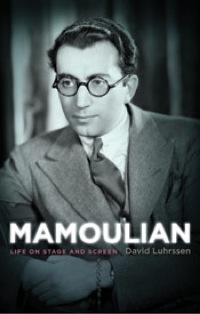 Mamoulian: Life on Stage and Screen by David Luhrssen (University Press of Kentucky)
Mamoulian: Life on Stage and Screen by David Luhrssen (University Press of Kentucky)
A study of the Broadway and Hollywood director Rouben Mamoulian (1897-1987), who was born to Armenian parents in Russia. Luhrssen, the arts and entertainment editor and film critic for the Shepherd Express, a Milwaukee, Wisconsin, alternative weekly, and cofounder and director of the Milwaukee International Film Festival, describes Mamoulian’s studies in the influential Stanislavski “method acting” studio, his immigration to New York in 1926, and his creation of a sensation with an all-black production of Porgy (1927). From there, writes Luhrssen (author of Hammer of the Gods: Thule Society and the Birth of Nazism and Elvis Presley: Reluctant Rebel), Mamoulian went on to direct the debut Broadway productions of three of the most popular shows in the history of American musical theater: Porgy and Bess (1935), Oklahoma! (1943), and Carousel (1945) and began working in film just as the sound revolution was dramatically changing the technical capabilities of the medium. He quickly established himself as an innovator with unusual camera techniques and invented a device that eliminated the background noises created by cameras and dollies. Mamoulian gradually gained respect in Hollywood, and the Directors Guild of America awarded him the prestigious D. W. Griffith Award for Lifetime Achievement in 1983. Luhrssen paints Mamoulian as a socially conscious artist who sought to successfully combine art and commercial entertainment during the vibrant American film and theater industries of the twenties, thirties, and forties.
David Luhrssen describes the challenges of research on Mamoulian
It would have been wonderful if his films were collected in a DVD box set, but Mamoulian releases have been spotty. Some things came out on VHS but not DVD. Other movies exist in what appear to be pirated DVDs – available by searching the Internet.
I am fortunate to live in a city with several good university libraries, UW-Milwaukee’s Golda Meier Library, and Marquette University’s Raynor Memorial Library. I received good assistance from Marquette librarian Bruce Cole, thanked in the acknowledgments, for his interlibrary loan work and other searches.
Because of Mamoulian’s Armenian heritage, searching the Armenian press for articles on him during his lifetime was part of my research. I found a few things, but most of the publications do not have indexes or online archives going back to Mamoulian’s era. Time did not permit as thorough a search as I would have liked.
My Freedom of Information Act requests reinforced my view of Mamoulian’s social-political positions and his ethical character: he was neither a Communist nor an informer during the McCarthy era. But of course, many of the documents remain redacted and gaps remain for future researchers to explore.
n
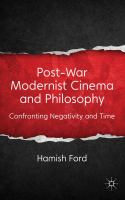 Post-War Modernist Cinema and Philosophy: Confronting Negativity and Time by Hamish Ford (Palgrave Macmillan)
Post-War Modernist Cinema and Philosophy: Confronting Negativity and Time by Hamish Ford (Palgrave Macmillan)
A lecturer in film, media, and cultural Studies at the University of Newcastle, Australia, presents an interdisciplinary study of four exemplary films: Bergman’s Persona, Godard’s Two or Three Things I Know About Her, Resnais’s Last Year in Marienbad, and Antonioni’s L’eclisse. He suggests that they make distinctive contributions to the philosophical understanding of negativity, a discussion for which German philosopher Theodor Adorno’s late work is the main literary source. He believes that his approach demonstrates philosophy’s usefulness for the analysis of modernist cinema and film form’s inherent potential for radical philosophical impact.
n
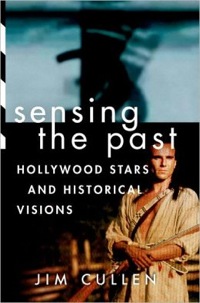
Sensing the Past: Hollywood Stars and Historical Visions by Jim Cullen (Oxford University Press)
A historian at the Ethical Culture Fieldston School in New York City (author of The American Dream: A Short History of an Idea that Shaped a Nation and other books) asks what light the films of six major Hollywood stars cast on how perceptions of past events and the trajectory of history shape humans’ experience of the world. He focuses on Clint Eastwood, Daniel Day-Lewis, Denzel Washington, Tom Hanks, Meryl Streep, and Jodie Foster as exemplars of Hollywood actors’ embodiment of key historical narratives. Says Steven Biel, author of American Gothic: A Life of America’s Most Famous Painting: “It’s unlikely that many of us have thought to connect Dirty Harry to Thomas Jefferson or Bill the Butcher to Frederick Jackson Turner, but somehow Jim Cullen makes such improbable pairings work in this heartfelt, enlightening book. … He deftly reveals how some of our greatest contemporary movie stars have played an important role as public historians.” Agrees Louis P. Masur, author of The Civil War: A Concise History: “Sensing the Past will change the way readers think about movie stars and American history. Through a series of penetrating profiles, Jim Cullen examines how actors have embodied the central themes of our past and weds them to the present.”
n
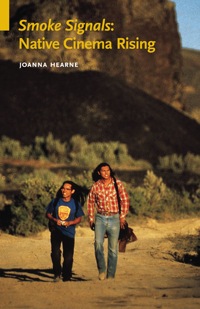
“Smoke Signals”: Native Cinema Rising by Joanna Hearne (University of Nebraska Press)
An associate professor of English and film studies at the University of Missouri–Columbia (Native Recognition: Indigenous Cinema and the Western) makes the case that Smoke Signals, a 198 feature film based on a short-story collection by Sherman Alexie, is a milestone in Native American filmmaking. It was the first wide-release feature film written, directed, coproduced, and acted by Native Americans. It was also the most popular Native American film of all time, and an innovative work of cinematic storytelling. She says it embeds, within a universal story of familial loss and renewal, a variety of uniquely Indigenous perspectives: about political sovereignty, Hollywood’s long history of misrepresentation, and the rise of Indigenous cinema. She includes interviews with Alexie and director Chris Eyre, among others, and explores the film’s audiovisual and narrative strategies. She examines the filmmakers’ appropriation of mainstream American popular culture forms to tell a Native story. She also considers the production and reception of the film.
n
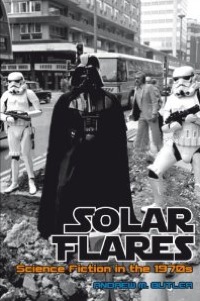 Solar Flares: Science Fiction in the 1970s by Andrew M. Butler (Liverpool University Press, distributed by University of Chicago Press)
Solar Flares: Science Fiction in the 1970s by Andrew M. Butler (Liverpool University Press, distributed by University of Chicago Press)
A highly regarded media and cultural studies scholar at Canterbury Christ Church University who is also a co-editor of the journal Extrapolation examines the rise of fantasy, the sci-fi blockbuster, children’s sci-fi, pseudoscience, and postmodernism. He explores significant figures such as Joanna Russ, Samuel R. Delaney, and Octavia Butler. From Larry Niven’s Ringworld to Thomas M. Disch’s On Wings of Song, from The Andromeda Strain to Flash Gordon, he reclaims 70s science-fiction writing, film, and television – alongside music and architecture – as a crucial period in the history of science fiction, in particular asking how sci-fi reflected class, racial, and other tensions. He covers not only the more mainstream sci-fi writers of the 1970s but also the less well known.
n
November 2012
n
The ‘Evil Child’ in Literature, Film and Popular Culture, by Karen J. Renner (Routledge)
A lecturer in American Literature at Northern Arizona University (author of Perverse Subjects: Drunks, Gamblers, and Prostitutes in Antebellum America, 2011) presents essays about how the ‘evil child’ has infiltrated popular imagination through films, television, and literature. Scholars examine an array of evil children from sociohistorical, cinematic, and psychological perspectives – Tom Riddle in the Harry Potter series, the possessed Regan in William Peter Blatty’s The Exorcist, the monstrous Ben in Doris Lessing’s The Fifth Child, the hostile fetuses of Rosemary’s Baby and Alien, and even the tiny terrors featured in the reality TV’s Supernanny. The book appeared as two special issues of the journal Literature Interpretation Theory.
n
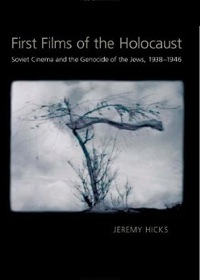 First Films of the Holocaust: Soviet Cinema and the Genocide of the Jews, 1938–1946, by Jeremy Hicks (University of Pittsburgh Press)
First Films of the Holocaust: Soviet Cinema and the Genocide of the Jews, 1938–1946, by Jeremy Hicks (University of Pittsburgh Press)
A senior lecturer in Russian in the School of Languages, Linguistics, and Film at Queen Mary University of London (Mikhail Zoshchenko and the Poetics of Skaz; Dziga Vertov: Defining Documentary Film) encourages a revival of the history in the West of vexed Russian films that, before Western ones, depicted the horrors of Nazi rule, yet were suppressed in both the US and the Soviet Union. Hicks explains that early Western perceptions of the Holocaust drew from newsreels filmed during the Allied liberation of Germany in 1945. But the initial wave of material from Soviet filmmakers, who were the first to document these horrors, was little screened. To assist Soviet leaders in galvanizing its population, the filmmakers emphasized Soviet resistance, “Red funerals,” and calls for vengeance, rather than the Nazis’ persecution of Jews. In fact, the filmmakers recorded almost no personal testimony of victims, nor synchronous sound, which made victims even more remote from viewers.
Hicks analyzes major Soviet depictions of the Holocaust – such as the film Professor Mamlock, which premiered in the United States in 1938 and coincided with the Kristallnacht pogrom – and considers their political context. He examines correspondence, scripts, and reviews, and compares edited with unedited film to reveal how deliberately the Soviet filmmakers concealed Jewish aspects of the German invasion and occupation. He also explains why Soviet Holocaust films have been erased from collective memory in the West and the Soviet Union: their graphic horror, their use as propaganda tools, and the postwar rise of the Red Scare in the United States as well as anti-Semitic campaigns in the Soviet Union.
In his introduction, Hicks writes: “By shifting the focus away from the familiar territory of the 1945 U.S. and British newsreels and to that of Soviet newsreels, documentaries, and features, we can better observe how the unprecedented sights of brutality were grasped within established narrative frameworks. For the Soviets, this meant adapting representations of Nazi atrocities so as to convey a “Soviet” version of the Holocaust, to “Sovietize” it, to claim the victims as their own, a process that can be compared to American filmmakers’ later tendency to “Americanize” the same events.”
Jeremy Hicks describes his archival search, and finds
Some interesting archive issues came up. I began working in the Russian documentary film archive (RGAKFD, Krasnogorsk) in 2000 while researching the films of [Russian pioneer of political documentary and inventor of cinéma vérite] Dziga Vertov [for the book Dziga Vertov: Defining Documentary Film, 2007] and towards the end of that research, around 2005, I began to wonder how the many Soviet films depicting Nazi atrocities related to what we know as the Holocaust and whether they were known and recognised by film historians beyond, or indeed, inside, Russia.
Preliminary readings indicated they were not, and this is where the research grew from.
The challenges of this archive are numerous. Firstly, you need to know Russian to access the full version of the catalogue. Then, while you can search by keyword, the descriptions are incomplete, and are unlikely to make the links you are interested in. Thus, the word ‘Holocaust’ does not exist. You have to search for ‘atrocities’ or other such terms.
The other way in which I searched for materials was simply to take historical sources, published or unpublished, about what had happened and in a given place at a given time, and then to look for films of that place. In this way, searching for and calling up films made of the liberation of towns in which I knew the Nazis had murdered Jews, I was able to find a substantial number of rare or previously unseen images of the Holocaust in the former Soviet Union.
The images I discovered don’t change the historical record, but they enable our perception of it to be shifted. Our view of the Holocaust tends to focus on Poland, the ghettos in Poland, and the extermination camps situated there, and Auschwitz in particular. The killing of over 1.5 million Soviet Jews, the first victims of the systematic killings, has tended not to figure so large in our conceptualisations of the Holocaust.
Partly this is because more people were killed in death camps than by the mobile killing squads, who mostly shot their victims. Partly, it is because this was the Soviet Union and it was not popular to picture the Soviets as victims during the Cold War. Finally though, there was a lack of images with which to convey this story. I hope that finding images which depict the way in which Soviet Jews were made to wear armbands, often herded into ghettos, and then shot, can enable us to accord this important part of the Holocaust its rightful importance.
At the time the Soviets took images of Nazi atrocities to galvanise their own population to resist, showing what might happen to the audience if the Nazis took over. Likewise, where it already had happened, the newsreels called for revenge. Alongside this dimension, and increasing as the war continued was the need to document war crimes for a possible war crimes tribunal. The images specifically of Jews were taken really because there were so many Jewish victims. These were often edited out of the final newsreels, but extraordinarily, in Krasnogorsk they retain the outtakes of these newsreels, that enable us to use the Soviet images, but tell a story rather different than that the Soviets wanted to convey.
The films all came on 35mm prints to be viewed on a Steenbeck [flatbed film editing suite usable with both 16mm and 35mm film], and the archive is more oriented towards people viewing films as a prelude to purchasing footage for documentary films, than for those writing books about such images. The RGAKFD staff were nevertheless always very helpful to me, and ultimately I found it a great place to work.
The paper archives such as The Russian State Archive of Literature and Art (RGALI) in Moscow also contained many treasures, such as unpublished variants of treatments, and correspondence between the cameramen and the studios. These latter materials were sometimes fascinating, especially those of the cameramen at the Auschwitz camp and their overseers in Moscow. Uncovering this was one of the most exciting moments, because much has been said as to the untrustworthiness and staged qualities of the Soviet footage of Auschwitz. The correspondence I uncovered demonstrated the sometimes circumstantial reasons why the footage turned out as it did.
The Auschwitz correspondence illustrates that the cameramen arrived in early February, about a week after the camp was liberated, whereas it is often claimed that they arrived a lot later and reconstructed everything.
They did reconstruct, but the correspondence suggests that this was in part because they had to order lighting apparatus with which to film interiors, and so had to reconstruct the scenes inside the barracks some time later.
The absence of sound interviews is also a flaw in the footage, but the correspondence reveals that the Soviet newsreel men ordered a sound recording van, but it was too far away: and this entirely circumstantial reason explains the absence of interviews with the survivors.
More comments from Jeremy Hicks are online.
He discusses WWII films documenting Nazi atrocities towards Soviet Jews that lay hidden in Russian State Archives for more than 60 years. The clips and out takes are, he believes, the first cinematic representation of the mass extermination of the Jews.
n
The International Strindberg: New Critical Essays edited by Anna Westerstahl Stenport (Northwestern University Press)
Essays on the Swedish playwright also address the films of Lars von Trier.
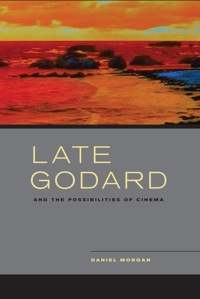 Late Godard and the Possibilities of Cinema, by Daniel Morgan (University of California Press)
Late Godard and the Possibilities of Cinema, by Daniel Morgan (University of California Press)
An assistant professor of film studies at the University of Pittsburgh interprets post-1980 films, some of Godard’s most challenging: Soigne ta droite (Keep Your Right Up, 1987), Nouvelle vague (New Wave, 1990), Allemagne 90 neuf zéro (Germany 90 Nine Zero, 1991), and Histoire(s) du cinema (1988–1998). Morgan offers detailed analyses of extended sequences, technical innovations, and formal experiments to cast light on late Godard’s takes on the role of nature and natural beauty, the relation between history and cinema, and the interactions between film and video. Morgan draws on the idealist and romantic tradition of philosophical aesthetics, which rarely finds an articulation within film studies, to illuminate Godard’s late films and videos. Morgan shows that these works transform the basic terms and categories of aesthetics in and for the cinema.
nn
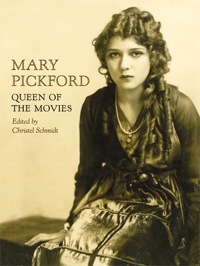 Mary Pickford: Queen of the Movies edited by Christel Schmidt (University Press of Kentucky/Library of Congress)
Mary Pickford: Queen of the Movies edited by Christel Schmidt (University Press of Kentucky/Library of Congress)
Essays new and old by leading early-film historians on the life and legacy of the American actress and philanthropist who galvanized public attention during the early days of cinema, when actors were unbilled and unmentioned in credits. The magnetic talent and appeal of cinema’s first great star riveted audiences. The gifted actress, philanthropist, and savvy industry leader fought for creative control of her films and ultimately became her own producer. The book includes more than 200 illustrations including photographs and stills from the collections of the Library of Congress, rare photographs from Pickford’s archives at the Library and the Academy of Motion Picture Arts and Sciences, and photos of her costumes now held by the Los Angeles Museum of Natural History.
n
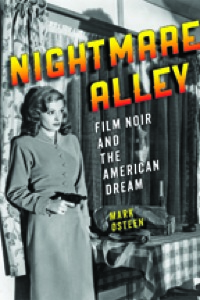 Nightmare Alley: Film Noir and the American Dream by Mark Osteen (Johns Hopkins University Press)
Nightmare Alley: Film Noir and the American Dream by Mark Osteen (Johns Hopkins University Press)
A professor of English and founder of the film-studies program at Loyola University Maryland challenges the notion that film noir merely extols wise-cracking detectives and alluring femmes fatales. Rather, Osteen shows, in the wake of World War II the noir genre tested and ultimately discounted notions of upward mobility, individualism, liberty, equality, and free enterprise. Employing theoretical perspectives from such fields as psychoanalysis, art history, feminism, and music theory, he makes his case by examining such figures as desperate young lovers on the lam (They Live by Night), a cynical con man making a fortune as a mentalist (Nightmare Alley), a penniless pregnant girl mistaken for a wealthy heiress (No Man of Her Own), and a wounded veteran who has forgotten his own name (Somewhere in the Night), all of whom battle uphill through hard work and perseverance to overcome social origins and achieve material success.
n
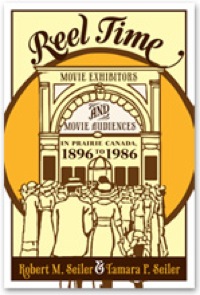 Reel Time: Movie Exhibitors and Movie Audiences in Prairie Canada, 1896 to 1986 (Athabasca University Press), by Robert M. Seiler and Tamara P. Seiler
Reel Time: Movie Exhibitors and Movie Audiences in Prairie Canada, 1896 to 1986 (Athabasca University Press), by Robert M. Seiler and Tamara P. Seiler
An associate professor emeritus of communication and a professor emeritus of Canadian studies at the University of Calgary describe the history of film exhibition in the Canadian Prairie West from the first movie exhibition halls to the digital revolution. Theyhighlight the pivotal role of amusement venues as both a social practice and commercial enterprise that shaped the leisure activities of working- and middle-class people across North America, and in particular propelled the Canadian Prairie West into modernity.
Tamara and Robert Seiler discuss their ambitious project – they launched it in 2000, and say “at times it felt at if we were chronicling the history of western culture” – and discuss difficulties they encountered in working with archives they encountered along their way:
Reel Time charts the growth of movie exhibition as a business venture and – by extension – documents the conditions of moviegoing as a social practice in the Canadian prairies, primarily during the heyday of the indoor, single-screen facility. The book tells the story of those entertainment entrepreneurs who established movie exhibition as a legitimate business in prairie Canada, responded to campaigns to reform the industry, designed safe and comfortable facilities, and founded the national movie theatre chains, namely, Allen Theatre Enterprises, Famous Players, and Odeon Theatres. Reel Time thus examines such business and social topics as theatre design, programming strategies, seating arrangements, pricing policies, marketing schemes, and expansion, with a view to illuminating the centralizing and standardizing processes at work in the commercialization of public leisure-time activities in general and moviegoing in particular.
In formulating our project, we took our cue from those scholars who have studied (to cite Gregory A. Waller) how commercial entertainment in various locales or regions has been packaged, promoted, and consumed, especially Robert C. Allen and Douglas Gomery, who challenged researchers to undertake empirical studies of such topics as moviegoing in their own communities. We also employed qualitative as well as quantitative modes or research, including (1) critical political economy, (2) stylistic typology, and (3) discursive analysis.
Alas, vital materials have disappeared because for a long time people did not take popular entertainment seriously. By the same token, few people left accounts of their moviegoing experience. We therefore cast our net widely, sifting through newspapers and trade journals to uncover information about the movie exhibition business in general and individual entrepreneurs in particular, including when they opened and closed selected facilities. We spent hundreds of hours at microfilm readers, tracking down articles that shed light on movie exhibition and moviegoing. We sifted through city and business directories, which list alphabetically and provide a street-by-street inventory of residences and commercial establishments, plus the names (and the street addresses) of the owners and the managers of movie houses (and, for some periods, distributors and producers), and are thus useful for reconstructing the layout of a business area; public records, such as building permits, fire insurance maps, property tax assessments, building evaluations, and demolition fire reports; corporate records, such as annual statements, reports to stockholders, official (opening) programs, investment circulars, and press releases; architectural plans and building reports; newspapers and motion picture trade papers, which report on the week-by-week operation of movie theatres (and movie theatre chains), in terms of (say) opening day, advertisements for up-and-coming movies, marketing strategies, major renovations, and closing; and local and regional histories, memoirs, interviews, and photographs.
We visited and/or contacted many archives, with a view to tracking down articles, business records, clippings, memoirs, photographs, and tributes, including the Cinémathèque Québécoise library, Montreal; Library and Archives Canada, Ottawa; the Ontario Jewish Archives, Toronto; the Clara Thomas Archives and Special Collections, Scott Library, York University, Toronto; the provincial Manitoba, Saskatchewan, and Alberta provincial archives; city archives in Winnipeg, Brandon, Regina, Saskatoon, Edmonton, and Calgary; and public libraries in Ottawa, Toronto, Brantford, Winnipeg, Brandon, Regina, Saskatoon, Edmonton, and Calgary. At one time, librarians cut out articles on such topics as entertainment in general and moviegoing in particular, e.g., articles on the opening and the closing of individual movie theatres. These served as a useful point of departure.
Overall, our experiences with these archives were very positive. The archivists were unfailingly helpful. The major problem we encountered was the paucity of materials on movie going and on the movie exhibition business. We assume, as mentioned above, that this problem reflects the fact that until recently, many aspects of popular culture, including movies, were not regarded as worthy of serious study. Many involved in the exhibition business likely didn’t think of depositing materials with archives, and many archivists likely didn’t make a great effort to collect such material. Another problem area for us was that of archival photographs. Problems included the difficulty of finding appropriate photographs of a quality suitable for digitalization, the difficulty of securing permission to publish photos and, in some cases, the expense involved.
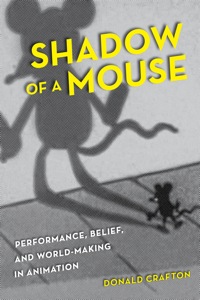 Shadow of a Mouse: Performance, Belief, and World-Making in Animation, by Donald Crafton (University of California Press)
Shadow of a Mouse: Performance, Belief, and World-Making in Animation, by Donald Crafton (University of California Press)
A professor of film, television, and theater at the University of Notre Dame, Crafton (The Talkies: American Cinema’s Transition to Sound, 1926-1931) draws on film and theater studies, art history, aesthetics, cultural studies, and performance studies to express his view of animated cinema’s systems of belief and world making. He asks: Are animated characters actors and stars, just like humans? Why do their performances seem live and present, despite our knowing that they are drawings? Why is animation obsessed with distressing the body? Why were California regional artists and Stanislavsky so influential on Disney? Why are the histories of animation and popular theater performance inseparable? How was pictorial space constructed to accommodate embodied acting? Do cartoon performances stimulate positive or negative behaviors in audiences? Why is there so much extreme eating? And why are seemingly insignificant shadows vitally important? Claiming that no convincing answers to such questions have been formed into principles of the construction, execution, and reception of cartoons, Crafton ranges from classics like The Three Little Pigs to contemporary works by Vankmajer and Plympton to propose that performance is the common touchstone of the cinematic form.
n
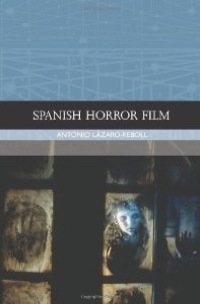 Spanish Horror Film by Antonio Lazaro-Reboll (Edinburgh University Press, distributed by Columbia University Press).
Spanish Horror Film by Antonio Lazaro-Reboll (Edinburgh University Press, distributed by Columbia University Press).
A lecturer in Hispanic studies at the University of Kent who earlier edited Spanish Popular Cinema (2004) and Cult Movies: The Cultural Politics of Oppositional Taste (2003), now published the first in-depth study in English of the Spanish horror genre since the horror boom of the late 1960s and 70s. He examines production, circulation, regulation, and consumption in relation to broader historical and cultural shifts in Spanish history and as an important part of the European horror film tradition and the global culture of psychotronia. Through the work of such filmmakers as Jesús Franco, Amando de Ossorio, Narciso Ibáñez Serrador, Eloy de la Iglesia, Jaume Balagueró, Nacho Cerdá and Guillermo del Toro, he explores key directors, cycles, representative films, and obscure and neglected horror production. He also considers reception of the genre in Spain, Great Britain, and the United States.
October 2012
n
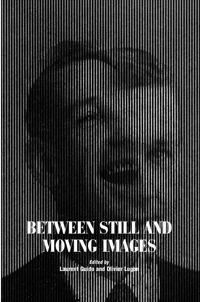 Between Still and Moving Images: Photography and Cinema in the 20th Century, by Laurent Guido and Olivier Lugon(John Libbey Publishing, distributed in the US and Asia by Indiana University Press)
Between Still and Moving Images: Photography and Cinema in the 20th Century, by Laurent Guido and Olivier Lugon(John Libbey Publishing, distributed in the US and Asia by Indiana University Press)
In this English translation of their Fixe/animé: Croisements de la photographie et du cinéma au XXième siècle, from 2010, Laurent Guido, a scholar of film history and aesthetics and Olivier Lugon, an art historian, both at the University of Lausanne consider the implications for photography and cinema of the shift to digital technologies. One of the unexpected consequences, they suggest, is that suddenly the categories of still images and moving images have collapsed. They ask whether still images have become a subcategory of animation due to the reproducibility of both on the one kind of machine that permits, at a keystroke, progressing at variable speeds from one form to the other. They suggest that the repercussions of this technological shift are palpable in many domains, from amateur practices to the information sector.
Among topics Lugon and Guido cover are the philosophical, psychological, and aesthetic debates regarding photography and cinema at the turn of the twentieth century, and the way the two media modeled conceptions of movement, duration, and the moment. They explore extinct forms that combined cinema and photography, and the way that print media brought together cinema and photography, especially during the interwar period. They look at the relations of cinema’s freeze frame to memory, history, and trauma in the decades after World War II. And they look at the implications of the collapse of the forms in the visual culture of the last decades of the 20th century.
n

Blockbuster History in the New Russia: Movies, Memory, and Patriotism by Stephen M. Norris (Indiana University Press)
An associate professor of history at Miami University of Ohio (A War of Images: Russian Popular Prints, Wartime Culture, and National Identity) describes what happened when directors and producers sought to rebuild the Russian film industry after its post-Soviet collapse. That, says Norris, sparked a revival of nationalist and patriotic sentiment by applying Hollywood techniques to themes drawn from Russian history. Ironically, even though they were unsettled by the government’s move toward market capitalism, Russians embraced these historical blockbusters, packing the American-style multiplexes that sprouted across the country. He situates the films in their political, economic, and social contexts to paint a fascinating picture of present-day Russia.
n
n
n
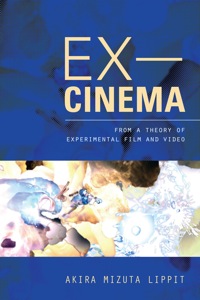 Ex-Cinema: From a Theory of Experimental Film and Video, by Akira Mizuta Lippit (University of California Press)
Ex-Cinema: From a Theory of Experimental Film and Video, by Akira Mizuta Lippit (University of California Press)
A professor of cinematic arts, comparative literature, and East Asian languages and cultures at the University of Southern California (Atomic Light (Shadow Optics) and Electric Animal: Toward a Rhetoric of Wildlife) reflects on the ways in which experimental media artists move outside the conventions of mainstream cinema and initiate a dialogue on the meaning of cinema itself. While contemplating the philosophical implications of experimental film and video, Lippit considers such artists as Derek Jarman, Matthias Müller, Maya Deren, Su Friedrich, and Diane Thater.
n
n
n
a
Existentialism and Contemporary Cinema: A Beauvoirian Perspective edited by Jean-Pierre Boule & Ursula Tidd (Berghahn Books)
Essays in this volume draw on de Beauvoir’s writing to examine films by such directors as Claire Denis, Michael Haneke, Sam Mendes, Sally Potter, and Lucille Hadzihalilovic. Not generally associated with film studies, de Beauvoir was nonetheless the first feminist thinker to inaugurate the concept of the gendered “othering” gaze. Moreover, argue the essayists, other concepts associated with Beauvoirian existentialism such as ambiguity, gendered alienation, situated freedom, and woman as absolute Other are highly suggestive for reading screen culture. The authors demonstrate how “existential” themes continue to resonate with contemporary stars and film directors, and add value and meaning to the basic questions about human existence, and the quest for “authenticity.”
n
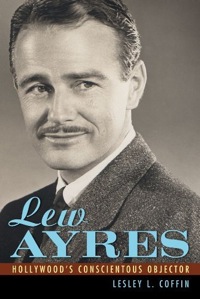 Lew Ayres: Hollywood’s Conscientious Objector by Lesley L. Coffin (University Press of Mississippi)
Lew Ayres: Hollywood’s Conscientious Objector by Lesley L. Coffin (University Press of Mississippi)
An independent scholar’s biography of a man of quiet dignity torn between the public world of Hollywood and a secluded life of spiritual introspection. Ayres (1908-1996) became known when he portrayed the lead character in the epic war film All Quiet on the Western Front. That brought him fame, not satisfaction, so he spent the rest of his life pursuing intellectual interests and hobbies, and to consider quitting acting to pursue a more “respectable and fulfilling” path as a director. He made two comebacks, in 1938 and 1945, first in the film series Dr. Kildare. But he was willing to give up his star status and follow his moral compass, as a conscientious objector and then noncombat medic during World War II. At its end, despite his objector status, he was welcomed back to Hollywood. Coffin, who is the New York correspondent for Filmoria.co.uk, is also writing two other books, “Hitchcock’s Stars: Alfred Hitchcock and the Hollywood Star System” and an as-yet-untitled Bruno Kirby biography.
Leslie Coffin talks about her archival research
I made every attempt to locate the available work by Lew Ayres in multiple libraries. If I could suggest one thing, an update to WorldCat is very necessary, to determine who has what materials (and in what format).
The difficulty I found is that despite several being available, finding copies which could be made available for viewing was a challenge (for example, there were archival or vault nitrate copies, but no way to view them). The other major challenge I found was contacting the correct individuals who could offer guidance to their archival resources. Once those librarians or archivists were available to speak with by phone or email, planning a research trip could be scheduled with a reasonable amount of time to conduct all research. But there were several times that trips were planned and materials weren’t ready or available and it would have made more financial sense to reschedule the trip when all materials were available to view in a concentrated one-to-two-day period.
I had remarkable assistance from film archives throughout the country, but these are just some of the challenges facing independent scholars who are financing much of their own research.
n
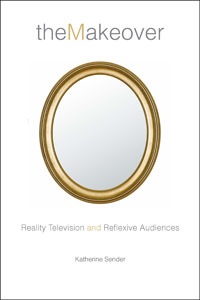 The Makeover: Reality Television and Reflexive Audiences by Katherine Sender (New York University Press)
The Makeover: Reality Television and Reflexive Audiences by Katherine Sender (New York University Press)
A professor of film, television, and media studies at the University of Auckland draws on feminist cultural studies to analyze audience reactions to The Biggest Loser and other “makeover” shows. She considers their (unmet) promise of self-renewal and reinvention and the media, technological, and economic contexts of a long history of self-improvement. She pays particular, and rare, attention to the people who watch them, and to their far greater critical reception of the programs than they are usually accorded. Sender is also editing a new documentary, Brand New You: Makeover Television and the American Dream, which will be distributed by the Media Education Foundation.
n
n
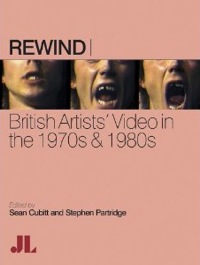 REWIND| British Artists’ Video in the 1970s & 1980s, edited by Sean Cubitt & Stephen Partridge (John Libbey Publishing, distributed in the US and Asia by Indiana University Press)
REWIND| British Artists’ Video in the 1970s & 1980s, edited by Sean Cubitt & Stephen Partridge (John Libbey Publishing, distributed in the US and Asia by Indiana University Press)
This lavishly illustrated anthology derives from a four-year research project into the history of the now well-evolved art form, and draws on an archive of interviews, ephemera, and archive copies of tapes and installations from the pioneering period of British video art. Authors include leading scholars in the field and a panel of expert practitioners who have set out to lay the groundwork for a history of the people, activities, institutions, and interventions that made video art an avant-garde form in 20th century Britain. The Unwind project aims to open the archive for contemporary artists, curators, media historians, and archivists, including practitioners of the growing field of media art history, archiving, and conservation.
Stephen Partridge, who was the project’s principal researcher, was a participant in the landmark video shows of the 1970s. A longtime educator, he is a professor of media art and dean of research at the University of Dundee. Sean Cubitt, of the University of Melbourne but currently at Goldsmiths, University of London, is the author of EcoMedia, 2005; The Cinema Effect, 2004; Simulation and Social Theory, 2001; Digital Aesthetics, Theory, 1998; Videography: Video Media as Art and Culture, 1993; and Timeshift: On Video Culture, 1991.His current research is on public screens and the transformation of public space, and on genealogies of digital light.
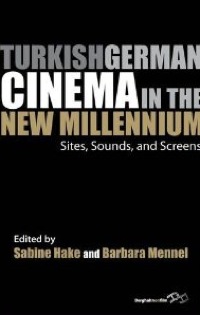 Turkish-German Cinema in the New Millennium: Sites, Sounds, and Screens edited by Sabine Hake and Barbara Mennel (Berghahn Books)
Turkish-German Cinema in the New Millennium: Sites, Sounds, and Screens edited by Sabine Hake and Barbara Mennel (Berghahn Books)
The first published collection of essays about the variety of little studied Turkish-German films and their methodologies. The authors discuss an explosion of such films, made by second- and third-generation descendants of so-called guest workers, during the last five years of the twentieth century. The films cite and rewrite American gangster narratives, Kung Fu action films, and other emergent European minority cinemas.
Barbara Mennel says about her and Sabine Hake’s research
In general, when working on recent contemporary film across different national contexts, the difficult issues concern less questions of access to archives but more so access to film festivals and the difficulty of locating small production and distribution companies to receive copies of films for research, either if they do not enter mainstream distribution at all or before they are publicly available.
n
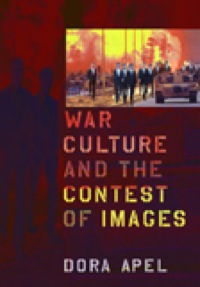
War Culture and the Contest of Images by Dora Apel (Rutgers University Press)
A Wayne State University art historian (author of Memory Effects: The Holocaust and the Art of Secondary Witnessing and Imagery of Lynching: Black Men, White Women, and the Mob) analyzes the relationships among contemporary war, methods of documenting events, and democratic ideals in photography, performance art, video games, and other media in the United States and the Middle East. In the process, she explores the merging of photojournalism and artistic practices, the effects of visual framing, and the construction of narratives in a global contest of images, particularly at a time when the wide variety of visual and documentary practices present realities that would otherwise be invisible or officially off-limits.
n
n
September 2012
a
Gothic Music: The Sounds of the Uncanny by Isabella van Elferen (University of Wales Press, distributed by University of Chicago Press)
An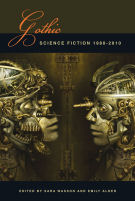 assistant professor of music and new media at Utrecht University analyzes the relations of music and sound to the gothic in literature, film, television, and video games – the spectral beings of early cinema, virtual terrors in video games – as well as the Goth subculture.
assistant professor of music and new media at Utrecht University analyzes the relations of music and sound to the gothic in literature, film, television, and video games – the spectral beings of early cinema, virtual terrors in video games – as well as the Goth subculture.
n
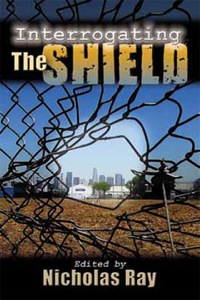 Interrogating “The Shield” edited by Nicholas Ray (Syracuse University Press)
Interrogating “The Shield” edited by Nicholas Ray (Syracuse University Press)
Essays on a record-breaking FX cable drama series that aired from 2002 to 2008 and portrayed a special Strike Team of the Los Angeles Police department. Essayists in this volume assess the US and international impact of its dystopian depiction of American urban life, politics, and juridical corruption. Topics range from an exploration of the series’ derivation, genre, and production, to expositions of its ethics, aesthetics, and politics. The show is variously applauded and critiqued but overall acknowledge the series’ cultural significance and creative complexity.
n
n
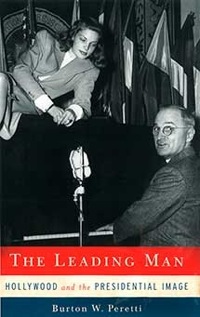 The Leading Man: Hollywood and the Presidential Image by Burton W. Peretti (Rutgers University Press)
The Leading Man: Hollywood and the Presidential Image by Burton W. Peretti (Rutgers University Press)
A Western Connecticut State University historian explores the ways in which American presidents and Hollywood have interacted since the 1920s. He suggests that the relationship has made American entertainment more political while it has at the same time led political leadership to become more and more aligned with the world of movies and movie stars. He shows that chief executives have been able to position themselves as cultural leading men from the time of George Washington, who in the young republic was a charismatic figure – a star – and symbol of national survival and wish fulfillment.
Peretti considers the star power of 14 presidents of the cinematic era, from Herbert Hoover to Barack Obama. He argues that since the 1920s, the president has been like a lead movie actor at the center of the political stage. Lead movie actors have taught presidents how to look and behave, what to say, and how to say it. Some presidents, like John F. Kennedy and Richard M. Nixon, took particular care to learn from the grooming, gestures, movements, and vocal inflections of film actors. Ronald Reagan was a professional actor. Bill Clinton, a child of the post–World War II Baby Boom, was a diehard movie fan.
Peretti examines the evolution of presidents’ image consciousness as they increasingly have hired image and advertising consultants to stage their cinematic public events. Movies, he suggests, have been the main force in promoting appearance and drama over the substance of governing, while Americans’ lives today often are dominated by entertainment at the expense of civic engagement.
In an interview in U.S. News and World Report, Peretti said that what striking about links between the White House and Hollywood was “not simply presidents watching movies or Americans seeing presidents and movie stars on the same page in the newspaper. Everyone’s looking at everyone else and interacting in a certain way, in different ways. And certainly the times were very dramatic, too. I mean, World War II, Vietnam, Watergate—all of those have an influence on the cinematic presidential image as well.”
n
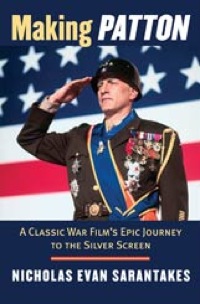 Making “Patton”: A Classic War Film’s Epic Journey to the Silver Screen, by Nicholas Evan Sarantakes (University Press of Kansas)
Making “Patton”: A Classic War Film’s Epic Journey to the Silver Screen, by Nicholas Evan Sarantakes (University Press of Kansas)
A scholar of strategy at the U.S. Naval War College traces the production history of the biopic, which featured George C. Scott’s searing portrayal of General George S. Patton, and won seven Oscars in 1971, including Best Picture and Best Actor. It grossed $60-million even though it appeared during a period of anti-war sentiment that endeared critics to another, very different film of that year, M*A*S*H. Sarantakes writes about such issues as why the film almost didn’t get made. He recounts the trials that attended the epic efforts of producer Frank McCarthy—like Patton a U.S. Army general—and Twentieth Century Fox during the film’s 18 years of planning and production. Sarantakes discusses such issues as the reluctance of Patton’s family, copyright issues with biographers, competing efforts for a biopic, and Department of Defense red tape. He chronicles the long search for a leading man—including discussions with Burt Lancaster, John Wayne, and even Ronald Reagan—before settling on Scott, who identified with Patton’s passionate personality. He tracks the production’s challenging multinational cast, huge outlays for military equipment, and filming in six countries over a mere six months.
Sarantakes draws on the papers of Frank McCarthy and director Franklin Schaffner, studio archives, records of the Academy of Motion Picture Arts and Sciences, contemporary journalism, and oral histories. Dennis Showalter,author of Patton and Rommel: Men of War in the Twentieth Century, recommends the book as “a model synergy of cinematic and historical analysis that reveals Patton as both an iconic marker of America’s mythic self-image in the post-World War II era and a sophisticated meditation on the challenges of command in the crucible of war.”
n
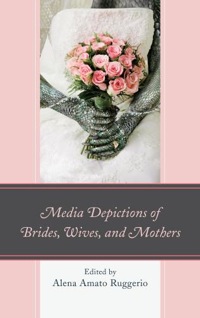
Media Depictions of Brides, Wives, and Mothers edited by Alena Amato Ruggerio (Lexington Books)
Essays explore how television, film, the internet, and other media variously perpetuate gender stereotypes. Includes studies of Bridezillas, Jon & Kate Plus 8, Sex and the City, Sarah Palin, Nancy Pelosi, The Devil Wears Prada, Practical Magic, “momtini” blogs, and Mad Men fan websites.
n
 Spanish Spaces: Landscape, Space, and Place in Contemporary Spanish Culture by Ann Davies (Liverpool University Press, distributed in the US by University of Chicago Press)
Spanish Spaces: Landscape, Space, and Place in Contemporary Spanish Culture by Ann Davies (Liverpool University Press, distributed in the US by University of Chicago Press)
A senior lecturer in Spanish at Newcastle University draws on literature and film, viewed in the context of the variousness of Spain’s terrains and their interactions – rural, urban, coastal – to explore modern Spain’s sense of its its geographical and spatial understanding of itself.
n
Specters of War: Hollywood’s Engagement With Military Conflict by Elisabeth Bronfen (Rutgers University Press)
A professor of English and American studies at the University of Zurich (Home in Hollywood: The Imaginary Geography of Cinema) looks at Hollywood’s emergence as a place where national narratives are created and circulated to provide audiences with fantasies, ideologies, and anxieties keyed to political climates of various times. She suggests that while few Americans access war through direct experience, most consume images and narratives that transmit and interpret it for them. She refers to All Quiet on the Western Front, The Best Years of Our Lives, Miracle at St. Anna, The Deer Hunter, Flags of Our Fathers, and other films that convey battles and campaigns, the home front and women-who-wait narratives, war correspondents, and court martials. She argues that viewers are haunted by past wars and by cinematic re-conceptualizations of them, and she explores a captivating national iconography of redemptive violence.
n
Uses of Austen: Jane’s Afterlives edited by Gillian Dow and Clare Hanson (Palgrave Macmillan)
Essays on ways the life and work of Jane Austen is re-framed and re-imagined in literature and popular culture, including in the Bollywood film Bride and Prejudice.
n
August 2012
a
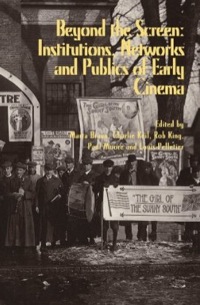 Beyond the Screen: Institutions, Networks and Publics of Early Cinema, edited by Marta Braun, Charles Keil, Rob King, Paul Moore, and Louis Pelletier (John Libbey Publishing, distributed in the US by Indiana University Press)
Beyond the Screen: Institutions, Networks and Publics of Early Cinema, edited by Marta Braun, Charles Keil, Rob King, Paul Moore, and Louis Pelletier (John Libbey Publishing, distributed in the US by Indiana University Press)
n
 The Cinema and Cinema-Going in Scotland, 1896-1950 by Trevor Griffiths (Edinburgh University Press, distributed by Columbia University Press)
The Cinema and Cinema-Going in Scotland, 1896-1950 by Trevor Griffiths (Edinburgh University Press, distributed by Columbia University Press)
An economic and social historian at the University of Edinburgh presents the first study of Scots’ film-going habits of the early 20th century and sets them in social and historical context. He asks such questions as what Scots saw at the cinema; what was available and why; what was the experience like? Griffiths draws extensively on archival resources concerning the business and management of cinema, including diaries and recollections of attendees. Fans’ reports provide insight into patterns of cinema-going and attendance levels, as well as changes in audience preferences for different genres, stars, and national origins of films. On his website, Griffiths says: “In recent years, I have turned a long-standing passion for old, black and white films into a research interest, enabling me to justify long hours spent watching the films of Charlie Chaplin, Buster Keaton, and Laurel and Hardy, among others.”
Trevor Griffiths describes his research:
There had been very little work done on the primary documentation of Scottish film or cinema prior to the book, so all sections made heavy reliance on archival resources.
The films themselves in most cases sadly (from an academic, but probably not an aesthetic point of view) no longer exist. However, through detailed use of the Scottish trade press, I was able to discover four more titles of films that were previously, and probably deservedly if the press notices are to be believed, unknown.
The book therefore makes extensive use of paper archives, particularly at the Scottish Screen Archive, built up over the last 35 years or so by Janet McBain and her splendid staff. This is a great resource, bringing together many private papers as well as the records of national bodies, such as the Scottish Film Council.
The Archive also has records of individual businesses, which I was able to supplement with material in the National Archives of Scotland in Edinburgh, including returns to the Register of Dissolved Companies, which provides information on the finances and ownership patterns of many cinema businesses, and the records of important cinemas, including the largest cinema in Edinburgh, the Playhouse, with records of weekly attendances and films shown from its opening in 1929 to 1973.
The National Archives also contain valuable legal records, enabling me to reconstruct in some detail the production history of one lost Scottish film, the memorably titled Football Daft, which was the subject of a breach of copyright action.
The records of the Scottish Home Department were useful in reconstructing the debate over the Sunday opening of cinemas, an ongoing debate across the first half of the century.
The book also makes use of archives in Glasgow, Cumbernauld, Dundee, and London to broaden the coverage. The Cinema Museum in Lambeth, London, contains important documentation on early cinema in Aberdeen.
Finally, I made use of material in private hands when, after a seminar paper given in Glasgow, I was contacted by a former Glasgow resident, now living in Italy, who had her mother’s diaries from the 1920s and 1930s, which referred to her cinema-going and even made reference in some cases to the films she saw and her opinion of them.
It’s tempting to think that there is more of the same out there in private hands.
n
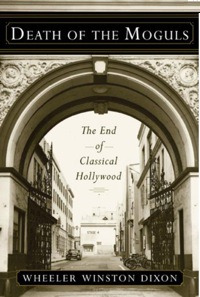 Death of the Moguls: The End of Classical Hollywood by Wheeler Winston Dixon (Rutgers University Press)
Death of the Moguls: The End of Classical Hollywood by Wheeler Winston Dixon (Rutgers University Press)
A film-studies scholar at the University of Nebraska at Lincoln who is the author of such books as 21st Century Hollywood: Movies in the Era of Transformation (with Gwendolyn Audrey Foster), A History of Horror, and Film Noir and the Cinema of Paranoia (all Rutgers University Press), examines the final years of the studio system and such legendary bosses as Louis B. Mayer and Jack L. Warner. He assesses the last days of the “rulers of film” – such film-empire moguls as Harry Cohn at Columbia, Louis B. Mayer at MGM, Jack L. Warner at Warner Brothers, Adolph Zukor at Paramount, and Herbert J. Yates at Republic. He asserts that because they made the studios through their sheer force of personality and business acumen, their deaths or departures hastened the studios’ collapse. Why? Because almost none cultivated leaders to succeed them because they couldn’t imagine studios without them.
Dixon introduces many studios and their bosses of the late 1940s, just before the studios collapsed, and describes their last productions as they headed towards their demise in the late 1950s and early 1960s. He details such game-changing factors as the de Havilland decision, which made actors free agents; the Consent Decree, which forced the studios to get rid of their theaters and slash their payrolls; how the moguls dealt with their collapsing empires in the television era – by shifting to 3D, color, and CinemaScope; and the end of the conventional studio assembly line, where producers had rosters of directors, writers, and actors under their command.
In his “lucid and penetrating account,” as film scholar Steven Shaviro of Wayne State University puts it, Dixon also describes what came next: the switch to television production and some distribution of independent film.
n
European Civil War Films: Memory, Conflict, and Nostalgia, by Eleftheria Rania Kosmidou (Routledge)
A lecturer in film studies at the University of Salford, in the UK, discusses late 20th-century films about the Irish, Spanish, Greek, and Yugoslavian civil wars. Kosmidou considers debates relating to cultural memory and investigates the ways in which films may present an idealized past that glosses over the wars’ reality, even producing, say, nostalgic or melancholic portraits of loss and longing.
n
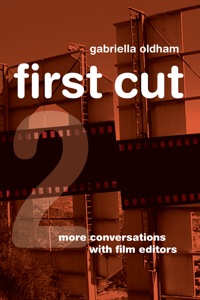
First Cut 2: More Conversations with Film Editors, by Gabriella Oldham (University of California Press)
Twenty years after her First Cut: Conversations with Film Editors, a freelance writer (Keaton’s Silent Shorts) presents a second collection of 12 interviews with award-winning film editors—fiction and documentary—to discuss the art and craft of editing and to explore the transition from the age of celluloid to the digital age. Her new volume explores the transition of editing from the age of celluloid to the digital age. Her subjects offer detailed practical examples from their films to explain their process as well as their challenges. In addition to fiction and documentary editors, Oldham interviews an independent filmmaker/editor to emphasize current opportunities for aspiring filmmakers to make their own “small films.”
n
n
n
Marx and Freud in Latin America: Politics, Psychoanalysis, and Religion, by Bruno Bosteels (Verso)
In 10 case studies, a professor of Romance studies at Cornell University (The Actuality of Communism; Badiou and Politics) studies the impact of Marx and Freud on Latin American culture as gauged in literature, cinema, theater, and other artistic realms.
n
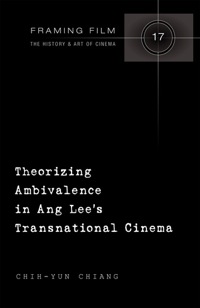
Theorizing Ambivalence in Ang Lee’s Transnational Cinema, by Chih-Yun Chiang (Peter Lang Publishing)
A study of the representation of Chinese identity in the Taiwan-born director’s films including Crouching Tiger, Hidden Dragon and Lust, Caution and their reception among a variety of kinds of audience in Taiwan, Mainland China, Hong Kong, and the Chinese diaspora. Chiang, who has taught at the University of Denver and the College of Charleston,challenges such concepts as “Chineseness” that ignore the variety of cultural views of national identity in Chinese regions and their diaspora. She also explains why they contribute to ambivalence towards the West.
n
July 2012
n
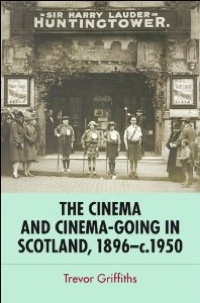 Cinema and Inter-American Relations: Tracing Transnational Affect by Adrian Perez Melgosa (Routledge)
Cinema and Inter-American Relations: Tracing Transnational Affect by Adrian Perez Melgosa (Routledge)
An assistant professor of Hispanic languages and literature at the State University of New York at Stony Brook examines commercial narrative films’ role in political and cultural relations between the United States and Latin America since the “Good Neighbor” policy was put in place in 1933. Pérez Melgosa highlights a continued cinematic conversation about a cluster of shared allegories representing the continent and its cultures, and contends that cinema has become a virtual contact zone for debates about the articulation of Anglo, Latin American, and Latino identities.
n
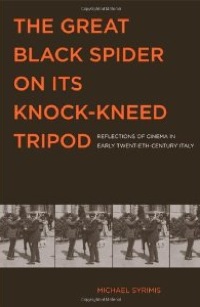
The Great Black Spider on Its Knock-Kneed Tripod: Reflections of Cinema in Early Twentieth-Century Italy by Michael Syrimis (University of Toronto Press)
An assistant professor of French and Italian at Tulane University explores how the emergence of cinema as a predominant form of mass entertainment in the 1910s inspired intellectuals to rethink their definitions of art. He traces Italy’s writers’ encounters with cinema to offer new perspectives on the country’s early twentieth-century culture. As he seeks to demonstrate the extent to which cinema enforced or neutralized ideological and aesthetic dimensions, he looks in particular at the work of Filippo Tommaso Marinetti, founder of Futurism; Gabriele D’Annunzio, leader of Italian Decadentism; and Luigi Pirandello, a father of modern European theatre and theorist of humour.
n
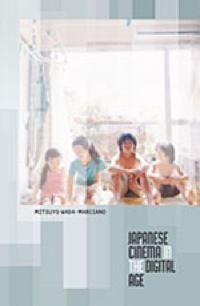
Japanese Cinema in the Digital Age by Mitsuyo Wada-Marciano (University of Hawai’i Press)
An associate professor of film studies at Carleton University in Ottawa explores the role of globalization in the mainstreaming of anime, J-horror, personal documentary, and ethnic cinema. She suggests that Japanese films have reached a global market thanks to digital technology. In an example of “convergence culture” and its role in mingling the flows of global economics and culture, digitization has transformed cinema’s production, distribution, and consumption patterns, she contends. It has revitalized a once-moribund industry with regional genres such as anime and Japanese horror that now challenge Hollywood’s preeminence. She also suggests that, despite the convergence of cinema cultures, where transnational culture has become a form of cosmopolitanism, national production remains key to innovations. She draws on interviews with such directors as Kore’eda Hirokazu, Kurosawa Kiyoshi, and Kawase Naomi, and challenges the assumption that Hollywood’s is the only “global” cinema.
Wada-Marciano’s earlier books were Nippon Modern: Japanese Cinema of the 1920s and 1930s (University of Hawai’i Press, 2008) and, as co-editor, Horror to the Extreme: Changing Boundaries in Asian Cinema (Hong Kong University Press, 2009). She is currently at Kyoto University conducting research for a book on the cinema in post-Occupation Japan, 1952-1960.
Mitsuyo Wada-Marciano answers some questions about her research
Was it difficult to find the films needed for your book project?
My book targets films from the end of the studio period (which ended arguably in the late 1980s) to the present. Therefore, many of the films, especially produced after 1996, the year when DVD became accessible to general consumers, are relatively easy to purchase in the DVD form. Compared with my previous book on the 1920s and 1930s cinema, Nippon Modern (2008), I had less difficulty this time to find the films I wanted to view. But rather the difficulty was that there are too many films/DVDs to choose from. I wanted to elaborate the tendency in popular genre films, such as “J-horror” or “anime,” to be distributed and consumed via multiple platforms, not only through theaters. I simply needed to watch literally anything in the video stores, like the Japanese franchise TSUTAYA. It was a luxurious burden to select a few films from so many to thoroughly analyze for each chapter. One side benefit was I acquired a substantial amount of content for teaching updated courses on contemporary Japanese and even other East Asian films.
Were you able to access good archives for your project, and can you tell us a little about them?
As academic writing tends to be slower than journalistic writing, the major film archives are not keen to collect the contemporary films in Japan. That is why I decided to meet the filmmakers and have interviews instead. They made their films available for me in digital form. Once I established trust with them, they were willing to let me view their as yet unreleased works. Director Kore’eda Hirokazu, for instance, started his career as a documentary maker for television, and his documentaries are not widely accessible. Therefore, I asked to view them during my interview with him. I did the same with another director Kawase Naomi, when I visited her office in Nara, Japan. My ideas about her documentary Tarachime (2006) came to me while watching it with her manager, Sakamoto-san, in her office. It is something of a paradox that the interviews with filmmakers often revolved around practical matters of filmmaking, which were of little use to my book. However, in an indirect fashion the process sometimes gave me unexpected insights.
As for animation, I was able to find many texts available at YouTube and/or Nico Nico Douga, and I am sure there are more video sharing websites that I am not aware of.
Anything else archives-related come to mind? In the case of your book, perhaps you had unusual or telling experiences searching Japanese archives that you could relate?
I think if I may talk about my current book project on the post-Occupation cinema in the 1950s, I could probably elaborate more on the aspects of searching Japanese archives. My research schedule usually begins at the National Film Center in Tokyo to find out if they have the films available for viewing. The center’s homepage has the search engine for the film database. The downside of the film archive is that viewing films there is quite expensive. If you are affiliated with any Japanese universities or equivalent educational institutions, you can get a fifty percent discount, but if you are from outside Japan, you need to pay the full amount, which is approximately US$125 per hour. You must also book your screening at least three weeks in advance, since they need to bring the films from their preservation branch in Sagamihara. I, therefore, often end up searching alternative archives such as The Museum of Kyoto, Tokushima Prefectural Archive, International Research Center for Japanese Studies in Kyoto, and Waseda University Library. As for printed media, books and film journals in Japanese, I often go to The Tsubouchi Memorial Theater Museum at Waseda University, where the price of copying is still reasonable and extensive printed materials are available. The Theater Museum is nice and open to public.
I imagine that digitization has changed the nature of availability, but are Japanese producers well organized when it comes to archiving and research access?
To my knowledge, neither producers nor even film companies such as Toho, Shochiku, and Toei, are interested in archiving or making their films accessible to researchers in Japan. Although they are very keen to protect their content properties, this is all for making profits. I have been working as a specialist of Japanese cinema and visual culture for more than a decade, and yet I have had very little contact with producers and film companies. The only exception was a producer in Shochiku Co., Yamamoto Ichiro, who had worked as a producer of Hou Hsiao-Hsien’s films.
n
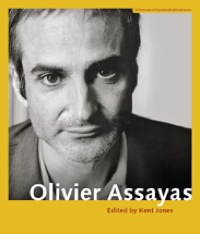
Olivier Assayas edited by Kent Jones (Austrian Film Museum, distributed by Columbia University Press)
Jones edition of essays about Essayas is the first English-language book about the contemporary French director, whose films include Désordre (1986), Irma Vep, demonlover, L-Heure d’été, L’Eau froide, Les Desinées Sentimentale, and Carlos. Assayas’s memoir, which deals extensively with politics after the turmoil of 1968, is appearing as a companion book to Jones’s volume. The essays that Jones has collected include a major essay based on his two decades of correspondence and exchanges of ideas with the filmmaker, as well as contributions from Assayas and his most important artistic collaborators. The filmmaker and writer Kent Jones has since 2009 been the executive director of The World Cinema Foundation who writes regularly for Film Comment and many other publications. In 2007 a selection of his writings, Physical Evidence, appeared from Wesleyan University Press. He has worked with Martin Scorcese on many projects and documentary films including My Voyage to Italy (1999), Val Lewton: The Man in the Shadows (2007) which he wrote and directed, and the Emmy-nominated and Peabody Award-winning A Letter to Elia (2010). He is preparing a feature film, It Never Entered My Mind, for the winter of 2012.
n
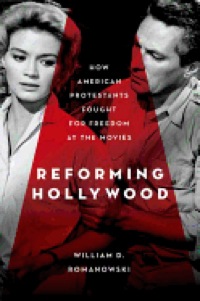 Reforming Hollywood: How American Protestants Fought for Freedom at the Movies by William D. Romanowski (Oxford University Press)
Reforming Hollywood: How American Protestants Fought for Freedom at the Movies by William D. Romanowski (Oxford University Press)
Film history is filled with studies of how Jews and Catholics influenced the course of the movie industry; this book is being hailed as the first full-fledged treatment of the role of Protestantism in Hollywood. Romanowski, a professor of communication arts and sciences at Calvin College (Eyes Wide Open: Looking for God in Popular Culture and Pop Culture Wars: Religion and the Role of Entertainment in America Life), explains the complex relation of the two institutions. He shows that many, varied religious forces have played roles in Hollywood, from Presbyterians and Episcopalians to fundamentalists and evangelicals, and that far from being censorious, American Protestants have for a century had a formative, complex, often cooperative relationship with Hollywood through commissions, councils, and representatives seeking to use film to promote moral health. He draws on his interviews as well as previously untouched sources to describe how mainline church leaders lobbied filmmakers to promote the nation’s moral health and, perhaps surprisingly, how they have by and large opposed government censorship, preferring instead the “human choice that is the basis of our religion” by the industry and individuals. Romanowski also describes tensions with Catholics because many Protestant clergy feared the influence of the Legion of Decency more than Hollywood’s corrupting power. Romanowski shows that the rise of the evangelical movement in the 1970s radically altered the picture, in contradictory ways. Even as born-again clergy denounced “Hollywood elites,” major studios noted the emergence of a lucrative evangelical market. In Comment, Byron Borger called Romanowski’s volume “one of those important books which may change the discourse in a discipline. It is erudite, inspiring, meticulously researched.”
n
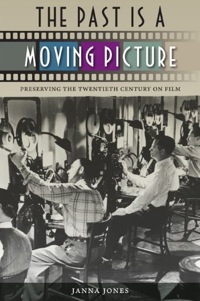
 The Past Is a Moving Picture: Preserving the Twentieth Century on Film by Janna Jones (University Press of Florida)
The Past Is a Moving Picture: Preserving the Twentieth Century on Film by Janna Jones (University Press of Florida)
A professor of communication at Northern Arizona University and the author of The Southern Movie Palace: Rise, Fall, and Resurrection (University Press of Florida, 2003 ) discusses the film archive as a project of history making, beginning with a “first wave” in the 1930s. She suggests that almost all remnants of culture – past and present – degrade over time, whether sculpture or scrolls, painting or papyrus, books or clay tablets, but that perhaps no major cultural record dissolves more rapidly than film, arguably the predominant medium of the twentieth century.
Losses have already been extensive, leaving huge gaps in the historical record, but also problematic is that archives are now being flooded with so much material that they lack the funds to properly preserve it all. What sense of history can we then have, Jones asks. She analyzes the major assumptions and paradigmatic shifts about history, cinema, and the moving image archive, and suggests that the overwhelming rush toward digitization is posing additional dangers. Mark Jancovich of the University of East Anglia calls the book “an absolutely stupendously important volume. Historically and theoretically informed, this book is an absolutely first-rate investigation of the current cultural politics of film archives. It is not only indispensable for all those working to preserve the historical record, but it will also provide a fascinating and enjoyable read for others.”
n
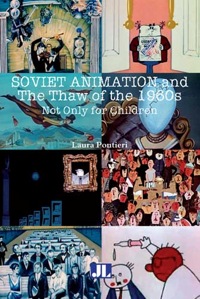 Soviet Animation and the Thaw of the 1960s: Not Only for Children, by Laura Pontieri (John Libbey, distributed by Indiana University Press)
Soviet Animation and the Thaw of the 1960s: Not Only for Children, by Laura Pontieri (John Libbey, distributed by Indiana University Press)
A scholar of Russian and Soviet cinema at the University of Toronto examines links between Soviet animators and the political establishment during the post-Stalin period of liberalization. She describes how animation reflected a new spirit of aesthetic freedom. Drawing on extensive archival research, Laura Pontieri reconstructs the dynamics inside Soviet animation studios and the relationships between the animators and the political establishment.
n
n
n
June 2012
a
a
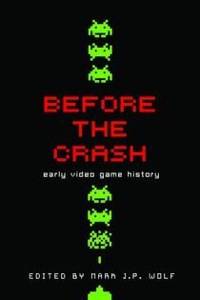
Before the Crash: Early Video Game History, edited by Mark J.P. Wolf (Wayne State University Press)
Wolf, a prominent video-game scholar, has assembled essays on arcade games, home game consoles, home computer games, handheld games, and even early online games with an emphasis on developments before a crash in the industry in 1977. Twelve contributors explain that, following the first appearance of arcade video games in 1971 and home-video game systems in 1972, the commercial video-game market exuberantly innovated, and profited, through new games, gaming systems, and technologies. But around 1983, sales of home game systems dropped, thousands of arcades closed, and major video game makers suffered steep losses or left the market. The essays in this volume examine the fleeting golden age of video games, an era that is sometimes overlooked due to the unavailability of older games or their perceived primitiveness.
Wolf, a communication specialist at Concordia University Wisconsin, has written extensively about video games and related – art, communication, and cognition in the digital age, and is the founder of the Landmark Video Game book series and the Video Game Studies Scholarly Interest Group within the Society of Cinema and Media Studies.
n
 Video Surveillance of Nesting Birds, edited by Christine A. Ribic, Frank R. Thompson III, and Pamela J. Pietz (University of California Press)
Video Surveillance of Nesting Birds, edited by Christine A. Ribic, Frank R. Thompson III, and Pamela J. Pietz (University of California Press)
The papers in this volume discuss the major advances in bird reproductive biology that are being achieved using miniature video cameras and recording equipment. Those tools, say the authors, are capable of generating astonishing results with the potential for fresh insights into bird conservation, management, and theory. Contributors note that declining bird populations, especially those that breed in North American grasslands, have stimulated extensive research on nest failure and reduced reproductive success. They say that miniature video cameras and recording equipment have proven to be powerful tools in bird conservation, management, and theory by providing new insights into breeding biology through new observations of hatching, incubation, fledging, diurnal and nocturnal activity patterns, predator identification, predator-prey interactions, and cause-specific rates of nest loss. That, says University of Minnesota wildlife biologist Douglas H. Johnson, have “shatters earlier beliefs about how birds interact with nest predators. Much of what we thought we knew about nesting and its hazards was flat-out wrong.”
n
May 2012
n
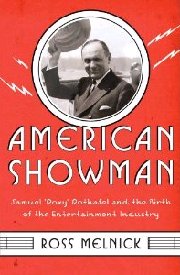
American Showman: Samuel “Roxy” Rothafel and the Birth of the Entertainment Industry, by Ross Melnick (Columbia University Press)
Melnick is an assistant professor of cinema studies at Oakland University who has worked as a curator at the Museum of the Moving Image and in marketing for Loews Cineplex, Miramax, Metro-Goldwyn-Mayer, and DreamWorks, and in film distribution for Sony Pictures. With Andreas Fuchs, he wrote Cinema Treasures and upkeeps the extraordinary Cinema Treasures website on the current condition of movie houses around the world.
Melnick’s new book is the first full biography of Rothafel (1882-1936), a film exhibitor, stage producer, radio broadcaster, musical arranger, theater manager, war propagandist, and international celebrity – an influential figure of the silent era who helped to bring together film, music, and live performance. As a composer and impresario, Rothafel borrowed from theater, opera, ballet, and classical music to attract multi-class audiences. He scored early Fox Movietone films such as Sunrise (1927); pioneered the convergence of film, broadcasting, and music publishing and recording in the 1920s; and helped movies and moviegoing become the dominant form of mass entertainment between the world wars.
In the Washington Post, Mindy Aloff, a Barnard College dance historian, writes: “In this 52nd volume of Columbia University Press’s outstanding Film and Culture series, Melnick has placed his subject in a huge context, chronicling not only Roxy but also the movie and music businesses, the rise of radio, issues of anti-Semitism, the development of New York and much more during the first third of the 20th century. His writing clarifies, his judgments are eminently reasonable and his research is spectacular.”
An interview with Melnick is online.
Ross Melnick describes his research
When I began working on this project in 2002, I was surprised to find that only Ben Hall’s 1961 book, The Best Remaining Seats, had any substantial information on Roxy’s career and influence on film exhibition. I’m not quite sure how he escaped a more in-depth study between the publication of that book, which examines the history of film exhibition from the 1910s to the 1930s, and the publication of American Showman. One reason may be the significant research challenge this book posed: although some Rothafel material was donated to the New York Public Library for the Performing Arts, very little correspondence and audio material remains. I was fortunate, however, to find tremendous scrapbook collections at the NYPL and at the Museum of the City of New York.
Piecing Roxy’s career together took many years, in part because of the absence of archival material and because of the varied and multimedia nature of his work. Roxy was, of course, not only a film exhibitor, but also a prolific broadcaster between 1922 and 1935. Thus, an examination of his radio career (and relevant collections) was imperative. I also needed to examine his career as a Marine, his technological innovations, his propaganda work for the U.S. government, as well as his work producing motion pictures, arranging music for Fox Movietone films (such as Sunrise and 7th Heaven), and all of his many successes and failures. Today, there are few recordings of his enormously influential 13 years on the air as emcee of “Roxy and His Gang” for NBC and later CBS. There are, to my knowledge today, only two existing audio recordings – one at the Library of Congress (“Roxy Comes a Calling”) and the other at the Thomas Edison National Historic Park of a 1928 radio show at Madison Square Garden hosted by Rothafel.
As for paper archives, I should mention that Radio City Music Hall denied access to their private archives not once but three times. Those would have been a great aid to my research. Fortunately, the NYPL has a good collection of Radio City and RKO Roxy press releases from the period and a collection of theater programs from his time there. Here, again, analysis of film, radio, trade, and fan magazines became imperative. I was also able to find correspondence – such as a letter Roxy wrote after quitting Radio City – and internal Radio City magazines from archives and other sources such as eBay. The online auction site became a great source of fan letters, photographs, film, music, and radio, trade and fan magazines, programs, and other ephemera.
Research for American Showman was a persistent challenge but this was easily the most rewarding project I have ever had the pleasure to work on.
n
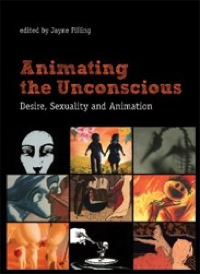 Animating the Unconscious: Desire, Sexuality, and Animation, edited by Jayne Pilling (Wallflower Press, distributed by Columbia University Press)
Animating the Unconscious: Desire, Sexuality, and Animation, edited by Jayne Pilling (Wallflower Press, distributed by Columbia University Press)
Essayists analyze the process and practice of key contemporary animation filmmakers like Michele Cournoyer, Ruth Lingford, Andreas Hykade, Simon Pummell, and Annabelle Pangborn, and the ways their work explores and depicts subjective experience – particularly desire, sexuality, social constructions of gender, confessional modes, and fantasy. The authors include interview material, visual mapping of the creative process, and reflections on the neglected issue of how the use of sound differs from that of conventional live-action. They also take notice of filmmakers’ critiques of each others’ work.
The volume’s editor, Jayne Pilling, curates animations festivals and symposia internationally, and publishes on animation. She has taught at the Royal College of Art, UK, the University of Pennsylvania, and several universities in Taiwan. She has also directed a series on European animation for Channel Four TV and is the founder of the British Animation Awards.
n
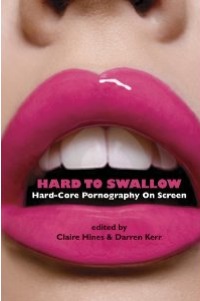 Hard to Swallow: Hard-Core Pornography on Screen edited by Claire Hines and Darren Kerr (Wallflower Press, distributed by Columbia University Press)
Hard to Swallow: Hard-Core Pornography on Screen edited by Claire Hines and Darren Kerr (Wallflower Press, distributed by Columbia University Press)
A volume of essays about screen representations of pornography and sex in a variety of cultural, historical, and critical contexts. Contributors cover a wide range of topics from sex in the multiplex to online alt-porn, from women in stag films to the excesses of extreme pornography. They discuss porn performance, fashion in hard-core, gay and lesbian pornography, the pornography industry, and the “highbrow hardcore” of Shortbus, a film about an underground salon infamous for its blend of art, music, politics, and carnality.
n
n
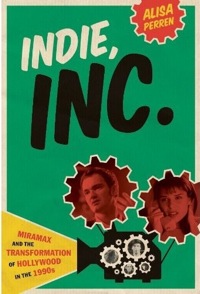 Indie, Inc.: Miramax and the Transformation of Hollywood in the 1990s by Alisa Perren (University of Texas Press)
Indie, Inc.: Miramax and the Transformation of Hollywood in the 1990s by Alisa Perren (University of Texas Press)
An associate professor of communication at Georgia State University presents case studies of Miramax films such as sex, lies, and videotape, Kids, Life Is Beautiful, Pulp Fiction, The Crying Game, The Piano, The English Patient, and Good Will Hunting to show how the company achieved financial and critical success and broadly affected the film industry and “global Hollywood” during the 1990s. She shows how the company evolved from independent producer-distributor to studio subsidiary, and chronicles the way it transformed not just the independent film world but the film and media industries more broadly: on film festival practices, marketing strategies, talent development, and awards campaigning. Perrin seeks to transcend discussions of “American indies” to look at the range of Miramax-released genre films, foreign-language films, and English-language imports released over the course of the decade. She suggests that what the press and scholars have represented as the “rise of the American independent” was in fact part of a larger reconfiguration of the media industries toward niche-oriented products. (In the series Texas Film and Media Studies Series.)
n
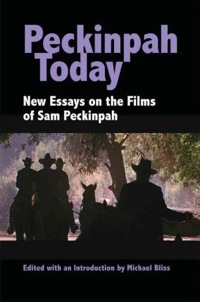 Peckinpah Today: New Essays on the Films of Sam Peckinpah edited by Michael Bliss (Southern Illinois University Press)
Peckinpah Today: New Essays on the Films of Sam Peckinpah edited by Michael Bliss (Southern Illinois University Press)
Nine essayists explore the process and themes of the American filmmaker, highlighting new sources, from modified screenplay documents to interviews with screenplay writers and editors. Included: a rare Peckinpah interview with A. S. Fleischman, author of the screenplay for The Deadly Companions, which launched Peckinpah’s career; an essay by Paul Seydor, the editor of the controversial special edition of Pat Garrett and Billy the Kid; an account by critic Michael Sragow on how Peckinpah and co-scriptwriter David Zelag Goodman transformed a pulp novel into the powerful Straw Dogs; and a detailing of how Peckinpah’s career took a dark turn.
A scholar of writing, literature, and cinema at Virginia Tech, Michael Bliss is the author or editor of eight books of film criticism, including Justified Lives: Morality and Narrative in the Films of Sam Peckinpah, Doing It Right: The Best Criticism on Sam Peckinpah’s The Wild Bunch, and Dreams within a Dream: The Films of Peter Weir.
n
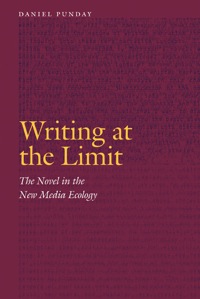 Writing at the Limit: The Novel in the New Media Ecology by Daniel Punday (University of Nebraska Press)
Writing at the Limit: The Novel in the New Media Ecology by Daniel Punday (University of Nebraska Press)
In his study of writers’ engagement with film, television, video games, and cybermedia, a professor of English and anthropology at Purdue University–Calumet (author of Five Strands of Fictionality: The Institutional Construction of Contemporary American Fiction and Narrative Bodies: Toward a Corporeal Narratology) contends that cultural critics have prematurely pronounced the death of the novel, and that it is worth examining how novelists locate print writing within the contemporary media ecology. He argues that a generation of novelists has turned to other media with curiosity rather than fear, not merely by incorporating references to other media into their work, but also by engaging with the ways that new media create narrative outside the print medium. Specifically, he examines how fiction writers – well known ones like Thomas Pynchon and Robert Coover, accessible ones like Maxine Hong Kingston and Oscar Hijuelos, and overlooked ones like Susan Daitch and Kenneth Gangemi – have deployed film, television, video games, and hypertext in relation to such fiction elements as character, plot, and setting. (In the Frontiers of Narrative Series.)
n
April 2012
n
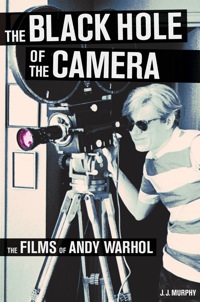
The Black Hole of the Camera: The Films of Andy Warhol by J.J. Murphy (University of California Press)
A professor of film and art at the University of Wisconsin-Madison who is also a filmmaker and curator, Murphy is also the author of Me and You and Memento and Fargo: How Independent Screenplays Work. His new book is the first comprehensive survey and analysis of Warhol’s films. Murphy discusses the visual artist’s early films, sound portraits, involvement with multimedia (including The Velvet Underground), and sexploitation films, as well as the more commercial works he produced for Paul Morrissey in the late 1960s and early 1970s. Murphy argues that Warhol, as a maker of hundreds of films, including Sleep, Empire, Blow Job, The Chelsea Girls, and Blue Movie, made seminal but little understood contributions to the evolution of American cinema. Murphy studies Warhol’s collaborations with writers, performers, other artists, and filmmakers. He also shows that Warhol’s use of the camera transformed the events being filmed and used a brand of psychodrama that created dramatic tension within the works.
n
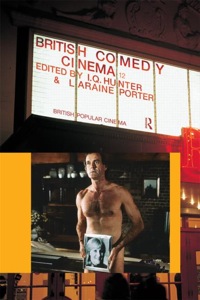 British Comedy Cinema edited by I.Q. Hunter and Laraine Porter (Routledge)
British Comedy Cinema edited by I.Q. Hunter and Laraine Porter (Routledge)
In a volume about the genre that is arguably the most popular and important in British film history, Ian Hunter and Laraine Porter of De Montfort University in Leicester (Hunter co-edits two book series, British Popular Cinema (Routledge) and Screen Adaptations), bring together essays on class and comedy from silent slapstick and satire to contemporary romantic comedy. Topics include the Ealing comedies, the Carry On films, the Monty Python films, and Local Hero.
n
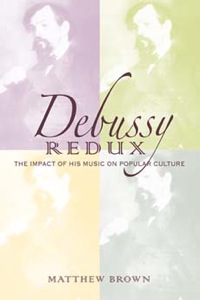
Debussy Redux: The Impact of His Music on Popular Culture by Matthew Brown (Indiana University Press)
A professor of music theory at the Eastman School of Music at the University of Rochester explores the influence that the French composer (1862-1918) had, after his death, on film and popular culture. Brown, the author of Debussy’s ‘Ibéria’: Studies in Genesis and Structure (Oxford, 2003), Explaining Tonality: Schenkerian Theory and Beyond (Rochester, 2005), and Debussy Redux. The Impact of His Music on Popular Culture (Indiana, 2012), and articles in Integral, Music Theory Spectrum, Understanding Rock, and Journal of Musicology, says that while Debussy’s profound influence on such late-19th– and 20th-century masters as Ravel, Stravinsky, Henri Dutilleux, and Toru Takemitsu is well-known, he should also be remembered for his influence on the popular culture of the period. From film scores of the 1940s to the dance music of the 1990s, Debussy’s impressionist soundscapes for orchestra shaped accompaniment to many films. Brown traces Debussy’s stylistic evolution to show how facets of his style were reinterpreted for cinematic and other contexts – ’30s swing tunes, ’40s movie scores, ’50s lounge/exotica, ’70s rock and animation, ’80s action films, and Muzak.
n
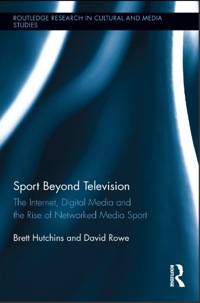 Sport Beyond Television: The Internet, Digital Media, and the Rise of Networked Media Sport by Brett Hutchins and David Rowe (Routledge)
Sport Beyond Television: The Internet, Digital Media, and the Rise of Networked Media Sport by Brett Hutchins and David Rowe (Routledge)
Discusses the proliferation of media platforms for sports broadcasting. They view sports media as a pivotal component in online content economies and cultures, and seek to redress the scant scholarly attention paid to sports media in comparison with studies of music, film, and publishing in media cultures, with particular attention to sports media and culture in Australia. Chapters examine the shift from broadcast to online sports media markets, the impact of social networking platforms like Twitter and Facebook, evolving user and fan practices, the changing character of sports journalism, and the rise of sports computer gaming. Each chapter traces the socio-cultural implications of trends and trajectories in media sport. Hutchins is co-director of the Research Unit in Media Studies at Monash University. His has published on sport and culture in several journals, and is the author of Don Bradman: Challenging the Myth (Cambridge University Press). Rowe is a professor of cultural research in the Institute for Culture and Society at the University of Western Sydney. His books include Globalization and Sport: Playing the World (co-authored, Sage), Sport, Culture and the Media: The Unruly Trinity (Open University Press) and Global Media Sport: Flows, Forms and Futures (Bloomsbury Academic).
n
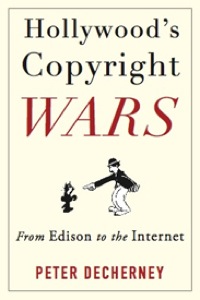 Hollywood’s Copyright Wars: From Edison to the Internet, by Peter Decherney (Columbia University Press)
Hollywood’s Copyright Wars: From Edison to the Internet, by Peter Decherney (Columbia University Press)
n
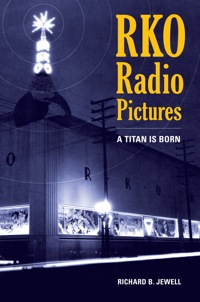 RKO Radio Pictures: A Titan Is Born, by Richard B. Jewell (University of California Press)
RKO Radio Pictures: A Titan Is Born, by Richard B. Jewell (University of California Press)
A professor of critical studies and Hugh M. Hefner Chair for the Study of American Film at the University of Southern California’s School of Cinematic Arts (and author of The Golden Age of Hollywood, The RKO Story, and other books), traces the turbulent business history of the famed RKO studio from its founding through 1942. One of the “Big Five” studios of Hollywood’s golden age, RKO is remembered primarily for the famous films it produced, from King Kong and Citizen Kane to the Astaire-Rogers musicals. But it also provides a fascinating case study of film-industry management during a vexing period of American social history. Jewell relates 30 years of unstable finances, management battles, and artistic gambles, and uses now-dispersed studio documents to explore RKO’s decision making and the dramatic interplay of art and commerce during the studio-system heyday. Jewell describes business stresses, logistical challenges, and in-house rivalries, as well as the roles of big names like David Sarnoff, Pandro Berman, Fred Astaire, Katharine Hepburn, and Orson Welles.
n
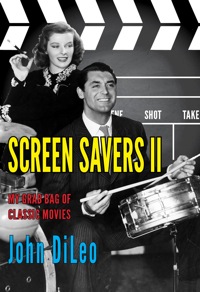 Screen Savers II: My Grab Bag of Classic Movies, by John DiLeo (Hansen Publishing Group)
Screen Savers II: My Grab Bag of Classic Movies, by John DiLeo (Hansen Publishing Group)
John DiLeo follows up the first installment of his personal take on classic movies with extensive essays on 10 remarkable and underappreciated movies of various genres and such stars as Barbara Stanwyck, James Stewart, Ginger Rogers, and DiLeo favorite Joel McCrea. He also collects and categorizes posts from his classic-film blog screensaversmovies.com, and presents a section of classic-movie quizzes.
DiLeo has now published a slew of outstanding books on classic movies. Pauline Kael called his And You Thought You Knew Classic Movies (1999) “the smartest movie quiz book I’ve ever seen.” DiLeo followed up in 2002 with 100 Great Film Performances You Should Remember But Probably Don’t (Limelight Editions, 2002), which The Washington Post said could “serve as balm for anyone who has ever been disgruntled by the Academy’s choices on Oscar night” – and who isn’t in that vast club?
His 2007 book, Screen Savers: 40 Remarkable Movies Awaiting Rediscovery, appeared in 2007, also from Hansen, while in 2010 he published Tennessee Williams and Company: His Essential Screen Actors.
In addition to writing about classic film, DiLeo hosts classic-film series, appears often on radio shows, and conducts film-history seminars.
n
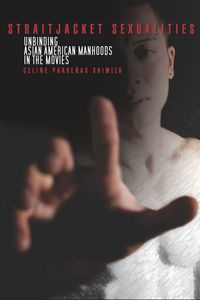 Straitjacket Sexualities: Unbinding Asian American Manhoods in the Movies, by Celine Parreñas Shimizu (Stanford University Press)
Straitjacket Sexualities: Unbinding Asian American Manhoods in the Movies, by Celine Parreñas Shimizu (Stanford University Press)
A filmmaker and associate professor of Asian American studies at the University of California at Santa Barbara considers Asian-American masculinity and sexuality in Hollywood and independent movies. Her earlier book, The Hypersexuality of Race: Performing Asian/American Women on Screen and Scene, from 2007, won the 2009 Cultural Studies Book Prize from the Association for Asian American Studies. In her new book, she notes that depictions of Asian American men as effeminate or asexual pervade popular movies, as if Hollywood has decided that Asian American men cannot qualify for heroic heterosexuality. This, she argues, aggravates Asian American male sexual problems both on and off screen. She considers such alternatives as Bruce Lee and Long Duk Dong and the ways they portray intimacy on screen – not dominating, but caring – while also emphasizing diverse ways Asian American men experience complex, ambiguous, and ambivalent genders and sexualities. The result is “an utterly original examination” and “a critical tour-de-force” of cinema ethics,” says the University of Pennsylvania’s David L. Eng.
Recently, Shimizu’s first feature film, Birthright: Mothering Across Difference (2009), won the Best Feature Documentary at the Big Mini DV Festival. Her previous films include Mahal Means Love and Expensive (1993), Her Uprooting Plants Her (1995), Super Flip (1997) and The Fact of Asian Women (2002/4). She is currently developing her first feature narrative film based on a true story about a Filipino American community in Martinez, California, in 1931.
n
 Treacherous Subjects: Gender, Culture, and Trans-Vietnamese Feminism, by Lan P. Duong (Temple University Press)
Treacherous Subjects: Gender, Culture, and Trans-Vietnamese Feminism, by Lan P. Duong (Temple University Press)
An associate professor of media and cultural studies at the University of California at Riverside takes feminist perspectives on post-Vietnam war era filmmakers Tony Bui and Tran Anh Hung, filmmaker, writer, and composer Trinh T. Minh-ha, and various other filmmakers and writers working in Vietnam, France, and the United States. Duong shows how history has shaped the loyalties and shifting alliances of Vietnamese artists caught between opposing forces of nationalism, patriarchy, and communism.
Duong is working on a second book, Transnational Vietnamese Cinemas: Imagining Nationhood in a Globalized Era, which will examine Vietnamese cinema from its inception to the present.
Lan Duong describes the challenges and pleasures of her research
During my last days of doing research for my book, Treacherous Subjects: Gender, Culture and Trans-Vietnamese Feminism, at the Film Institute in Hà Nội, I watched a Vietnamese film called Trận Mộc Hoa (1945) on a small editing bay. Filmed during the anti-colonial resistance movement by one of Việt Nam’s most esteemed directors, Mai Lọc, the film is one of the few surviving films of this time period. Many film reels in Việt Nam were, in fact, destroyed or damaged during Việt Nam’s long history of war with the French, Japanese, and Americans. Since 2002 I have watched many films at the Film Institute and have paid hefty fees (for foreign scholars who come to the Institute without a Vietnamese institutional affiliation, the cost of watching a film reel in a screening room was $20 per hour). While I have screened films of all kinds – documentary, animation, and feature films – this particular film stuck in my mind, especially because the existent copy I was able to screen was an internegative of the film. Watching the film through the small, editing screen, I could only make out vague images and figures in blurry black and white. While similar to other propagandistic films about the anti-French colonial resistance, Lọc’s film was particularly moving because of its rich symbolism. In its present condition, the film was without sound and the images of revolution seemed archaic but also ghostly. Watching Trận Mộc Hoa in this way was a doubled sign of the poor material conditions under which the film was both made in the past and now screened presently.
I take this moment as further symbolic of how the Vietnamese film archive is itself an experience of presence and absence, positive and negative. What is present in the state-run archives is a sanctioned, black-and-white film history that emphasizes revolution, sacrifice, and victory; absent are those films that run counter to this official version of Vietnamese history. This includes southern Vietnamese films produced during the American War, diasporic Vietnamese films about the refugee or reeducation experience, and many colonial films produced before the founding of the Democratic Republic of Việt Nam in 1945. Compounding these omissions is the fact that film preservation is still a developing art in the country. Finally, the Film Institute is also very particular about allowing foreign scholars like myself access to the archive’s holdings. When I asked about their holdings, for example, I was told several times that some of the films are too politically sensitive and are not accessible or even found in Việt Nam. As a researcher in the country’s foremost and accessible film archive, I found that this site poses more questions than it answers.
While working on the book, I also went to Paris, Aix-en-Provence, and Avignon to visit their archives as they related to film, colonial documents, and photographs. I found it immensely enriching to review the archived documents surrounding a burgeoning film culture in colonial Việt Nam. However, these archival spaces only served to dramatically contrast with the kinds of spaces I visited in Việt Nam. My archival experiences in Việt Nam are an index of how film scholarship in the country is underdeveloped and uneven, mired in bureaucratic and financial problems. Within a Vietnamese context in which world cinema, film books, and even some classic Vietnamese films are hard to find, an academic film culture has yet to find firm ground in this postwar country. The myriad conversations I had with students of film and writers and directors in the country only confirm this.
Nonetheless, the research I conducted for this book encompasses these experiences as well as many others. While film institutes in Việt Nam were difficult to access, my access to people (directors, actors, writers, and producers) was boundless. I was able to interview and talk with some of the most famous cultural producers in Việt Nam. They included Đặng Nhật Minh, Dương Thu Hương, Nguyễn Huy Thiệp, Lê Hoàng, and Vũ Ngọc Đãng. I was privileged to be privy to their lives, work, and personal stories. Indeed, such moments were the highlights of my academic career and animate the strands of narrative and history that are found in my book, Treacherous Subjects: Gender, Culture and Trans-Vietnamese Feminism.
March 2012
n
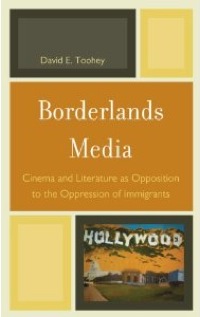
Borderlands Media: Cinema and Literature as Opposition to the Oppression of Immigrants by David E. Toohey (Lexington Books)
A visiting assistant professor at Aichi University in Nagoya, Japan, explores the immigrant experience, and particularly anti-immigrant hostility, using a mixture of cinema, literary, and other artistic media spanning from 1958 onward. He begins with Orson Welles’s 1958 Touch of Evil, which triggered a wave of protest resulting in Chicano filmmakers opposing racism against immigrant and diaspora communities. Toohey then analyzes policy documents and social science scholarship to cast light on the history of linguistic and visual power related to his subject. He explores how cinematic political thought can challenge such prejudice and abuse, Drawing prominently on the theories of Gilles Deleuze. Toohey uses film and other media to show how immigrants to the US are often constrained to violent, dehumanizing lives.
n
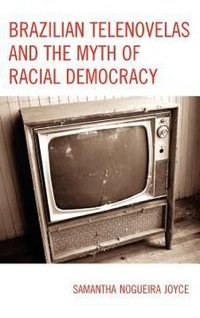 Brazilian Telenovelas and the Myth of Racial Democracy by Samantha Nogueira Joyce (Lexington Books)
Brazilian Telenovelas and the Myth of Racial Democracy by Samantha Nogueira Joyce (Lexington Books)
An assistant professor of mass communication at Indiana University explores the role of telenovelas in social change through a study of Duas Caras (2007-08), the first of the genre with an Afro-Brazilian as its main character, and the first Brazilian television show with its own blog. There, viewers reacted to storylines and media reports of the characters and plot, and engaged with fans and critics of the program. Through comparison with other media, Joyce studies the social milieu of the telenovela, arguing that the genre has contributed to social change in an unexplored way.
Joyce describes her background in media studies in an online biographical essay. Her Brazilian Womanhood in the Prime Time Telenovela: A Textual Analysis of Aguinaldo Silve’s “Senhora do Destino” (VDM Verlag, 2009), analyzed a 2005 telenovela that for daily for five months drew 45 million Brazilian viewers. She showed how Brazilian writers and producers use the telenovela form to construct a Brazilian female identity that seeks to inspire women to an expansive self-conception.
Samantha Nogueira Joyce describes her research
It is a bit challenging finding older clips of Brazilian telenovelas, especially those that aired on the now-extinct TV Tupi. On the other hand, it is amazing what you can find on YouTube.
Also, TV Globo lets their online subscribers access a certain amount of videos but they also act as gatekeepers. I had an easy time accessing the videos because I was recording them myself, as each chapter aired. However, had I not done that, I believe it would be practically impossible to obtain them legally (although YouTube could be a resource). I have tried to contact them several times to try to get an interview with their authors/actors and they are really polite, but also really good at stalling…
n
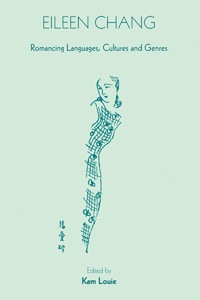 Eileen Chang: Romancing Languages, Cultures, and Genres edited by Kam Louie (Hong Kong University Press)
Eileen Chang: Romancing Languages, Cultures, and Genres edited by Kam Louie (Hong Kong University Press)
A series of essays collected by the dean of arts at the University of Hong Kong and author of Theorising Chinese Masculinity about the novels, short stories, plays, and cinematic adaptations of the Shanghai-born writer (1920-95), whose works include Lust, Caution. Louie’s book is the first about Chang in a language other than Chinese. The essays take literary, gender-studies, historical, and film-studies approaches to Chang’s work, about a China that is beyond political rhetoric, where ordinary human feelings take precedence over concerns about the ‘rise of China’ and its place in the global village. Chang was one of the most popular writers in 1940s Shanghai, but her subject matter, and choosing to ignore revolutionary and political movements, meant that in mainland China she was neglected until recently. Due to her popularity with Chinese readers outside the mainland, hundreds of works about her have appeared in the Chinese language. The essays discuss the translation of her stories for film and stage presentation, paying attention to the fidelity and betrayals that dominate her alter ego’s relationships with parents and lovers that are frequently dramatized in plays and filmic translations of her work.
n

Playing to the Camera: Musicians and Musical Performance in Documentary Cinema, by Thomas F. Cohen (Wallflower Press, distributed by Columbia University Press)
An assistant professor of communication at the University of Tampa analyzes film documents of many varieties of music, from rock to experimental video art featuring modernist compositions. He explores links between moving images and musical movement to ask such questions as why performance is offered considered mere skill while composition is afforded the status of art.
n
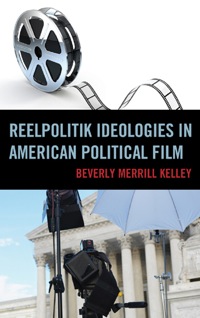 Reelpolitik Ideologies in American Political Film by Beverly Merrill Kelley (Lexington Books)
Reelpolitik Ideologies in American Political Film by Beverly Merrill Kelley (Lexington Books)
A professor of communication at California Lutheran University discusses 185 political movies organized by ideology. Drawing from the cinema of more than a century, she places films in such categories as populism (e.g. The Candidate) and elitism (e.g. Wall Street) to illustrate the history of film as well as of specific ideologies. Each chapter includes a case study of the film that best illustrates each ideology. Other groupings include fascism (e.g. The Godfather), anti-fascism (e.g. All the President’s Men), interventionism (Patton), and isolationism (M*A*S*H). Kelley identifies the cyclical nature of ideological dialectic throughout American history and identifies the values, attitudes, and beliefs of the party-unaffiliated voters who often determine the outcomes of elections.
n
n
n
February 2012
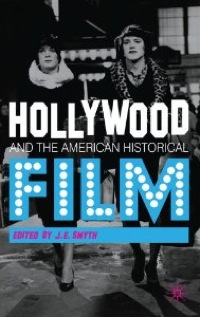
n
Hollywood and the American Historical Film edited by J.E. Smyth (Macmillan)
Leading scholars from film-related fields discuss the theoretical and historical contexts of films made about the American past, from silent film to the present. The book offers a fresh assessment of studio era historical filmmaking and its legacy across a range of genres in relation to such topics as Giambattista Vico’s “age of heroes” and John Ford’s The Man Who Shot Liberty Valance.
n
January 2012
n
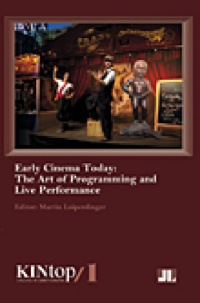 Early Cinema Today: The Art of Programming and Live Performance, edited by Martin Loiperdinger (John Libbey Publishing)
Early Cinema Today: The Art of Programming and Live Performance, edited by Martin Loiperdinger (John Libbey Publishing)
The essays in this collection recognize that at the beginning of film, the art of programming and performing cinematograph shows on fairgrounds, in town-halls, and in permanent cinemas required special skills of showmanship. The authors show how those skills were lost during the last 100 years, but during the last 20 years have been revived, to some degree, by film archives and film festivals that have created new ways of presenting early films. The volume presents some of these innovative projects: Mariann Lewinsky’s A Hundred Years Ago programmes for scholars and archivists at the Bologne Festival, Eric de Kuyper’s integrating films from the 1910s into elaborated performance events, both curators’ jointly programmed From the Deep series at the International Short Film Festival Oberhausen, Madeleine Bernstorff’s and Mariann Lewinsky’s weekend in Berlin with films related to the suffragettes’ movement, Vanessa Toulmin’s numerous shows of early local films for today’s local people, and last but not least the Crazy Cinématographe, and the Luxemburg fairground cinematograph show curated by Nicole Dahlen and Claude Bertemes, which includes front-shows and film narrators, the essentials of fairground performance. Early Cinema Today is the first book in a new series, KINtop: Studies in Early Cinema.
December 2011
n
November 2011
n
October 2011
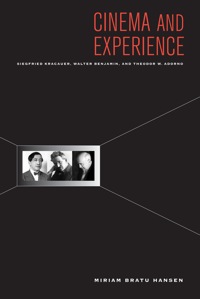 Cinema and Experience: Siegfried Kracauer, Walter Benjamin, and Theodor W. Adorno, by Miriam Bratu Hansen, edited by Edward Dimendberg (University of California Press)
Cinema and Experience: Siegfried Kracauer, Walter Benjamin, and Theodor W. Adorno, by Miriam Bratu Hansen, edited by Edward Dimendberg (University of California Press)
Miriam Bratu Hansen, the late professor of humanities at the University of Chicago and founding chair of its department of cinema and media studies, author of Babel and Babylon: Spectatorship in American Silent Film and other works, studies the key role that technological media played in the critique of modernity developed by Siegfried Kracauer, Walter Benjamin, and Theodor W. Adorno. In analyzing the way that the friends and colleagues considered the role of cinema and photography from the Weimar period up to the 1960s, she inspects an archive of known and, in the case of Kracauer, less known materials to arrive at their theory of cinema and experience. She also suggests its relevance as moving-image culture evolves in response to digital technology. (In the series Weimar and Now: German Cultural Criticism.)
n
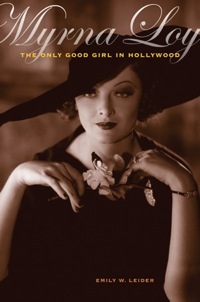 Myrna Loy: The Only Good Girl in Hollywood, by Emily W. Leider (University of California Press)
Myrna Loy: The Only Good Girl in Hollywood, by Emily W. Leider (University of California Press)
Biographer, poet, and memoirist Emily W. Leider (Dark Lover: The Life and Death of Rudolph Valentino, Becoming Mae West, and Rapid Eye Movement and Other Poems, among other books) writes the first biography of the mysterious silents-then-talkies star, who has been oddly under-studied. The results, says Anthony Slide, are “so conscientiously researched, so closely written in detail and intelligent style that there will be no need for a second.” Leider writes about the wry and sophisticated actress’s rough-and-tumble early years in Montana, her multiple and sometimes foolish marriages, and her development from exotic silent player to sophisticated lead in the Thin Man series as Nora Charles, wife to dapper detective William Powell. Leider also describes Loy’s subsequent transition into a seeming proud, understanding middle-class wife in the 1940s during a career of some 60 years. In Los Angeles in the 1920s, Loy’s striking looks caught the eye of Valentino; through her early-sound-era films of the thirties, she became a box office draw; after World War II, her career developed richly, and she befriended the likes of Cary Grant, Clark Gable, and Joan Crawford and collaborated with John Barrymore, David O. Selznick, Sam Goldwyn, William Wyler, and many others.
Emily Leider describes exploring Myrna Loy’s life
Myrna Loy left an archive at Boston University’s Gotlieb Archival Research Center; it includes letters (though not too many reveal intimate details of her private life), photographs, clippings, scrapbooks, and some programs and scripts. Many of the photographs in my book come from the Margaret Herrick Library of the Academy of Motion Picture Arts and Sciences, where I also found material on Loy or her films in the Samuel Goldwyn Collection, the files of the Production Code Administration, and (in both the Core Collection and Special Collections) on individual movies, directors, producers, organizations, and acting colleagues. The Warner Bros. Archive at USC has files on individual movies, scripts, and legal documents. I consulted the MGM and Darryl F. Zanuck Collections at the USC Cinema Library and the Dore Schary Collection at the Wisconsin Center for Film and Theater Research. UCLA Performing Arts Library (Special Collections) has material on films from RKO Fox and 20th Century Fox. Among the resources for watching Myrna Loy films were the Motion Picture Division of the Library of Congress, the Museum of Modern Art Film Study Center in New York City, and the UCLA Film and Television Archive.
There are many lost Myrna Loy silent films, most of them made at Warner Bros. Her first film, What Price Beauty?, predates her Warners contract, and was made with Natacha Rambova, the estranged wife of Rudolph Valentino; it was filmed in 1925 but not released until 1928, and exists only as a few stills. One early talkie that was believed lost for many years, The Animal Kingdom (RKO, 1932, with Leslie Howard and Ann Harding as well as Myrna Loy), was located by Ronald Haver in 1985, restored at UCLA, and screened by the Academy of Motion Picture Arts and Sciences at a New York tribute to Myrna Loy that same year.
n
Transnational Asian Identities in Pan-Pacific Cinemas: The Reel Asian Exchange, edited by Philippa Gates and Lisa Funnell (Routledge)
Essays that examine the exchange of Asian identities taking place at the levels of both film production and film reception amongst pan-Pacific cinemas. The authors consider films that exhibit “marked transnationality” and also the multiple meanings attributed to transnational films. Topics include the innovation of Hollywood generic formulas in 1950s and 1960s Hong Kong and Japanese films; the examination of Thai and Japanese raced and gendered identity in Asian and American films; the reception of Hollywood films in pre-1949 China and millennial Japan; the production and performance of Asian adoptee identity and subjectivity; the political implications and interpretations of migrating Chinese female stars; and the production and reception of pan-Pacific co-productions.
In the series Routledge Advances in Film Studies.
n
September 2011
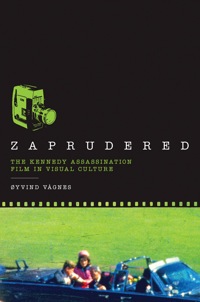 Zaprudered: The Kennedy Assassination Film in Visual Culture by Øyvind Vagnes (University of Texas Press)
Zaprudered: The Kennedy Assassination Film in Visual Culture by Øyvind Vagnes (University of Texas Press)
A postdoctoral fellow at the research center Nomadikon: New Ecologies of the Image in the Department of Information Science and Media Studies at the University of Bergen examines how the footage of Kennedy’s assassination that was made by Abraham Zapruder – one of the 20th century’s most important accidental documentarians – has figured in such realms as installation and performance art, video games, Don DeLillo’s Underworld, and an episode of Seinfeld.Vagnes traces the film’s influences on such cultural expressions as the performance group Ant Farm’s video The Eternal Frame, Don DeLillo’s novel Underworld, and an episode from Seinfeld. He investigates Dealey Plaza’s Sixth Floor Museum, Zoran Naskovski’s installation Death in Dallas, assassin video games, and other destinations of the footage in popular culture and the historical imagination.
n
August 2011
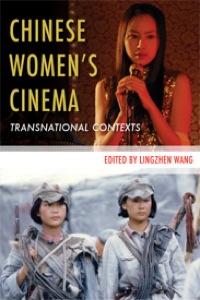
n
Chinese Women’s Cinema: Transnational Contexts, edited by Lingzhen Wang (Columbia University Press)
An associate professor of modern Chinese literature, gender studies, and Chinese film and media at Brown University (Personal Matters: Women’s Autobiographical Practice in Twentieth Century China; editor and co-translator of Years of Sadness: Translation Anthology of Wang Anyi’s Autobiographical Works) presents essays on the work of Esther Eng, Tang Shu Shuen, Dong Kena, Sylvia Chang, and other filmmakers from mainland China, Hong Kong, Taiwan, and the Chinese diaspora who have transformed Chinese cinematic modernity. Sixteen authors discuss the filmmakers’ negotiations of local and global politics, cinematic representation, and issues of gender and sexuality from the 1920s to the present. In her introduction, Lingzhen Wang recounts the history and limitations of established feminist film theory, particularly its relationship with female cinematic authorship and agency as those relate to Chinese women’s films.
In the series Film and Culture Studies. http://cup.columbia.edu/series/62
n
The Continental Connection: German-Speaking Emigres and British Cinema, 1927-45 by Tobias Hochscherf (Manchester University Press, distributed by Palgrave Macmillan)
A professor of audiovisual media at the University of Applied Sciences Kiel in Germany argues that German- and Austrian-born filmmakers from the late 1920s to the end of World War II had a far greater influence on British cinema than is generally recognized. Hochscherf analyzes several films by the likes of Ewald André Dupont, Alfred Junge, Oscor Werndorff, Mutz Greenbaum, and Werner Brandes to show that their aesthetics, themes, narratives, technical innovation, organization, and use of apprenticeship schemes all deeply influenced the British film industry when they came to the UK to escape Nazism.
Tobias Hochscherf describes his archival work:
The main problem I had to deal with was the fact that most archival sources were scattered in various archives. In addition, some documents were in English others in German (so language skills were an issue).
The most interesting primary sources can be found at the National Archives at Kew. Given that the majority of Home Office files on individual emigrés are still closed, I had to request their opening under the Freedom of Information Act. I would strongly encourage other scholars to do this, so that we gain a more nuanced and substantial understanding of how the conditions of exile and the diaspora had an impact on British and indeed Western culture.
A major setback, thinking of moving image archives, was the unavailability of subtitled films made by emigrés prior to their exodus from German-speaking countries as a result of the Nazi regime. In order to study the continuities and discontinuities of their work such a resource would have been invaluable.
n
Hollywood Madonna: Loretta Young by Bernard F. Dick (University Press of Mississippi)
A professor of communication and English at Fairleigh Dickinson University wrote this full-length biography of the American actress (1913-2000) who won an Academy Award and starred in films like The Farmer’s Daughter, The Bishop’s Wife, and Come to the Stable, as well as a long-running, popular television show. Young began acting at the age of 4, became a star at 15, and made her last television movie at 76. Along the way, despite her devout Catholicism, she had an affair with Clark Gable and a child by him that she secretly adopted out, writes Dick (Hal Wallis: Producer to the Stars; Engulfed: The Death of Paramount Pictures and the Birth of Corporate Hollywood; Forever Mame: The Life of Rosalind Russell; Claudette Colbert: She Walked in Beauty).
n
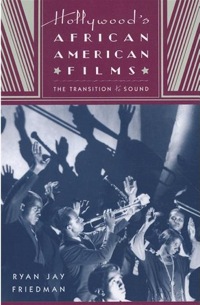 Hollywood’s African American Films: The Transition to Sound by Ryan Jay Friedman (Rutgers University Press)
Hollywood’s African American Films: The Transition to Sound by Ryan Jay Friedman (Rutgers University Press)
An assistant professor of English and film studies at The Ohio State University traces the origins of a “vogue” for “Negro films” – black musical features and shorts – in the early era of talkies. Friedman suggests that they set the stage for later Hollywood treatments of Black images and sounds, and that the movie business turned to black musical performance to both resolve technological and aesthetic problems introduced by the medium of “talking pictures” and, at the same time, to appeal to the white “Broadway” audience that patronized their most lucrative first-run theaters. Capitalizing on highbrow associations with white “slumming” in African American cabarets and on the cultural linkage between popular black musical styles and “natural” acoustics, studios produced a series of African American-cast and white-cast films featuring African American sequences. Friedman asserts that these transitional films reflect contradictions within prevailing racial ideologies, and that this is clearest in the films’ treatment of African American characters’ decisions to migrate. He also notes that the films tended to highlight rather than suppress historical tensions surrounding African American social mobility, Jim Crow codes, and white exploitation of black labor.
n
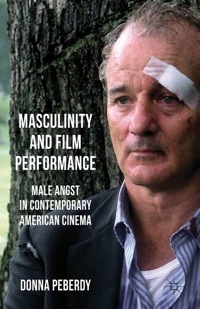 Masculinity and Film Performance: Male Angst in Contemporary American Cinema by Donna Peberdy (Palgrave Macmillan).
Masculinity and Film Performance: Male Angst in Contemporary American Cinema by Donna Peberdy (Palgrave Macmillan).
In a contribution to the emerging field of screen performance studies, a senior lecturer in film and television studies at Southampton Solent University, UK explores the performance of male angst in American film and popular culture during the 1990s and 2000s. In relation to such films as Broken Flowers, Far From Heaven, Pleasantville, Magnolia, and Wonder Boys, she considers theories of film acting, masculinity, performance, and cultural studies, and social, cultural, historical, and political contexts that have shaped and affected the performance of masculinity on screen, such as the aging of the baby boom, the launch of Viagra onto the marketplace, the ‘Iron John’ and ‘Wild Man’ phenomena, and the racially marked fatherhood crisis. Peberdy’s research and publications focus on performance, masculinity and sexuality in American cinema; she is co-editing a collection of essays titled Tainted Love: Screening Sexual Perversities.
n
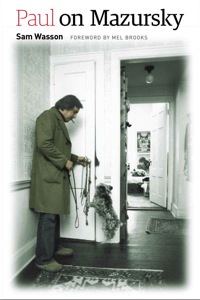
Paul on Mazursky, by Sam Wasson (Wesleyan University Press).
Wasson, the author of the best-selling Fifth Avenue, 5AM: Audrey Hepburn, Breakfast at Tiffany’s, and the Dawn of the Modern Woman, and A Splurch in the Kisser: The Movies of Blake Edwards, who is now working on a biography of Bob Fosse, conducts a series of conversations with comic-movie director Paul Mazursky about the writer/director’s sustained comic run in the 1970s and 1980s of almost 20 films. In the first ever book-length examination of one of America’s most important and least appreciated filmmakers, Wasson argues that Mazursky’s movies – Bob & Carol & Ted & Alice; An Unmarried Woman; Enemies, A Love Story – have not been given their due, perhaps because their mix of the sincere, the ridiculous, the realistic, the romantic, and “pure emotion,” makes them difficult to classify. Wasson and Mazursky go over the latter’s work one film at a time, discussing his life in and out of Hollywood. In the Wesleyan Film series.
n
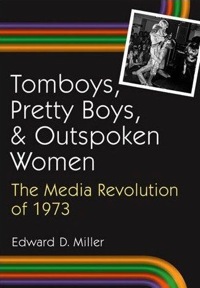 Tomboys, Pretty Boys, and Outspoken Women: The Media Revolution of 1973 by Edward D. Miller (University of Michigan Press)
Tomboys, Pretty Boys, and Outspoken Women: The Media Revolution of 1973 by Edward D. Miller (University of Michigan Press)
An associate professor of media culture at The College of Staten Island and of theatre and film studies at the Graduate Center of the City University of New York links current fascination with reality television – reality programs, faux documentaries, and user generated content: real or feigned nonfictionality – to developments in the 1970s. It was then, he argues, that American media discovered the entertainment value of documentaries, news programming, and other nonfiction forms: John Dean’s performance in front of the Senate during the Watergate Hearings; Billie Jean King popularizing tennis by taking on Bobby Riggs in a prime-time match; David Bowie experiencing “outer space” in his tours across America; An American Family and their gay son facing the public’s consternation; Alison Steele, a female DJ, inviting listeners to fly with her at night. The early 1970s was a turning point in American culture, Miller suggests: Nonfiction media created, for example, new possibilities for expressions of gender, sexuality, and other aspects of identity that remain in force now. Miller aims to demystify current media trends by providing an analysis of the recent past.
n
July 2011
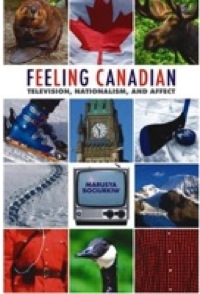 Feeling Canadian: Television, Nationalism, and Affect, by Marusya Bociurkiw (Wilfrid Laurier University Press)
Feeling Canadian: Television, Nationalism, and Affect, by Marusya Bociurkiw (Wilfrid Laurier University Press)
A filmmaker and assistant professor of media theory at Ryerson University in Toronto analyzes nationalist feeling and Canadian television from 1995 to 2002 from the standpoint of affect theory, which deals with such concepts and effects as changeability, fluidity, and contagion. She asks how certain images come to be consumed as emblems of the country. She tracks the ways that ideas about the Canadian nation flow from screen to audience.
n
Film Festivals: Culture, People, and Power on the Global Screen by Cindy Hing-Yuk Wong (Rutgers University Press).
A professor of media cultures at the College of Staten Island, City University of New York (coauthor of Global Hong Kong and coeditor of the Encyclopedia of Contemporary American Culture) explores the role of festivals in the film industry. She considers the constellations of art, business, and glamor represented by the gatherings of movies, stars, directors, and critics. She writes about the history of such events. She also situates festivals within changing global practices of film, and explores the events’ construction of cinema knowledge.
n
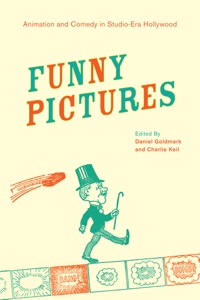 Funny Pictures: Animation and Comedy in Studio-Era Hollywood edited by Daniel Goldmark and Charlie Keil (University of California Press)
Funny Pictures: Animation and Comedy in Studio-Era Hollywood edited by Daniel Goldmark and Charlie Keil (University of California Press)
Goldmark , an associate professor of music at Case Western Reserve University and the author of Tunes for ‘Toons: Music and the Hollywood Cartoon, and Keil, an associate professor of cinema studies at the University of Toronto and the author of Early American Cinema in Transition and American Cinema’s Transitional Era, present essays by leading scholars of animation who explore the link between comedy and animation in studio-era cartoons, from filmdom’s earliest days through the twentieth century. They ask why animation became associated with comedy so early and so indelibly when animation and humor came together at a pivotal moment in motion-picture history. To examine some of the central assumptions about comedy and cartoons and to explore the key factors that promoted their fusion, the book analyzes many of the key filmic texts from the studio years that exemplify animated comedy. Funny Pictures also looks ahead to show how this vital American entertainment tradition still thrives today in works ranging from The Simpsons to the output of Pixar.
n
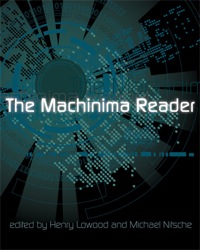 The Machinima Reader, edited by Henry Lowood and Michael Nitsche (MIT Press)
The Machinima Reader, edited by Henry Lowood and Michael Nitsche (MIT Press)
In the first critical overview of the subject, Lowood, curator for history of science and technology collections and film and media collections in the Stanford University Libraries, and Nitsche, an assistant professor of literature, communication, and culture at Georgia Institute of Technology, gather essays about machinima, the use of computer-game engines to create movies. (The term “Machinima” combines “machine” and “cinema” to describe the process of using videogame engines and properties to create real-time animation.) The editors note that, over the last decade, enthusiasts have driven the phenomenon of machinima, teaching themselves to deploy technologies from computer games to create animated films quickly and cheaply. Academic and artist-practitioner contributors explore real-time production, machinima as a performative and cinematic medium, and the legal, cultural, and pedagogical contexts for machinima.
n
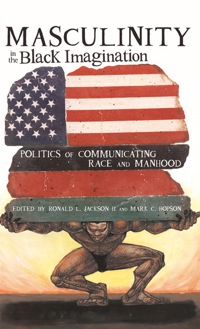 Masculinity in the Black Imagination: Politics of Communicating Race and Manhood edited by Ronald L. Jackson II and Mark C. Hopson (Peter Lang Publishing)
Masculinity in the Black Imagination: Politics of Communicating Race and Manhood edited by Ronald L. Jackson II and Mark C. Hopson (Peter Lang Publishing)
Essays on black masculinity in such contexts as prime-time television depictions of queer identity, the black Greek-letter fraternity, and the criminalization of black manhood in contemporary America.
n
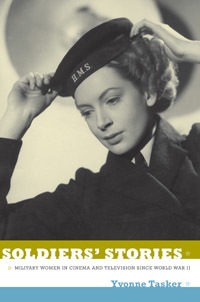 Soldiers’ Stories: Military Women in Cinema and Television since World War II, by Yvonne Tasker (Duke University Press)
Soldiers’ Stories: Military Women in Cinema and Television since World War II, by Yvonne Tasker (Duke University Press)
A professor of film studies at the University of East Anglia (author of Working Girls: Gender and Sexuality in Popular Cinema and Spectacular Bodies: Gender, Genre and the Action Cinema, andco-editor of Interrogating Postfeminism: Gender and the Politics of Popular Culture) examines military women as contradictory figures, neither soldier nor woman enough, in popular film and television – in musicals, screwball comedies, and action thrillers. She traces changing roles and expectations for women: as temporary necessities of “total war” during WW2, as nurses whose caring femininity offered a solution to the “gender problem,” through to 1970s isolated victims and heroines in thrillers and legal and crime dramas.
n
n
June 2011
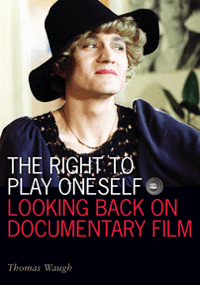 The Right to Play Oneself: Looking Back on Documentary Film, by Thomas Waugh (University of Minnesota Press). A professor of film studies at Concordia University, Montreal, discusses “committed” documentary. The book collects for the first time his essays (1974-2008) which relate the media form to the history of the Left, and address how the documentary film’s history and aesthetics bears on issues of the democratic performance of citizens and artists. Waugh analyzes an international selection of films from the 1920s to the present – from those of the industrialized societies of North America and Europe to those of 1980s India. He addresses such canonical directors as Dziga Vertov, Emile de Antonio, Barbara Hammer, Rosa von Praunheim, and Anand Patwardhan. Includes discussions of LGBT documentary pioneers and the firebrand collectives that changed the history of documentary, such as Challenge for Change and ACT UP’s Women’s Collective. In the Visible Evidence series.
The Right to Play Oneself: Looking Back on Documentary Film, by Thomas Waugh (University of Minnesota Press). A professor of film studies at Concordia University, Montreal, discusses “committed” documentary. The book collects for the first time his essays (1974-2008) which relate the media form to the history of the Left, and address how the documentary film’s history and aesthetics bears on issues of the democratic performance of citizens and artists. Waugh analyzes an international selection of films from the 1920s to the present – from those of the industrialized societies of North America and Europe to those of 1980s India. He addresses such canonical directors as Dziga Vertov, Emile de Antonio, Barbara Hammer, Rosa von Praunheim, and Anand Patwardhan. Includes discussions of LGBT documentary pioneers and the firebrand collectives that changed the history of documentary, such as Challenge for Change and ACT UP’s Women’s Collective. In the Visible Evidence series.
Stagnating under the heel of the secrecy-obsessed, budget-slashing, and culture-hating Conservative minority government in Ottawa, the National Film Board of Canada no longer allows access for film scholars.
Thomas Waugh reflects on his use of archives
Since the 10 essays were written between 1974 and 2008, they dramatically reflect the evolution of archive resources for film scholars over those three-and-a-half decades. The first ones were written in the pre-video years when one had to be lucky enough to catch public screenings – maybe a given film twice if a miracle – and hope that your notes and your memory were accurate enough to serve. And graduate students could seldom afford to pay to see 16mm films on Steenbecks at film study centers. Later essays were written during the VHS era, and whole different dynamics of accessibility and analysis were in play, from bootleg issues around quality and broadcast censorship, to the nagging insecurity of sometimes never getting to see a work on the big screen for which it was intended. The essay most recently written (2008), on the National Film Board of Canada’s “Challenge for Change/Société nouvelle” program of community-based “catalysis” (1967-1980), was riding the crest of the paradigm-shifting availability of films through online downloading and streaming.
As for “paper archives,” my 10 essays benefited from the resources of such archives as the Museum of Modern Art, the Anthology Film Archives, the Cinémathèque québécoise, the Joris Ivens Archives then housed at the Nederlands Filmmuseum and more recently at the Joris Ivens European Foundation, the National Film Archives of India, our own Concordia University archive, the National Film Board of Canada – not to mention private collections and community LGBTQ archives in Montreal, Toronto, and San Francisco, where one often went for stuff that official archives didn’t collect or hid (accidentally or on purpose). Some of these archives seemed underfunded at the time, but no doubt in the era of privatization and cutbacks, the situation may now actually be worse in terms of accessibility and resources – with the internet only partially compensating for the new austerity.
The archives of the National Film Board of Canada is both a case in point and a desperately unique situation: My chapter and our accompanying anthology that came out last year (Challenge for Change: Activist Documentary at the National Film Board of Canada, co-written with Ezra Winton and Mike Baker) may actually be the last ever work to benefit from access to these splendid publicly owned collections (everything from 1940s notes by itinerary projectionists to early drafts of treatments or research “investigates” for films both epochal and obscure, in both official languages). Stagnating under the heel of the secrecy-obsessed, budget-slashing, and culture-hating Conservative minority government in Ottawa, the NFB no longer allows access for film scholars to the rich collections that earlier led to the groundbreaking work by film historians such as Gary Evans, Pierre Véronneau, Zoe Druick, and the late Peter Morris (to mention only four of the most distinguished Canadian researchers). NFB administrators, pretending that their archive was never in fact a public resource, pretending not to know what historical research actually consists of (“Our films are all available: look at them online or at our downtown screening centers”), and claiming that the directives from on high leave this short-staffed, publicly funded national institution no choice – all because of “privacy concerns”! Researchers are now required to submit “access to information” requests, wait months for an answer, and too bad if they’re too broad or imprecise (fishing and browsing are not permitted), or else they must use the predigested DVD document selections that they provide to undergraduate term-paper writers.
Well, this note turned into a lament for the loss of a precious archive, but it certainly demonstrates I hope the vital role of the moving-image archive constituency in keeping alive our memory and knowledge of our moving image past, and the urgent need for unwavering vigilance in keeping repositories of documents and moving images accessible and accountable. The Canadian Film Studies community (and the American researchers who were turned away at the door last summer because you have to be Canadian to submit an information request) will not give up without a fight.
n
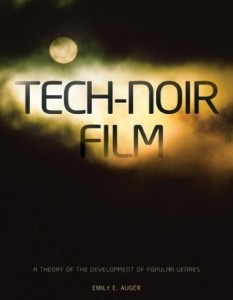 Tech-Noir Film: A Theory of the Development of Popular Genres by Emily E. Auger (Intellect Books, UK; distributed in US by University of Chicago Press)
Tech-Noir Film: A Theory of the Development of Popular Genres by Emily E. Auger (Intellect Books, UK; distributed in US by University of Chicago Press)
The independent Canadian scholar explores literary precursors and cinematic examples of a genre embodied in such works as Blade Runner and James Cameron’s hit Terminator. She writes that tech-noir has roots in both the Promethean myth and the earlier popular traditions of gothic, detective, and science fiction. She discusses many well-known film and literary works – including The Matrix, RoboCop, and Mary Shelley’s Frankenstein.
n
May 2011
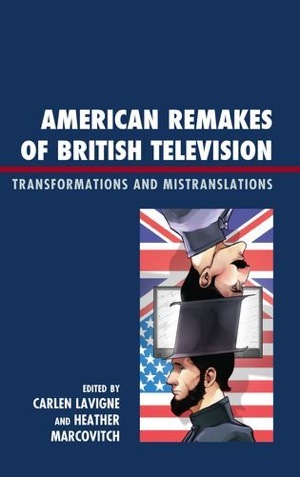 American Remakes of British Television: Transformations and Mistranslations, edited by Carlen Lavigne and Heather Marcovitch (Lexington Books)
American Remakes of British Television: Transformations and Mistranslations, edited by Carlen Lavigne and Heather Marcovitch (Lexington Books)
Essays on American shows, 1971 to the present, like Queer as Folk, What Not to Wear, American Idol, The Office, Sanford and Son, and Life on Mars that have attempted, generally with abysmal results, British TV programmes. The trend may well have begun with Norman Lear’s All in the Family, a limp remake of Till Death Us Do Part. Why do they bother? And what does it mean that some of the American adaptations, includingThe Office, What Not to Wear, and American Idol, have gained so much cultural traction? What does Americanization entail; what market forces drive the phenomenon, what differences do they demonstrate in such cultural conceptions as sexual identity and politics?
n
Conjuring the Real: The Role of Architecture in Eighteenth- and Nineteenth-Century Fiction edited by Rumiko Handa and James Potter (University of Nebraska Press)
Essays on how historical buildings have figured in artists’, writers’, and filmmakers depictions of the past, from the mid-eighteenth through the nineteenth centuries. As historical consciousness expanded, buildings became projections of creative artists’ conceptions of the past, and of the course of history. During the film era, that trend continued; during the age of blockbuster films, filmmakers have used historically significant buildings as locations that concretely conjure past eras for contemporary viewers. Conjuring the Real traces the practices of using architecture for this kind of representation; contributors examine ways that creators used them to shape their audiences’ historical imagination.
n
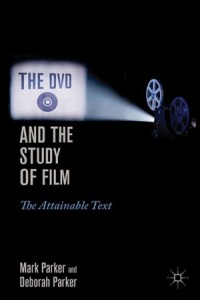 The DVD and the Study of Film: The Attainable Text by Mark Parker and Deborah Parker (Palgrave Macmillan)
The DVD and the Study of Film: The Attainable Text by Mark Parker and Deborah Parker (Palgrave Macmillan)
A professor of English at James Madison University and a professor of Italian at the University of Virginia consider how the study and reception of film has changed with the advent of movies on DVD “contextualized” with “extras” such as commentaries by directors, writers, and actors. The book draws on interviews with DVD producers, directors, and scholars to explore how the format can combine the enthusiasm of a fan, cinematic nostalgia, and scholarly insight. The book includes a chapter on The Criterion Collection as standard-setter and a case study of the films of Atom Egoyan.
Deborah and Mark Parker discuss their research:
Much of the research for this book was conducted through interviews with DVD producers. We were very fortunate to have access to a living archive. The moment for such research was propitious; we not only spoke with many of the producers who worked with Criterion in its laserdisc days but also to producers who worked under the more fluid rules of the early days of the DVD.
Their recollections were important given the uneven nature of the archives. Libraries, quite understandably, have been slow to recognize the value of the early versions of DVDs (and laserdiscs), and, given the unexpected fragility of the DVD, the maintenance of digital collections has proven difficult. Once damaged, the replacement version of a DVD often does not include some of the most interesting supplementary material. Hence some of the best audio commentaries have not been reissued, and access to them is difficult.
n
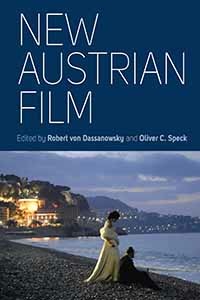 New Austrian Film edited by Robert von Dassanowsky and Oliver C. Speck (Berghahn Books)
New Austrian Film edited by Robert von Dassanowsky and Oliver C. Speck (Berghahn Books)
A volume of essays on the work of Austrian and Austrian-trained filmmakers. Authors contend that despite the accomplishments of filmmakers like of Barbara Albert, Michael Haneke, Stefan Ruzowitzky, and Ulrich Seidl, Austrian film has been under-appreciated, to date, for its politically and aesthetically significant filmmaking over the past decade, achieved despite poor funding. One editor, Robert von Dassanowsky, a professor of German and film studies at the University of Colorado at Colorado Springs, previous wrote Austrian Cinema: A History (2005), the first English language survey of that nation’s film art. The other, Oliver C. Speck, an assistant professor of film studies at Virginia Commonwealth University, has written about narrative strategies and the representation of memory and history in European cinema in such books as Funny Frames: The Filmic Concepts of Michael Haneke (2010).
n
New Trends in Argentine and Brazilian Cinema edited by Cacilda Rego and Carolina Rocha (Intellect Books, distributed by University of Chicago Press)
Essayists address such topics as how the two countries’ filmmakers responded in the early 1990s to neoliberal policies that ended decades of government funding for cinema. When film production, distribution, and exhibition were hit, filmmakers and their supporters fought successfully by the mid-1990s for new laws that reestablished subsidies and credit lines and allowed for a rebirth of national cinema in both countries. Contributors consider this success story in light of commercially successful films, the effects of globalization and cultural policies on public incentives for filmmaking, and other influences.
n
Stephen King on the Small Screen by Mark Browning (Intellect Books, distributed by University of Chicago Press)
A study of television versions of King’s books, from such highly successful projects as The Stand and The Night Flier to the lesser-known TV films Storm of the Century, Rose Red, Kingdom Hospital, and the 2004 remake of Salem’s Lot. Browning, a free-lance author (David Cronenberg: Author or Filmmaker? and Stephen King on the Big Scree, 2009, Intellect) based in Germany, asks what it is that makes King’s fiction so suited to the small screen; he asks, for instance, what makes a written or visual text successful at evoking fear, and examines the relationship between big and small screen, and their greater effectiveness from King adaptation to King adaptation. In this follow up to Stephen King on the Big Screen, Mark Browning considers the best-selling author’s much-neglected work in television, examining what it is about King’s fiction that makes it particularly suitable for the small screen.
n
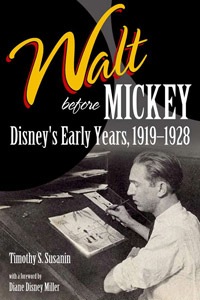 Walt Before Mickey: Disney’s Early Years, 1919-1928, by Timothy S. Susanin (University Press of Mississippi)
Walt Before Mickey: Disney’s Early Years, 1919-1928, by Timothy S. Susanin (University Press of Mississippi)
Susanin relates the great animator and filmmaker’s life before 1928, when he released Steamboat Willie, the film that secured his reputation and was the first Disney Studio cartoon with synchronized sound, and with Mickey Mouse. Susanin, the general counsel of a Fortune 500 company when he’s not exploring Disney, focuses on Disney’s work in advertising and commercial art in Kansas City after serving in France in World War I, and before his more-famous period as the creator of Mickey and his friends. The book recounts the great animator’s years of struggling with, failing at, and eventually mastering the art and business of animation. From the age of 17, Disney worked in various venues and studios, refining his later, Disney style. He had served in the Red Cross in France after World War I, then returned to his native Kansas City to work in advertising and commercial art. He set up four studios – Kaycee Studios, Laugh-O-gram Films, Disney Brothers Studio, and Walt Disney Studio. He created such series as the Laugh-O-Grams, one-minute topical cartoons for a local theater owner. Soon after, with borrowed money, he created the Oswald the Rabbit series, and then the Alice Comedies, which combined live action and animation. Then he moved to Los Angeles to join his brother, Ray, and the rest would become history. Susanin uses company documents, private correspondence between Walt and Roy, contemporary newspaper accounts, and new interviews with Disney’s associates to provide a detailed sense of this part of Disney’s career. He answered some questions about his project.
Before Disney settled on Mickey Mouse as his first major character, in the years you write about, from 1919-1928, he made a series of films with a different main character, a little girl named Alice. Can you tell me a little about those films – what kind of films they were, how many of them Disney made, and why he decided not to continue with these “Alice Comedies”?
Actually, Mickey was not Walt’s first major character. There was a recurring cast comprised of a girl, a boy, a dog, and a cat, in the Laugh-O-gram Fairy Tales he made at Kaycee Studios and Laugh-O-gram Films in 1921 and 1922. His Alice Comedies series, 1924-1927, starred Alice (live-action) and a cat named Julius (animated). He created and animated a series called Oswald the Lucky Rabbit from 1927-28 (other animators continued that series after Walt had a falling out with the distributor in 1928). As to your question about the Alice Comedies: The series featured a live-action girl named Alice and her adventures in a cartoon world. She was seen with many animated animals, but her co-star was a black cat named Julius. There were 50 Alice shorts (one reel subjects) made between 1923 and 1927 (the first was not released until 1924). Over the course of the series, four young girls played Alice. In the earliest episodes, live-action sequences featuring Alice and her friends (played by children from the neighborhood surrounding the Kingswell Avenue location of the Disney Brothers Studio) opened and closed the reels. After a number of episodes, these live action sequences were dropped. The Alice Comedies ended in 1927, when Universal asked Walt’s distributor, the M.J. Winkler firm out of New York, to provide it with a series based on a rabbit. The Winkler company asked Walt to create and animate the new series, and the start of the Oswald series caused the end of the Alice series.
How many Alice films did he make, and what became of them? Are they well preserved and archived? Where?
Forty of the 50 Alice shorts are known to exist. Some are owned by the Disney company; others are in private collections, here and abroad. I viewed some at the Library of Congress and the Museum of Modern Art. The best place for a listing of the Alice shorts (and where they may be found) is the book, Walt in Wonderland, by Merritt and Kaufman.
The Walt Disney Treasures collections series issued seven of the Alice films on DVD. Where did those come from, and have more been issued, or are others slated for issue?
I do not know if the Disney Treasures collection will do another Alice-based release. To the best of my knowledge, Disney has not announced the release of more.
Disney made other pre-Mickey films, too, right? Can you tell me a little about those – the Oswald the Lucky Rabbit films, for example. And the “Newman Laugh-O-Grams”? And what became of them?
You are correct. See my answer to number one above for the details. The Newman Laugh-O-Grams were cartoons made for a local theater in Kansas City in early 1921. Walt, who then worked at a film advertising company called the Kansas City Film Ad Company, made these cartoons after work. He would animate them in the evenings in his father’s garage behind the Disney family home in Kansas City, Missouri. A few of these cartoons exist, and can be found on certain Disney DVDs. (The endnotes to my book cite to the DVDs where I found such cartoons).
Have any pre-Mickey Disney films gone missing? Is it clear how many were made, and what might have become of them?
Some of the Newman films, and a Kacyee Studios series called Lafflets, no longer exist. (See the Epilogue of my book for a summary of the state of each series today). All seven Laugh-O-gram Fairy Tales exist (some were just found this year – see David Gerstein’s Ramapith Prehistoric Pop Culture Blog and its October 14, 2010 story on recently found Laugh-O-grams). As mentioned above, 40 of 50 Alices survive. The Oswald series appeared into the 1930s, but Walt’s connection to it ended after its first season, which was comprised of twenty-six shorts made in 1927 and 1928. Thirteen of those survive.
Is active searching under way to unearth other early Disney material, and how often is anything discovered?
I do not know what efforts the Disney company or the Walt Disney Family Foundation (which runs the Walt Disney Family Museum in San Francisco) are undertaking.
For that matter, what is the overall situation with respect to the preservation and reissue of post-Mickey films?
The Disney company has an extensive Film Library which I imagine is responsible for the post-Mickey works.
What led Disney to switch from his earlier characters to Mickey and co.?
The last chapter of my book explains in great detail – informed by Walt’s letters home to Roy – how Walt lost the Oswald series to an unscrupulous distributor named Charlie Mintz during negotiations for season two in New York City in early 1928. The Disney-Pixar movie entitled Up made reference to Mintz’s role as a real live Disney antagonist by featuring a villain named Charles Muntz.
n
April 2011
Adapting Detective Fiction: Crime, Englishness, and the TV Detectives by Neil McCaw (Continuum)
A senior lecturer in English and creative writing at the University of Winchester (UK) discusses the source fiction and adaptations of such British programs as Adventures of Sherlock Holmes, Miss Marple, Inspector Morse, A Touch of Frost, Cadfael, and Midsomer Murders. He pays particular attention to the role that TV detective fiction has recently played in the politics of representation – the mutually-informing interrelation of cultural texts and political rhetoric the connection between the popular-cultural depiction and understanding of crime and criminality; and what the process of adaptation reveals about the social changes and the evolving nature of “Englishness.”
Neil McCaw’s Detective Work:
In a way, because of the subject focus of my book (English televisual popular culture), by definition many of the archival challenges and difficulties that many researchers face in mapping the cultural history of moving images did not apply in my case; the TV programmes I was working on (Granada Sherlock Holmes, BBC Miss Marple, ITV Morse, Frost, Cadfael, Midsomer) are readily available on DVD – there was a minor issue with the Marple series, which I had to watch on VHS in the early stages of the project because there was no UK DVD edition, but that was no great hardship.
Where the issue of archives did become significant (other than in researching the wider political context of the 1970s-1990s in the UK, in which a variety of political resources (speeches, policy documents etc.) became particularly relevant) was with the early section of the book on Sherlock Holmes adaptations. Clearly, Holmes is among (probably the) most adapted fictional characters ever to have been created, and tracking down, identifying, viewing etc. the enormous volume of relevant cinematic, televisual, and wider cultural material was a major challenge. If I’m honest, I didn’t manage it. There are I am sure many examples (of the literally 10s of 100s of 1000s) that I didn’t get to. But in finding my way through the morass I was indebted to The Arthur Conan Doyle Collection, Lancelyn Green Bequest at Portsmouth, and the Sherlock Holmes/Conan Doyle Collections at the University of Minnesota and Toronto (both of which have good online presences); all helped me put down markers to better comprehend the territory I was trying to map. I would also like to make special mention to Harvard University, who screened a delightful (and now my personal favourite) Holmes movie, the wonderful The Mystery of the Leaping Fish (1916) starring Douglas Fairbanks. I had not even heard of this film before I attended this screening, and my view of Holmes has never been the same since. For those who know this film, how ever could it?
http://www.youtube.com/watch?v=6E9G4JDkh_A
n
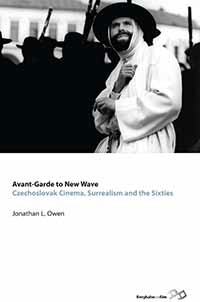 Avant-Garde to New Wave: Czechoslovak Cinema, Surrealism, and the Sixties by Jonathan L. Owen (Berghahn Books)
Avant-Garde to New Wave: Czechoslovak Cinema, Surrealism, and the Sixties by Jonathan L. Owen (Berghahn Books)
After completing his doctorate on Czech cinema at the University of Manchester, Owen examines avant-garde influences on Czech New Wave cinema – films like Closely Watched Trains, Daisies, and Valerie and Her Week of Wonders – that followed the cultural liberalization of communist Czechoslovakia in the 1960s. Then, he writes, filmmakers engaged with the avant-garde, particularly Surrealism, in part inspired by a yearning for broader political freedoms.
Jonathan Owen on how to find Czech film
When I began my doctoral research on Czech and Slovak cinema, I realized that tracking down films would present a challenge, and I found it necessary to cast my net – whether over the Net or elsewhere – as wide as possible. Screenings at film archives comprised a significant part, though by no means the bulk, of my viewing. I saw prints at both the BFI in London and the National Film Archive in Prague (an excellent archive and one of the world’s oldest, though many of its native holdings are of course unsubtitled). The libraries of these institutions, along with the library of the Czech national film school FAMU, were also extremely useful as a source of film-related literature.
Yet I generally sought to obtain films on DVD or VHS, as this would enable me to watch them multiple times and focus on small details. This process was made easier as new online DVD outlets sprang up in the Czech Republic and Slovakia. Initially I leaned heavily on US resources such as Chicago’s Facets Multimedia store (www.facets.org/), but gradually I came to rely more on Czech, Slovak, and even Polish outlets such as www.dvdr.cz, www.gorila.sk, and www.merlin.pl. The latter two stores are particularly recommended for their reliability, relatively inexpensive shipping rates, and user-friendly sites (although Gorila does not offer an English-language option when navigating the site). Non-virtual visits to Prague’s second-hand record shops and ‘antikvariaty’ proved worthwhile in turning up out-of-print DVDs and books.
I also relied on the time-honored method of trading, and borrowed DVDs and tapes from friends and colleagues or from academics and film writers whom I contacted online. Often the films obtained by these methods were not commercial releases but private recordings of television broadcasts. Such recordings were often a godsend, notwithstanding their sometimes inadequate presentation (TV recordings of films dubbed into other languages required the supplement of published Czech-language screenplays). Yet whatever the flaws, byways, and costs involved, I ultimately managed to find all the texts I required.
The present situation is actually considerably better for researchers and fans of Czech and Slovak cinema than when I began my project, with many films now available more easily, in better condition and at a cheaper price. The Czech State Fund for film and the Slovak Film Institute have released many classic films on DVD (often with English subtitles), and over the last few years the British company Second Run has been busy rectifying the meager presence of East European cinema on UK DVD with its excellent sourced and extra-stocked releases.
n
Below the Line: Producers and Production Studies in the New Television Economy, by Vicki Mayer (Duke University Press)
An associate professor of communication at Tulane University, who co-edited Production Studies: Cultural Studies of Media Industries and edits the journal Television and New Media, examines the roles of varied television personnel, such as television-set assemblers, soft-core cameramen, reality-program casters, and public-access and cable commissioners in relation to the globalized economy of the television industry. She argues that such workers increasingly exert creative influence, contradicting the industry’s self-conception as one created by the talented few. She says, for example, that television set assemblers in Brazil devise creative solutions to the problems of material production; soft-core videographers develop their own modes of professionalism in creating content for television; and everyday people become casters by packaging participants for reality programs; and volunteers administer local cable television policies. Mayer argues that the undervalued labor of production workers like those must be factored into any understanding of the new television landscape.
n
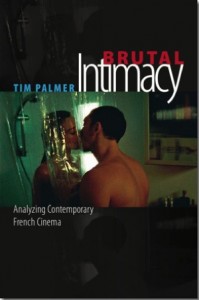 Brutal Intimacy: Analyzing Contemporary French Cinema by Tim Palmer (Wesleyan University Press, distributed by University Press of New England)
Brutal Intimacy: Analyzing Contemporary French Cinema by Tim Palmer (Wesleyan University Press, distributed by University Press of New England)
Palmer, an associate professor of film at the University of North Carolina at Wilmington, contends that a pervasive cinephilia – among filmmakers, audiences, the whole film system – has increasingly underpinned French cinema since 2000; he sees I in popular films, but also in such confronting genres as the transgressive cinema du corps – body films – that have been prominent in recent years. He discusses such directors as Claire Denis, Bruno Dumont, and Gaspar Noe, and notes the generous representation of women among the ranks of newcomers, thanks in good part to the French national system of fostering young talent.
n
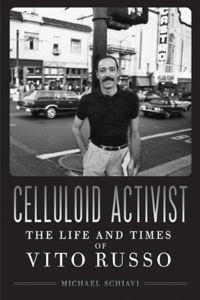 Celluloid Activist: The Life and Times of Vito Russo by Michael Schiavi (University of Wisconsin Press)
Celluloid Activist: The Life and Times of Vito Russo by Michael Schiavi (University of Wisconsin Press)
A biography of the leading gay-rights activist and film historian, who is known for his 1981 work, The Celluloid Closet: Homosexuality in the Movies, an early and enduring foundational text of gay and lesbian film studies. Schiavi, an associate professor of English at the New York Institute of Technology’s Manhattan campus, uses archival materials, unpublished letters and journals, and more than 200 interviews with Russo’s friends and family members to detail Russo’s life, beginning with a childhood in East Harlem. During the 1960s, 1970s, and 1980s, Russo became a pioneering journalist and author about gay issues, a founding member of the Gay and Lesbian Alliance Against Defamation (GLAAD), and a cofounder of the AIDS Coalition to Unleash Power (ACT UP). Among many cultural and social activities, he organized movie nights as forerunners to his worldwide Celluloid Closet lecture tours, which have gay audiences a community forum to discuss gay imagery in mainstream film.
n
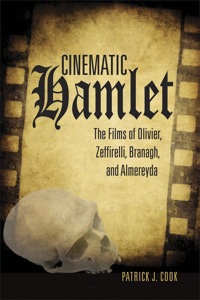 Cinematic Hamlet: The Films of Olivier, Zeffirelli, Branagh, and Almereyda by Patrick J. Cook (Ohio University Press/Swallow Press)
Cinematic Hamlet: The Films of Olivier, Zeffirelli, Branagh, and Almereyda by Patrick J. Cook (Ohio University Press/Swallow Press)
An associate professor of English at George Washington University applies insights from neuroscience and communications psychology in a scene-by-scene analysis of four film versions of Shakespeare’s play. He seeks to show how the films – by Laurence Olivier, Franco Zeffirelli, Kenneth Branagh, and Michael Almereyda – rework Shakespeare’s play into powerful films by cannily deploying film devices.
n
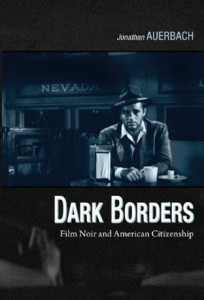 Dark Borders: Film Noir and American Citizenship by Jonathan Auerbach (Duke University Press)
Dark Borders: Film Noir and American Citizenship by Jonathan Auerbach (Duke University Press)
A professor of English at the University of Maryland at College Park (and author of Body Shots: Early Cinema’s Incarnations), shows how anxieties about citizenship and national belonging in midcentury America connects to the sense of alienation conveyed by American film noir. He refers mainly to a dozen canonical and lesser-known films noirs, including Double Indemnity, Out of the Past, and Pickup on South Street, and less familiar noirs such as Stranger on the Third Floor, The Chase, and Ride the Pink Horse, and considers them in relation to a series of U.S. national security measures enacted from the mid-1930s to the mid-1950s that cast doubt on who was properly American. Contributing to and expressing the alienation and confusion of the era, Auerbach writes, were such historical developments and film elements as the presence of the Gestapo in America, and the United States’ blurred borderlines with Cuba and Mexico, all in a time of cold war, heightened security, and thus paranoia and suspicion. (Among Auerbach’s other books is Body Shots: Early Cinema’s Incarnations (U California, 2007).
Jonathan Auerbach on Hunting Down the Film Noir
My previous book, Body Shots, clearly presented more challenges for archival issues than the current one. I am fortunate to live near the Library of Congress , where I did most of the early cinema research for Body Shots. Since film noir is a relatively popular genre, virtually all of the movies I discuss in Dark Borders with the exception of Ride the Pink Horse and a few others are readily available on DVD, although some important ones such as Stranger on the Third Floor and Confessions of a Nazi Spy came out only after I started working on the book, and so initially I had to turn to private collectors and scour TCM cable screenings for these titles. Then of course, there was the curious circumstance that arguably the greatest and most well-known of these films, Wilder’s Double Indemnity, had to wait until 2006 for its digitally remastered release! I would say another curiosity is that due to the power of the term “noir,” movies (DVDs) now get marketed under that rubric that sometimes have little to do with that genre as film scholars tend to use the category.
n
 Detecting Women: Gender and the Hollywood Detective Film by Philippa Gates (State University of New York Press)
Detecting Women: Gender and the Hollywood Detective Film by Philippa Gates (State University of New York Press)
An associate professor of film studies at Wilfrid Laurier University, Ontario (Detecting Men: Masculinity and the Hollywood Detective Film; coeditor, The Devil Himself: Villainy in Detective Fiction and Film) traces the evolving figure of the female detective from her pre-cinematic origins in nineteenth-century detective fiction through her many incarnations in more than 300 Hollywood films. She argues that while a popular assumption is that images of women have become increasingly positive over this period, the most progressive and feminist models of the female detective exist in mainstream film’s more peripheral products, such as 1930s B pictures and 1970s blaxploitation films. She finds that such films found room for a fantasy resolution of social anxieties about crime and even gender. The book, says Linda Mizejewski, author of Hardboiled and High Heeled: The Woman Detective in Popular Culture, “makes a huge contribution by giving extensive treatment to the female detectives in B movies and to the many investigating women characters in films not usually considered detective films.”
Philippa Gates describes her archival work
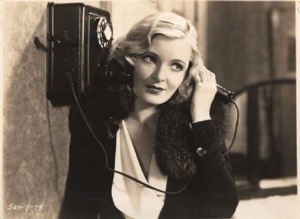
Having said that, I must point out that UCLA did let me pay to screen some 35mm archive prints on a Steenbeck flatbed where they keep their nitrate prints – films that were otherwise impossible to find and for that I am most grateful. I remember there was one film (Sob Sister) that was listed as a “unique” print and under “restricted use” (and therefore not necessarily viewable); the junior archivist who screened the film for me said “Take good notes as this may be the only time you are allowed to watch it.” She also said that I was likely the first person to watch the film since it was screened in 1931. That gave me such a thrill to think that I was bringing to light, through my research, films that had been forgotten. Sometimes the archivists would watch the films with me (with their own set of headphones) and one told me that he really enjoyed the film (I think it was The Office Scandal) and didn’t know that they made films “like that” (i.e., with plucky detective heroines) “back then” (i.e., 1928).
n
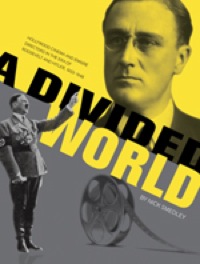 A Divided World: Hollywood Cinema and Emigre Directors in the Era of Roosevelt and Hitler, 1933-1948 by Nick Smedley (Intellect Books, distributed by University of Chicago Press)
A Divided World: Hollywood Cinema and Emigre Directors in the Era of Roosevelt and Hitler, 1933-1948 by Nick Smedley (Intellect Books, distributed by University of Chicago Press)
A freelance film historian who teaches at London University traces the way that three directors, Fritz Lang, Ernst Lubitsch, and Billy Wilder, exemplify and stand apart from other Hollywood directors’ embrace of the New Deal, and of the sweeping and idealistic social, political, and cultural changes it brought to the United States as the country rebuilt after the Great Depression. He also describes the postwar paranoia that replaced that progressive spirit – and the kind of optimism exemplified by the likes of Frank Capra, and patriots like John Ford – and Hollywood was swept for purported communist infiltration.
n
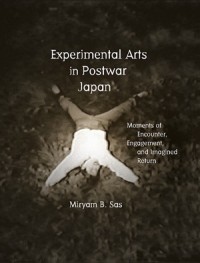 Experimental Arts in Postwar Japan: Moments of Encounter, Engagement, and Imagined Return by Miryam Sas (Harvard University Asia Center, distributed by Harvard University Press)
Experimental Arts in Postwar Japan: Moments of Encounter, Engagement, and Imagined Return by Miryam Sas (Harvard University Asia Center, distributed by Harvard University Press)
An associate professor of comparative literature and film studies at the University of California at Berkeley examines important moments in Japanese arts from the 1960s to the early 1980s, focusing on underground (post-shingeki) theater and on related works of experimental film and video, buto dance, and photography during an era of postwar activism and idealism in Japan. She emphasizes the sophisticated theoretical grounding of the developments, and locates experimental arts in a sustained dialog with key issues in critical theory.
Miryam Sas on the challenges of studying Japanese experimentalism
It is still very hard to research experimental/underground theater in Japan, but there are some key places to go. The first and most important place is to develop and build personal connections: the artists, or their estates and families, still very often hold the works and the rights to the works and undistributed videos of the works. Luckily, many of them from the 60s and beyond are still having long and productive artistic lives in Japan, and you can go see what they are doing today and ask for help finding the older works. A second place is the culture museum network: for example, anything from Terayama Shûji can be reached via the “Terayama Shûji Kinenkan/Terayama Shuji Museum” (Japanese only) and also a lot has been released on UPLINK. For butô dancer Hijikata Tatsumi, there is a one-stop shop that has it all: the Research Center for the Arts and Arts administration, Keio University, and its brilliant researcher Morishita Takashi. On Sôgetsu Art Center, all art activities, talk to the very helpful (and Anglophone) Uesaki Sen, also at Keio. For lots and lots of other experimental films, from older through contemporary, the key place is Image Forum, in Tokyo. There is lots more to be written about this subject: may the ranks of those working on this subject grow!
n
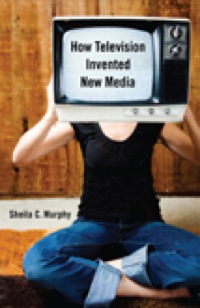 How Television Invented New Media by Sheila C. Murphy (Rutgers University Press)
How Television Invented New Media by Sheila C. Murphy (Rutgers University Press)
An assistant professor in the screen arts and cultures department at the University of Michigan describes how television provides key precedents and frameworks for understanding such devices of contemporary digital media as personal computers, video game systems, iPods, and other new media technologies. A near-universal frame of reference for viewers and media makers, television also created abstract concepts that have shaped newer media, she suggests.
n
Jane Campion: Authorship and Personal Cinema by Alistair Fox (Indiana University Press)
A professor of English and Director of the Centre for Research on National Identity at the University of Otago presents a study of the New Zealand director, and asks how she has used her films – their symbolism, techniques, and aesthetic strategies – as means to address traumas of her life, particularly a complex family background. He uses much new material, including interviews with Campion and her sister and personal writings of her mother, to trace the connections between the filmmaker’s complex background and the thematic preoccupations of her films. 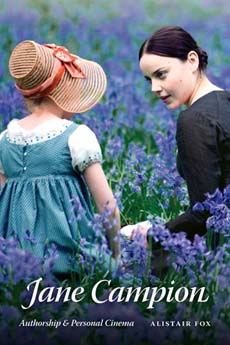
Alistair Fox describes his research
I found that most of the films were readily available on DVD, with invaluable commentaries by the director. Luckily, most of Campion’s earlier short films were also available as special features appended to her main films, on certain compilations. Her very first film, Tissues, however, appears not to be held in any archive.
For documentaries on Campion and her work, I needed to make use of the New Zealand Film Archive in Wellington. The Margaret Herrick Library at the Academy of Motion Picture Arts and Sciences also holds the screenplays of several of her films, and these are significant, because there are significant differences between the scripts and the eventual films.
For biographical information, I gathered material from a variety of sources. One important source was the Bibliothèque du Film in Paris, which holds dossiers of reviews of Campion’s films that appeared in French newspapers and journals, and which contain information that she has not made public in any other form. New Zealand newspapers provided another source of interviews, given not only by Jane, but also her sister Anna, and her father Richard Campion. In addition, a further extremely important source resides in the papers of Edith Campion, Jane’s mother, which are deposited in the Alexander Turnbull Library, Wellington. Much of this material is embargoed, but the catalogue alone contains important information about the circumstances of all family members. Other archives I looked at were the Hocken Library at the University of Otago, and the Australian National Film and Sound Archive in Canberra, both of which contain material on Campion.
Finally, I compiled information from books on other New Zealand figures, such as the theatre director Nola Millar, and the filmmaker John O’Shea, who were prominent in the circles in Wellington in which the Campions moved.
n
 Local History, Transnational Memory in the Romanian Holocaust edited by Valentina Glajar and Jeanine Teodorescu (Palgrave Macmillan)
Local History, Transnational Memory in the Romanian Holocaust edited by Valentina Glajar and Jeanine Teodorescu (Palgrave Macmillan)
Glajar, an associate professor of German at Texas State University at San Marcos (who previously co-edited “Gypsies” in European Literature and Culture and of Vampirettes, Wretches, and Amazons: Western Representations of East European Women) and Teodorescu, an assistant professor of French at Columbia College (Chicago), edited this volume of essays on the Romanian experience of the Holocaust as represented in literature, film, personal testimonies, and other media. The volume’s Romanian and Western authors say they seek to end an historical silence imposed by the Communist regime about Romania’s past of anti-Semitism, genocide, and violence, and to debunk the denials of the Holocaust in Romania. They contend that writers like Paul Celan, Aharon Applefeld, Elie Wiesel, and Norman Manea, artists, and film directors like Radu Mihaileanu and Radu Gabrea share not only a Romanian heritage but also a complicated relationship with Romania and intense preoccupation with the memory of the Holocaust.
n
 Shot in Oklahoma: A Century of Sooner State Cinema by John Wooley (University of Oklahoma Press)
Shot in Oklahoma: A Century of Sooner State Cinema by John Wooley (University of Oklahoma Press)
A former entertainment writer with the Tulsa World and author, co-author, or editor of more than 20 books traces the history of cinema in Oklahoma since 1904, when a Thomas Edison crew came from New Jersey to film cowboys and Indians on the 101 Ranch near Ponca City. Wooley describes films from early all-black movies shot in African-American communities and others with Native Americans as leads, through to mainstream blockbusters like Twister and cult movies like the Tulsa-shot Blood Cult, the first made-for-home-video feature. He interviews important figures in the state’s film history such as novelist S.E. Hinton, whose novel The Outsiders became a 1983 Francis Ford Coppola movie with then-young Tom Cruise and Matt Dillon, and he relates many you-are-there stories from newspaper accounts stretching baxck to the 1910s. Wooley provides backstories for many films, such as the one about how President Theodore Roosevelt’s fascination with a man purportedly able to catch a wolf in his hands led to The Wolf Hunt, shot in the Wichita Mountains and screened in the White House in 1909. The book includes a filmography of more than 100 productions filmed in the OK state.
John Wooley talks about archival issues relating to his book:
While many of the made-in-Oklahoma films, even the obscure ones, were relatively easy to find and purchase, some of the earlier ones were not. Of course, since they started around 1904, a lot are lost, but the Oklahoma Historical Society came through with viewings of a few key titles that were of enormous benefit to the book.
Two of those, both of which the Society has restored, are The Passing of the Oklahoma Outlaw and Daughter of Dawn. The first is a four-reeler made in 1915 by a U.S. Marshal named Bill Tilghman, mostly because he and his fellow lawmen were upset with a film spawned by one of their local outlaws, Al Jennings, called Beating Back.
The other is an all-Native American picture from 1920, with tinted scenes, that never got much of a release. The Society is currently having a full soundtrack recorded for it.
The OHS also has a copy of The Kidnappers Foil, which is a two-reel kid comedy an itinerant filmmaker named Melton Barker shot over and over again with different casts as he traveled through middle America. The Society print also features reminiscences from former children who played in the picture. It was fascinating and illuminating material.
One relatively recent movie that didn’t have an official DVD or VHS release at the time was Stark Fear, a 1962 psychological thriller made by Oklahoma filmmakers with a nice B-picture cast: Beverly Garland, Skip Homeier, and Kenneth Tobey. As it happened, the local PBS affiliate had given it a “world TV premiere” a few years back, and I’d had the foresight to tape it.
Finally, it took me a long time to run down a little picture shot in Tulsa called Just Between Us (1960), featuring a German shepherd named London who’d been in a couple of other features, notably 1958’s The Littlest Hobo. I found a newspaper photo spread on Just Between Us in the vertical files at Tulsa’s Central Library, which led me to a few contemporary Tulsa Tribune columns about it. But – since it apparently never got a release outside of Tulsa – I couldn’t find much of anything else. However, I contacted the son of the columnist who had originally written about it, and he remembered London and a publicity stunt held in conjunction with the Tulsa premiere, involving one of London’s sons parachuting from an airplane(!).
Armed with every scrap of information on the film I could find, I devoted one of my monthly Oklahoma Magazine columns to it – and the woman who’d starred in the picture as a little girl contacted me! She had a VHS copy, taken from the original 35mm print and given to her by the film’s backer. She was happy, if a bit puzzled, to see the movie talked about in print after a half-century, and I was delighted to be able to see it and write about it myself. You can bet I included plenty of reminiscing from its star.
n
The Media and the Models of Masculinity by Mark Moss (Lexington Books)
A Toronto writer and consultant discusses the impact that advertising, films, television shows, interior design, and other mass media have had on men’s ideas of identity, style, and deportment, fashionability, acceptability… Takes account of fashion, domestic space, sports, and other realms. Makes use of theories from sociology and media and cultural studies. n
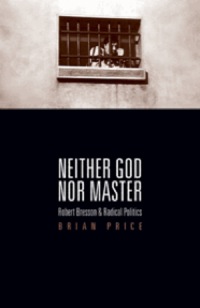 Neither God Nor Master: Robert Bresson and Radical Politics by Brian Price (University of Minnesota Press)
Neither God Nor Master: Robert Bresson and Radical Politics by Brian Price (University of Minnesota Press)
An associate professor of film and visual studies at the University of Toronto (and founding editor of World Picture, an online journal of critical theory), reassesses the French director as a radical political filmmaker whose classics – Diary of a Country Priest (1951), The Trial of Joan of Arc (1962), The Devil, Probably (1977), L’Argent (1983) – have long been considered as preoccupied with questions of grace and predestination with little interest in the problems of the social world. Rather than religious or spiritual, Price contends, Bresson’s films were steeped in radical, revolutionary politics. His early style modeled social resistance while those he made after May 1968 reflected on the failure of revolution in France. Price claims to raise philosophical questions about the efficacy of revolutionary practices and about untested metaphysical tendencies in film historical research.
Brian Price on Locating Bresson
The beginning of this project coincided with the wonderful Bresson retrospective that circulated in 1999, which I attended at MoMA in New York. The prints shown were wonderful. With one major exception–Four Nights of a Dreamer–there are good prints available. Four Nights of a Dreamer, which is a film that I really admire, has been out of circulation for some time. I’ve heard from a very trustworthy source that the problem does not lie with the Bresson estate, as many so often suggest, but with the terms of its production and exhibition rights. Hopefully this problem will sort itself out in time. There is a bad video of it which circulates and it is better than nothing. There are also, by now, very good DVDs of Bresson’s films and while I do prefer to see them projected, I don’t think that it’s the only way to see them or to study them. The major resource for me was the Bibliothèque du film (BIFI) in Paris. I can’t imagine a better place to do research on French cinema. I was really interested in looking at Bresson’s reputation in the popular press. I was also keen to look at how Bresson’s reputation was formed in Cahiers du cinéma. It was very instructive to go back through all of the back issues of the journal which featured any writing about Bresson. And of course BIFI has all of this, as well as tons of DVDs and video and they’re now right next door to the Cinémathèque française. One of the best research days I ever had involved spending the morning reading through back issues of Cahiers, running next door to see Duras’ Le camion, which was a real revelation, and then coming back to the library and carrying on. I can’t say that I have any good war stories about locating materials. Most of the people in possession of the material I needed to see were only ever eager to help. For instance, there’s an excellent young Bresson scholar named Colin Burnett, who sent me information about a photo that Bresson had taken in the 1930s that appeared in a Surrealist exhibition, which proved to be very important to my argument. This kind of generosity is rare. Scholars can be quite possessive and territorial.
n
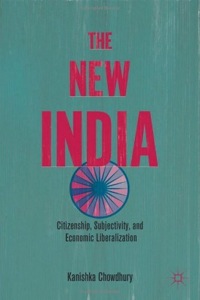 The New India: Citizenship, Subjectivity, and Economic Liberalization by Kanishka Chowdhury (Palgrave Macmillan)
The New India: Citizenship, Subjectivity, and Economic Liberalization by Kanishka Chowdhury (Palgrave Macmillan)
An associate professor of English at the University of St. Thomas (USA) draws on films, advertising, literature, and other sources in a study of the varied cultural constructions of the Indian citizen between 1991 and 2007, the period when economic liberalization became established government policy. In films, literary texts, corporate advertisements, political documents, and citizens’ responses to the privatization of public space, Chowdhury examines various images of citizenship and its rules and rituals to shed light on the complex interactions between culture and political economy in the New India.
n
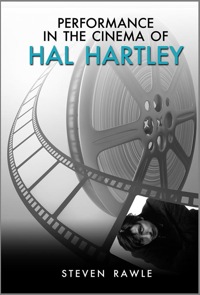 Performance in the Cinema of Hal Hartley by Steven Rawle (Cambria Press)
Performance in the Cinema of Hal Hartley by Steven Rawle (Cambria Press)
A lecturer in film studies at York St. John University presents the first full-length critical survey of the films of Hal Hartley, an American director who enjoyed prominence in the independent American cinema boom of the late 1980s and 1990s. Rawle focuses in particular on the aesthetic and thematic aspects of performance in the work as he analyzes such films as The Unbelievable Truth (1989), Trust (1990), Simple Men (1992), Amateur (1994), Flirt (1995), and Henry Fool (1998). Rawle notes that Hartley also has more recently experimented with digital video in The Book of Life (1999), The Girl from Monday (2005), and Fay Grim (2006), and has maintained a prolific output of experimental short films including Surviving Desire (1991), Ambition (1991), Theory of Achievement (1991), The New Math(s) (1999) and two collections of short works released under his Possible Films label (2006 & 2010). Over all, says Rawle, Hartley’s style – minimalist, abstract, and exhibiting an alienated mode of performance – exhibits concerns with stylization and self-conscious narration akin to films of the French nouvelle vague and the European arthouse tradition of Jean-Luc Godard, Robert Bresson, Chris Marker, and others. Among Hartley’s other distinctions, Rawle notes, is his persistent independence – he has never had an agent and has run his own production company for 20 years.
n
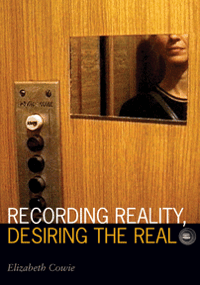 Recording Reality: Desiring the Real by Elizabeth Cowie (University of Minnesota Press)
Recording Reality: Desiring the Real by Elizabeth Cowie (University of Minnesota Press)
Explores the documentary film and its contemporary media forms to reveal its status as factual, story, art, and political. Cowie, a professor of film at the University of Kent, addresses the seeming paradox between the pleasures of spectacle in the documentary and its project of informing and educating, through which it creates a new understanding of spectatorship. In the Visible Evidence series.
n
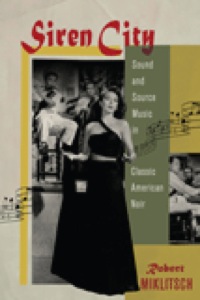 Siren City: Sound and Source Music in Classic American Noir by Robert Miklitsch (Rutgers University Press)
Siren City: Sound and Source Music in Classic American Noir by Robert Miklitsch (Rutgers University Press)
“Robert Miklitsch has convinced me,” says Krin Gabbard, author of Hotter Than That: The Trumpet, Jazz, and American Culture. “Sound and music in film noir are every bit as important as the visuals.” Miklitsch, a film and media studies at Ohio University, and the editor of Psycho-Marxism and the author of From Hegel to Madonna: Towards a General Economy of “Commodity Fetishism” and Roll Over Adorno: Critical Theory, Popular Culture, Audiovisual Media, argues that dramatic expressionist visuals are not film noir’s only distinctive traits. He considers a wide range of films noirs, celebrated and not, and proposes the notion of audiovisuality to investigate period sound technologies such as the radio and jukebox, phonograph and Dictaphone, popular American music such as “hot” black jazz, and “big numbers” featuring iconic performers such as Lauren Bacall, Veronica Lake, and Rita Hayworth, as well as a palette of distinctive sounds – gunshots, sirens, swing riffs, canaries… He contends that such elements have been given too little attention despite recent developments in studies of sound.
Robert Miklitsch on “The Chase” – his questfor films noirs
I’ve been teaching a class on film noir, “Kiss Me Deadly: Classic and Neo-Noir,” at Ohio University for over 15 years, so I was very excited when I finally embarked on writing a book about the genre. Siren City: Sound and Source Music in Classic American Noir confines itself to the 1940s, so the first issue for me was whether I would be able to view films from the period that were not available on DVD or, in some cases, VHS. (Seeing films in their original 35mm format was the exception, but a memorable event was watching Robert Siodmak’s wonderfully dolorous Christmas Holiday (1944) – at the height of the Christmas season no less – at the Wexner Center for the Arts located on the campus of The Ohio State University.)
In order to provide a “deep” or “thick” reading of 40s noir, I wanted to screen as many films from the period as possible, including and especially “B,” “obscure,” and/or “marginal” films such as Stuart Heisler’s Among the Living (1941) starring Albert Dekker as diametrically opposed brothers (one sane, one psychopathic); Arthur Ripley’s phantasmagorical, Cornell Woolrich-derived The Chase (1946); and Leslie Fenton’s Saigon (1948) starring that dynamic and iconic duo, Alan Ladd and Veronica Lake. (At this point, I hasten to add that “obscure” is a relative term; for some aficionados of the genre, noir is effectively defined not by “prestige” but “program” pictures: hence, the more obscure, the better.) My first resource for difficult-to-find films was a former undergraduate, then graduate student, Matt Gladman, a real film buff who over the years has compiled an extended library of titles from the 40s and 50s, including many noirs that were not available on DVD at the time I was writing. (A fount of noir trivia – man, am I glad I made Matt’s acquaintance!)
I then turned to other, obvious resources: the media library at Ohio University (a pretty good resource as we’ve had a School of Film for some time) and OhioLink (the electronic system that links all the college and university libraries in Ohio) as well as my local and city libraries. Although the Columbus Metropolitan Library was rated the best city library in the country in 2010 by the American Library Association, its noir holdings were, to my disappointment, limited; however, to my pleasant surprise, the Bexley Public Library possesses an excellent collection of classic noir DVDs. (When I inquired about this, I learned that one of the male librarians, who has since left to become a state trooper, was a fan of film noir.)
After exhausting what I took to be the usual suspects, I started searching on eBay for the noir titles I wasn’t able to locate via the above “venues.” I initially purchased DVDs from various sites, but the real find – a virtual treasure trove – was Bob Connors, who has amassed an astounding collection of Hollywood titles from the 1930s to the 1950s. If the bad news is that many were recorded from TV (with the usual poor visual or, more problematically for me, audio qualities), the very good news is that I was able to find virtually any and every film noir I had been searching for. Now, when I’m looking for a particular film (I’m currently writing a follow-up to Siren City), I just send Bob a list and it’s rare when he doesn’t have it. (Nota bene: at $4.00 per DVD plus mail, you can’t beat the price, although I always check out all the eBay purveyors on the chance I can access a VHS as opposed to TV-recorded copy.)
In the end, I managed to screen over 100 American film noirs from the 40s. While I was not able to write about each and every one, much as I wanted to (and such is my obsession with classic film noir, I very much wanted to), I felt confident in the belief that I possessed a thorough, working knowledge of the genre in its initial, classical phase. But I’d be lying if I claimed that that was the principal benefit, since the main thing for me was the sheer pleasure of watching and re-watching vintage noir. Still is.
n
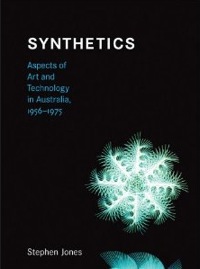 Synthetics: Aspects of Art and Technology in Australia, 1956-1975 by Stephen Jones (MIT Press)
Synthetics: Aspects of Art and Technology in Australia, 1956-1975 by Stephen Jones (MIT Press)
An Australian video artist and electronic engineer explores the “rolling new” in Australian art – the constant embrace of new technologies in making art –in art that used early digital and other technologies after years 1956, and that culminated in a landmark exhibition in 1975. He considers the role of computing technologies and video displays as they evolved into tools that artists could use, and examines reciprocal collaborations between artists and technologists. Jones notes that new technologies created opportunities but also imposed constraints – output and display technologies generated various possibilities, as did computer graphics, and then video art in the late 1960s and early 1970s. And since that time, based on electronic arts of that time that have received little attention outside Australia, new media art has boomed in the country, Jones says. Jill Scott, a media artist and professor for art and science research in the Institute of Cultural Studies in Art, Media, and Design at Zurich University of the Arts, calls the book “a seminal history for any artist who is currently working with technology.” Based on Jones’s thesis at the University of Technology, Sydney, in 2006.
n
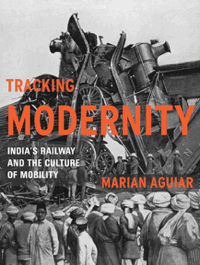 Tracking Modernity: India’s Railway and the Culture of Mobility by Marian Aguiar (University of Minnesota Press)
Tracking Modernity: India’s Railway and the Culture of Mobility by Marian Aguiar (University of Minnesota Press)
An associate professor of English at Carnegie Mellon University draws on literature, film, and other realms in what claims to be the first book to explore the role of the railway in the Indian imagination since colonial days – as a transformative technology, a rational utopia, a moving box in which racial and class differences might be amalgamated under a civic, secular, and public order. She views the ubiquitous railway as a symbol of the tensions of Indian modernity, from Gandhi’s nineteenth-century tour in a third-class compartment to the recent cinematic shenanigans of Wes Anderson’s The Darjeeling Limited. She studies the partition of India, labor relations, rituals of travel, works of literature and film, visual culture, and the Mumbai train bombings of 2006 to identify incongruities she terms “counternarratives of modernity” that present a microcosm of tensions within Indian modernity.
n
March 2011
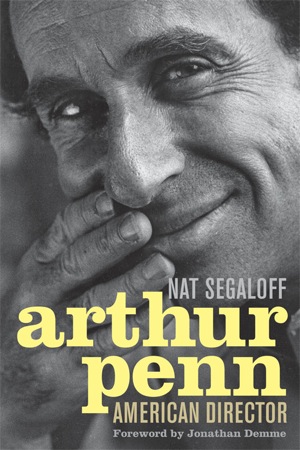 Arthur Penn: American Director, by Nat Segaloff (University Press of Kentucky)
Arthur Penn: American Director, by Nat Segaloff (University Press of Kentucky)
Segaloff presents the only full-length book about Penn, and the first sustained treatment of the director since Robin Wood’s short monograph of more than 40 years ago. The book was written with Penn’s participation. Segaloff is a writer, producer, teacher, and journalist. His writings have appeared in Film Comment, the Journal of the Producers Guild of America, and American Movie Classics Magazine. He is the author of Hurricane Billy: The Stormy Life and Films of William Friedkin and coauthor of Love Stories: Hollywood’s Most Romantic Movies. He lives in Los Angeles, California. His book about the influential filmmaker, who directed Bonnie and Clyde (1967), Alice’s Restaurant (1969), Little Big Man (1970), and Night Moves (1975), includes thematic chapters about Penn’s life and career, as well as pertinent events in the history of American film, theater, and television, and details of Penn’s interactions with Marlon Brando, Anne Bancroft, Warren Beatty, William Gibson, Lillian Hellman, and other actors.
n
n
The Blue Box: Kristevan/Lacanian Readings o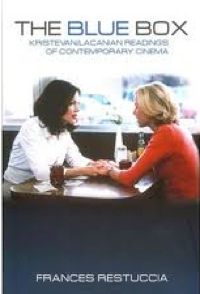 f Contemporary Cinema by Frances Restuccia (Continuum)
f Contemporary Cinema by Frances Restuccia (Continuum)
A scholar of literature and film (Amorous Acts: Lacanian Ethics in Modernism, Film, and Queer Theory) applies psychoanalytic theory in a study of several films that present elaborate fantasies and prompt the viewer to project private fantasies onto them, including Streitfeld’s Female Perversions, Lynch’s Mulholland Drive, Almodóvar’s Volver, and Haneke’s Caché. She argues for taking Julia Kristeva as an important film theorist.
n
The Filming of Modern Life: European Avant-Garde Film of the 1920s, by Malcolm Turvey (MIT Press)
The professor of film history at Sarah Lawrence College, editor of October, and author of Doubting Vision: Film and the Revelationist Tradition writes of the European avant-garde’s embrace of cinema in the 1920s. He examines such painters as Hans Richter and Fernand Leger and their collaborations with filmmakers from such movements as Dada and surrealism. He focuses on the nature and affiliations of five films from the avant-garde canon: Rhythm 21 (Hans Richter, 1921), Ballet mecanique (Dudley Murphy and Fernand Léger, 1924), Entr’acte (Francis Picabia and René Clair, 1924), Un chien Andalou (Salvador Dali and Luis Buñuel, 1929), and Man with a Movie Camera (Dziga Vertov, 1929). He explains their relations to the dislocations of modernization.
Malcolm Turvey, whose previous book Doubting Vision: Film and the Revelationist Tradition (Oxford University Press, 2008) argued that the film theories of Jean Epstein, Dziga Vertov, Béla Balázs, and Siegfried Kracauer constituted a tradition – revelationism – distinct from modernism and realism, will spend academic 2011-12 as a fellow at The Stanford Humanities Center at Stanford University researching and writing another book, Play Time: Jacques Tati and Comedic Modernism, which looks like being the first book about the films of Jacques Tati (1907-1982) by an English-language scholar in over 25 years. It will analyze Tati’s aesthetic as a response to then-modern life and focus on Tati’s innovative synthesis of his modernist aesthetic and comedian comedy.
Turvey, who is an editor of MIT Press’s quarterly arts journal October, is also working with NYU’s Richard Allen on a book about “film and mind,” examining the tradition of theorizing about their relations. According to a Sarah Lawrence College statement, Turvey and Allen “excavate this tradition and point out its flaws, such as the loose nature of the analogies that are drawn between film and mental phenomena.” They also try “to clarify certain core psychological concepts in film theory, drawing on the ordinary-language philosophical tradition of Wittgenstein, Austin, and Ryle. They define terms such as ‘imagination,’ ‘see,’ and ‘think’ – concepts which most film theorists misunderstand and misuse.”
n
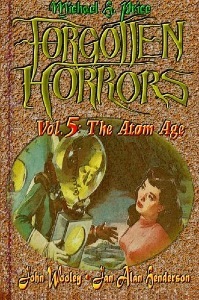 Forgotten Horrors Vol. 5: The Atom Age, by Michael H. Price, John Wooley, and Jan Alan Henderson (CreateSpace)
Forgotten Horrors Vol. 5: The Atom Age, by Michael H. Price, John Wooley, and Jan Alan Henderson (CreateSpace)
Price, a movie historian and special-effects/storyboard artisan, began the Forgotten Horrors film-book series in 1979 with George E. Turner (1925-1999) to recognize the indie-studio thrillers of the Depression years – horror, sci-fiF, film noir, and unclassifiable oddities. Its fifth volume covers the WWII and postwar years, and the off-Hollywood rise of science fiction during 1949-1954. To tackle the most conflicted and paranoid period of American cultural history, Price is joined by genre historians John Wooley, biographer of horror-filmmaker Wes Craven (who in March 2009 – see below – published a biography of Craven), and Jan Alan Henderson, biographer of the special-effects pioneers Howard and Theodore Lydecker. This installment focuses, as always, on small-budget productions, and includes fresh responses to such breakthrough films as Mikel Conrad’s The Flying Saucer, the oddly matched set of George Pal’s Destination Moon and Kurt Neumann’s Rocketship X-M, Edgar G. Ulmer’s The Man from Planet X, Ivan Tors’ Office of Scientific Investigation trilogy, William Cameron Menzies’ Invaders from Mars, E.A. Dupont’s The Neanderthal Man, William Castle’s exploitation-film debut It’s a Small World, and Skipalong Rosenbloom. Wooley says on his website that “it’s 300-plus pages of the good, the bad, and the exceedingly strange, bound together by Michael’s insight, wit, and intriguingly skewed vision.”
n
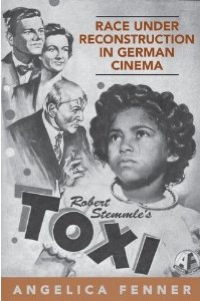 Race under Reconstruction in German Cinema: Robert Stemmle’s Toxi, by Angelica Fenner (University of Toronto Press)
Race under Reconstruction in German Cinema: Robert Stemmle’s Toxi, by Angelica Fenner (University of Toronto Press)
An associate professor of cinema studies and German at the University of Toronto investigates postwar racial formations via a pivotal West German film, Robert Stemmle’s Toxi (1952). The film, which coincided with the enrolment in West German schools of the first five hundred Afro-German children fathered by black American occupation soldiers, didactically traced conflicts among members of a patrician family when they encounter an Afro-German child seeking adoption. It broached issues of integration at a time when the American civil rights movement was gaining momentum. Fenner shows how perceptions of blackness in the film, which was made at a time of economic and political anxieties, class antagonism, and the reinstatement of conventional gender roles, reflected those of Wilhelmine Germany (the period running from the proclamation of Wilhelm I as Kaiser in 1871 to the abdication of his grandson Wilhelm II in 1918) but also revealed the influence of American popular culture – of Uncle Tom’s Cabin, Birth of a Nation, and even Shirley Temple films.
n
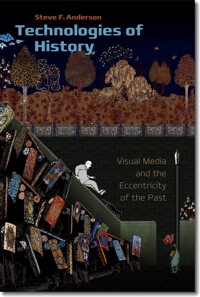 Technologies of History: Visual Media and the Eccentricity of the Past by Steve F. Anderson (Dartmouth College Press/University Press of New England)
Technologies of History: Visual Media and the Eccentricity of the Past by Steve F. Anderson (Dartmouth College Press/University Press of New England)
The director of the PhD program in media arts and practice at the University of Southern California School of Cinematic Arts, who co-edits Vectors: Journal of Culture and Technology in a Dynamic Vernacular, explores the way that history has come to be constructed through such visual media as television, experimental film, and video games. He emphasizes alternate and fantastic histories, including Star Trek time-travel episodes, fake documentaries, films created from home movies and found footage, video games about cultural traumas such as the siege at Waco and the assassination of President John F. Kennedy, and also expressions of the modernist avant-garde. All, he suggests, hold a powerful sway over how history has come to be recorded. He argues that history as it is presented and conceived in these films, on TV programs, in video games, and online suggests the limitations of formal history, and offers alternative ways of relating it. (In the series Interfaces: Studies in Visual Culture.)
n
To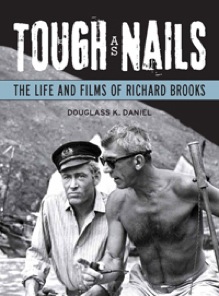 ugh as Nails: The Life and Films of Richard Brooks by Douglass K. Daniel (University of Wisconsin Press)
ugh as Nails: The Life and Films of Richard Brooks by Douglass K. Daniel (University of Wisconsin Press)
A study of the American eight-Oscar-winning screenwriter and director Richard Brooks (1912-92), a prickly iconoclast called “God’s angry man” for his unyielding demands in pursuit of personal and artistic freedom, and whose films included Blackboard Jungle, Cat on a Hot Tin Roof, Elmer Gantry, In Cold Blood, and Looking for Mr. Goodbar. Daniel, a writer and editor with the Associated Press and author of Harry Reasoner: A Life in the News and Lou Grant: The Making of TV’s Top Newspaper Drama, explores how the writer-director made it from the slums of Philadelphia to the Hollywood elite working with the top stars of the day including Humphrey Bogart, Cary Grant, Elizabeth Taylor, Jean Simmons (his wife of 20 years), Sidney Poitier, Sean Connery, Gene Hackman, and Diane Keaton by dramatizing social issues and depicting characters in conflict with their own values. Daniel draws on unpublished studio memos and documents and interviews from stars and colleagues to shed light on Brooks’s major films. (In the series Wisconsin Film Studies.)
n
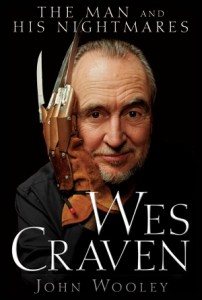 Wes Craven: The Man and His Nightmares, by John Wooley (John Wiley & Sons)
Wes Craven: The Man and His Nightmares, by John Wooley (John Wiley & Sons)
Wooley, who calls himself “a fan of Craven even before he optioned (but, unfortunately, never filmed) my novel Old Fears, which Ron Wolfe and I co-wrote back in the early ’80s,” says issues relating to Craven’s films have been kicking around in his head for decades – “ideas having to do with the connections between art and exploitation, for instance, as well as what youthful exposure to the concept of an endless, burning hell full of tortured souls might have on a writer or filmmaker.” His exhaustive research with colleague Rachelle Vaughan extended to a lengthy interview with the filmmaker that revealed little-known details about the director’s life and work. Wooley explains how Craven came to be one of the most successful and iconic horror movie directors in Hollywood – his Scream series is the most successful horror franchise of all time – by forging a nightmarish nexus of dreams and reality. During his 40-year career, Craven has mixed horror, sex, and humor to revitalize the slasher film genre.
John Wooley describes his research:
It was not difficult to find all the movies I needed for A Man and His Nightmares. Although I often moan about how the Internet has robbed us of much of the thrill of anticipation and the arduous but fulfilling work of research, it sure comes in handy when you’re trying to find films. I didn’t even have trouble locating a marginal title like Confessions of a Blue Movie Star, a weird little patchwork job that allegedly included Craven’s participation. (In fact, it simply featured a few seconds of gore footage from Last House on the Left, passed off as “real.”) I could only get it on VHS, but that was certainly no hardship.
I would’ve loved to have seen the student film, The Searchers, which Craven was associated with during his time as a professor at Clarkson College in the late ’60s, but I didn’t have a clue about how to find it. To hear Craven tell it, the administration wasn’t all that delighted about it, so it likely wasn’t preserved at the school, and its makers have been scattered for decades.
n
February 2011
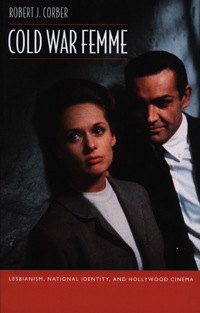 Cold War Femme: Lesbianism, National Identity, and Hollywood Cinema by Robert J. Corber (Duke University Press)
Cold War Femme: Lesbianism, National Identity, and Hollywood Cinema by Robert J. Corber (Duke University Press)
The director of the Women, Gender, and Sexuality Program at Trinity College considers how cold-war-inflected homophobia – particularly in relation to “the femme” as invisible threat – in 1950s and 1960s Hollywood movies like All About Eve, The Children’s Hour, and Marnie influenced American ideas about lesbianism. He argues that fear that college-educated women would weaken the nation by rejecting marriage and motherhood. Before that time, he says, homophobia had focused on notions of masculinity in lesbians, but during the Cold War, lesbians came to be viewed as women attracted to other women. Corber – the author of Homosexuality in Cold War America: Resistance and the Crisis of Masculinity and In the Name of National Security: Hitchcock, Homophobia, and the Political Construction of Gender in Postwar America (both Duke University Press) – develops these observations with reference to influence of homophobia on the careers of stars like Joan Crawford, Bette Davis, and Doris Day.
n
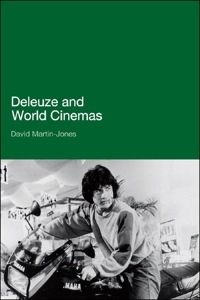 Deleuze and World Cinemas: Transworld Cinema/Transworld Deleuze, by David Martin-Jones (Continuum)
Deleuze and World Cinemas: Transworld Cinema/Transworld Deleuze, by David Martin-Jones (Continuum)
Part of the controversy surrounding the philosopher’s writings on cinema stems from their Eurocentricism. Martin-Jones, a lecturer in film studies at the University of St Andrews, UK, the author of Deleuze, Cinema and National Identity (EUP, 2006), Scotland: Global Cinema (EUP, 2009), and Deleuze Reframed (I.B. Taurus, 2008), contends that Deleuze’s writing offers radical ways of understanding cinema, but gauges his theories’ relevance to films he did not discuss – films from Europe and the USA, Bollywood blockbusters, Hong Kong action movies, Argentine melodramas, South Korean science fiction movies. He argues for adaptation and reinterpretation of Deleuze’s writing to ensure its continued relevance for such issues as cinema’s contemporary engagement with the aftermath of the Cold War and the global dominance of neoliberal globalization.
v
Latino Los Angeles in Film and Fiction: The Cultural Production of Social Anxiety by Ignacio Lopez-Calvo (University of Arizona Press)
A professor of Latin American literature at the University of California at Merced writes about depictions of marginalized Latino youth by LA-based Latino authors and filmmakers – about Latino lives within the city, and their social relations and anxieties, repressed rage, and deep racial guilt.
n
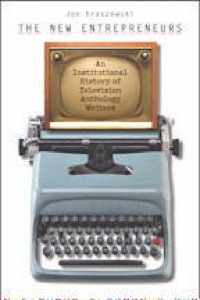 The New Entrepreneurs: An Institutional History of Television Anthology Writers by Jon Kraszewski (Wesleyan University Press, distributed by University Press of New England)
The New Entrepreneurs: An Institutional History of Television Anthology Writers by Jon Kraszewski (Wesleyan University Press, distributed by University Press of New England)
An assistant professor of communication at Seton Hall University studies the cultural control of television in the 1950s. He discusses the ways that writers of television anthology programs including Paddy Chayefsky, Reginald Rose, and Rod Serling achieved unusual artistic (and political) freedom over the constraints and censorship of 1950s corporate culture. By analyzing both well-known and little-considered tv anthology scripts, Kraszewski shows that the writers worked as “new entrepreneurs,” adapting their scripts for Hollywood, Broadway, and book publishing at a time when relations among television, theater, and art cinema in New York art culture were taking shape.
n
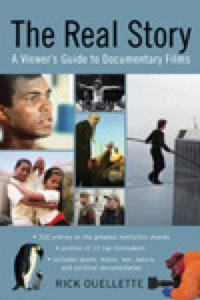 The Real Story: A Viewer’s Guide to Documentary Films, by Rick Ouellette (Chicago Review Press)
The Real Story: A Viewer’s Guide to Documentary Films, by Rick Ouellette (Chicago Review Press)
A free-lance photographer, videographer, and producer of three television documentaries who also has reviewed books and films for Boston Phoenix, Video Eyeball, and Kapital Ink argues that the golden age of documentaries is upon us. They are widely viewed in cinemas, or via video and specialty cable channels. His aim in his book is to provide a general guide to documentaries. He examines 300 of the world’s most notable examples, beginning with the Lumière Brothers’ Arrival of a Train of 1895 to a Disney nature film that uses the latest digital technology.
n
January 2011
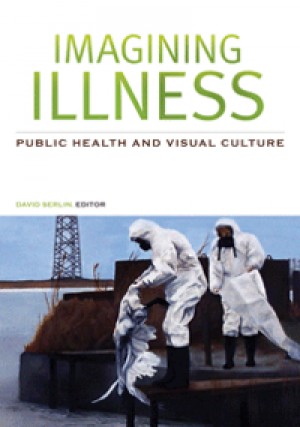 Imagining Illness: Public Health and Visual Culture, edited by David Serlin (University of Minnesota Press)
Imagining Illness: Public Health and Visual Culture, edited by David Serlin (University of Minnesota Press)
An associate professor of communication and science studies at the University of California, San Diego, collects essays that consider the visual culture of public health from seventeenth-century London broadsides about the handling of plague victims’ bodies, to YouTube videos about preventing the transmission of STDs. Contributors examine such historical and contemporary visual practices as Chinese health fairs, documentary films produced by the World Health Organization, illness maps, fashions for nurses, and live surgery on the Internet.
David Serlin describes the archival work of the book’s contributors
Imagining Illness came about as a result of the frustration experienced by me and some of my colleagues at the National Library of Medicine – in particular, Elizabeth Fee, the chief of the NLM’s History of Medicine Division, and Paul Theerman, the NLM’s head of Images and Archives – when I held a research position there in the early 2000s. We regularly discussed how disappointed we were by the ways in which conventional historians of medicine and public-health scholars were ignoring the rich visual materials found, often languishing, in medicine- and science-based archival collections such as those of the NLM. Public health, as a subset of history of medicine, has traditionally been a text-driven discipline; and when visual materials are used at all, they are used more often than not to illustrate historical arguments rather than as interesting historical artifacts in and of themselves. Furthermore, many of the methodological and theoretical innovations associated with visual materials, such as those nourished by scholarship in cinema studies, media studies, and so forth, were virtually nonexistent in public health circles. In most cases, the power of the written word (and the institutional authority it wields) still continues to trump even the most powerful visual rhetoric and simply reduces an illustration, photograph, or engraving to the status of visual curiosity rather than recognizing it as a legitimate historical source.
Elizabeth, Paul, and I believed that it was possible to stage a methodological as well as pedagogical intervention that would highlight the vitality of archival materials for public-health scholars and activists as well as create models for analyzing and interpreting those materials. So with the financial support of the National Institutes of Health and private donors to the NLM, we chose and invited scholars from across the humanities and social sciences to conduct research using visual materials from the NLM’s History of Medicine collections as well as in its Image and Archives collections. We invited scholars whose work engaged with visual media, deliberately choosing both those with credentials in public-health scholarship and specialists in fields such as geography, anthropology, art history, and American studies that had never before worked on topics in public health or history of medicine. Scholars were asked to develop research projects that would bring to light the NLM’s archival holdings but were also encouraged to use the vast resources located in the Washington D.C. area, such as the Library of Congress or the National Archives. The result of their labor was featured at two large international symposia at the NLM that we organized: “The Visual Culture of Public Health” (November 2003) and “Global Health Histories” (October 2005).
Since the NLM is the largest medical library in the world with collections spanning thousands of years of medical history, it was not difficult for invited scholars to find interesting visual archival materials, including many that had never been analyzed before and even many that had not been seen since they were first created. Mark Monmonier, for example, an expert on geography and cartography at Syracuse University and the author of How to Lie with Maps, combed through the Images and Archives collections for maps documenting public-health crises as well as campaigns for charting illness. Many of these were created by military organizations and census bureaus and deposited as artifacts of government public-health intervention during the Cold War and had never been examined before. Meanwhile, Liping Bu, a historian of medicine at Alma College in Michigan, found a magnificent collection of Chinese public health posters from the 1920s used to promote personal hygiene and cleanliness at home. Like the archival materials Monmonier found, they had been donated years ago waiting for translation and interpretation.
Many of the invited scholars chose to use conventional published materials but examine their contents in unconventional ways. Katherine Ott, a curator of medical science at the Smithsonian’s National Museum of American History, looked at the NLM’s collection of dermatological atlases — large-format books produced in the eighteenth and nineteenth centuries to help physicians identify diseases of the skin. While most historians have used the atlas texts to discuss disease etiology or those who developed treatments, Ott chose instead to focus on the images themselves — stunningly beautiful engravings, etchings, and hand-tinted color prints of some of the most grotesque skin conditions imaginable. Such atlases provide a wealth of information for both historians of medical science as well as those interested in alternatives to conventional (and typically idealized) representations of the human body. Lenore Manderson, an anthropologist at Monash University in Australia, found a remarkable cachet of images in the manuscript collection of Wilbur Augustus Sawyer, a public-health administrator involved in campaigns to eliminate hookworm who was also an amateur documentary photographer. For anyone interested in the visual record of building outhouses and digging latrines in early-twentieth-century Australia and the Pacific Rim, the hidden gems in the Sawyer collection is an embarrassment of riches.
One of the NLM’s more remarkable archival holdings is in its abundant collection of films related to the history of medicine — from visual documentation of laboratory science to films following health campaigns (such as, for but one example, extensive footage of children in the late 1950s being inoculated with Jonas Salk’s polio vaccine) to public-service announcements (PSAs) from the 1920s onward about the civic dangers of smoking, alcohol, malnutrition, overpopulation, and poor bodily hygiene, and even recent films about the threat of bioterrorism from the 1980s and 1990s. Gregg Mitman, a historian of science at the University of Wisconsin at Madison, found superb films documenting the work of the March of Dimes as well as film footage of impoverished African Americans suffering from tuberculosis in rural America.
Like some of the films famously found in collections such as those of Rick Prelinger, many capture health fears of the other in their most spectacular Cold War iterations. Kirsten Ostherr, for example, a cinema and media scholar at Rice University, found numerous films produced by the World Health Organization in the 1950s that unabashedly depict white doctors asserting their authority, and superiority, over black African patients while invested benignly in the “objective” pursuit of medical science. Such images may preserve evidence of mid-twentieth-century racism and colonialism, but they are also time capsules that prove that the recognizable formalistic elements that constitute the documentary, particularly the PSA, have been around for almost a century.
I am proud of the amazing archival materials brought to light by the authors of Imagining Illness, but I am also proud to have created a work that, I think, opens up many possibilities for those interested in the visual culture of public health as well as the methodological approaches that an emphasis on the visual archive helps to encourage.
Spain on Screen: Developments in Contemporary Spanish Cinema edited by Ann Davies (Palgrave Macmillan)
A senior lecturer in Spanish at Newcastle University, UK (Carmen on Film: A Cultural History, 2007; Daniel Calparsoro, 2009) edited this collection of essays by leading scholars of Spanish film on such topics as controversy over the provisions for film funding in the Cinema Act of 2007, the role of short films in Spanish cinema, and the contrasting approaches of two “biopics” of St. Teresa of Avila. Also discussed are such issues as genre, auteurism, stardom, the relationship between film and TV, the horror genre as voice of conservatism, and recuperation through documentaries of memories of the Civil War.


